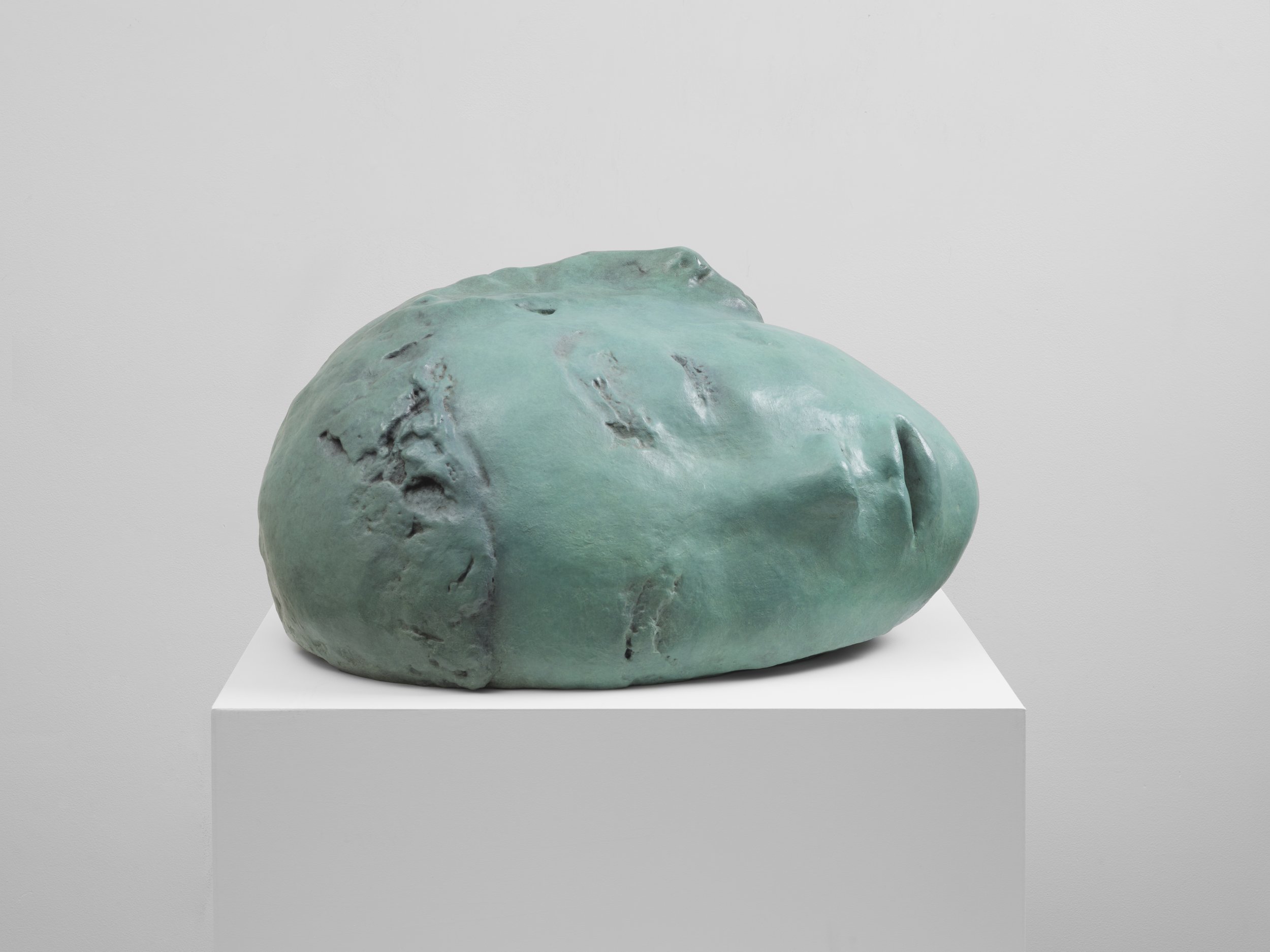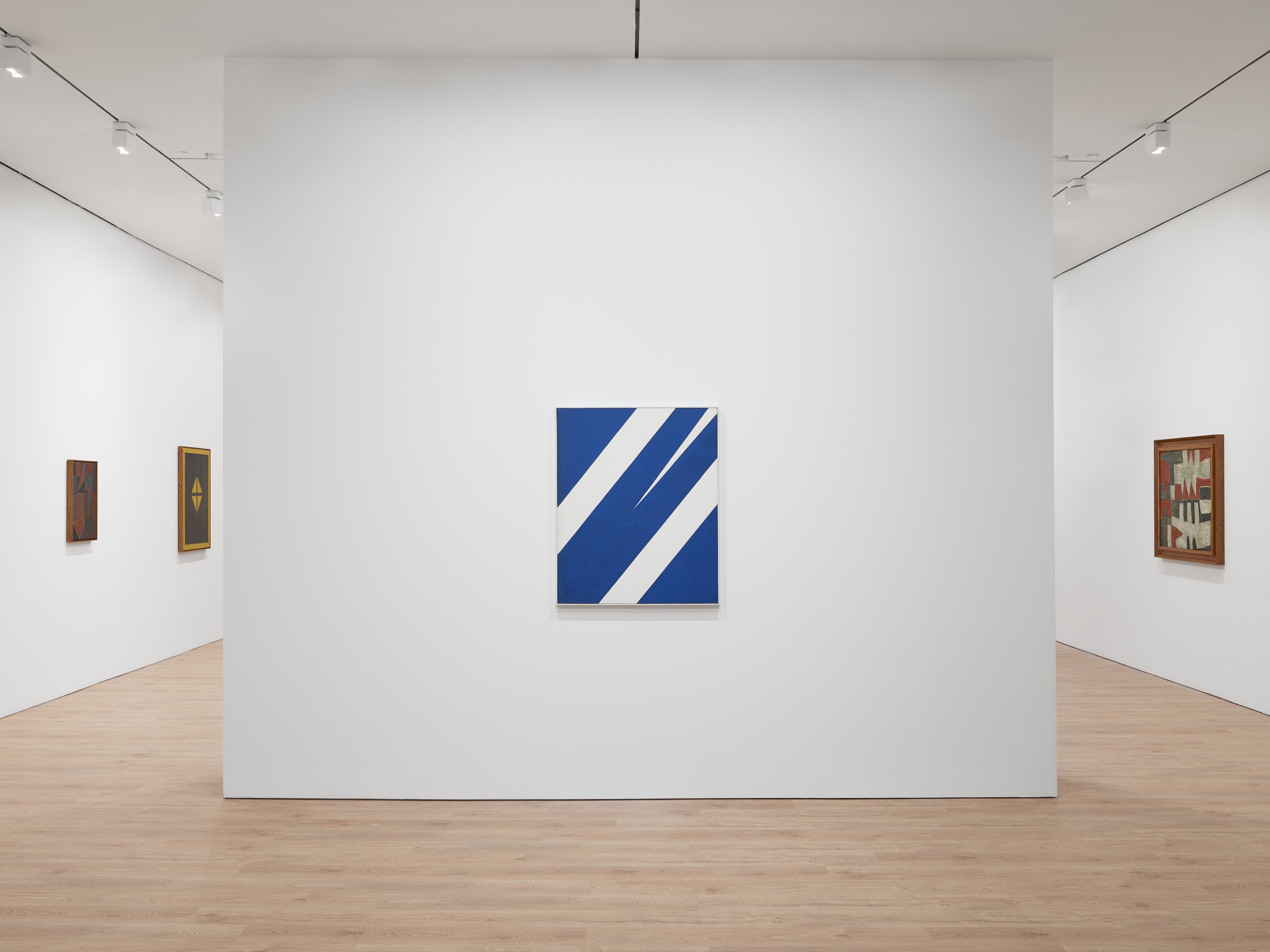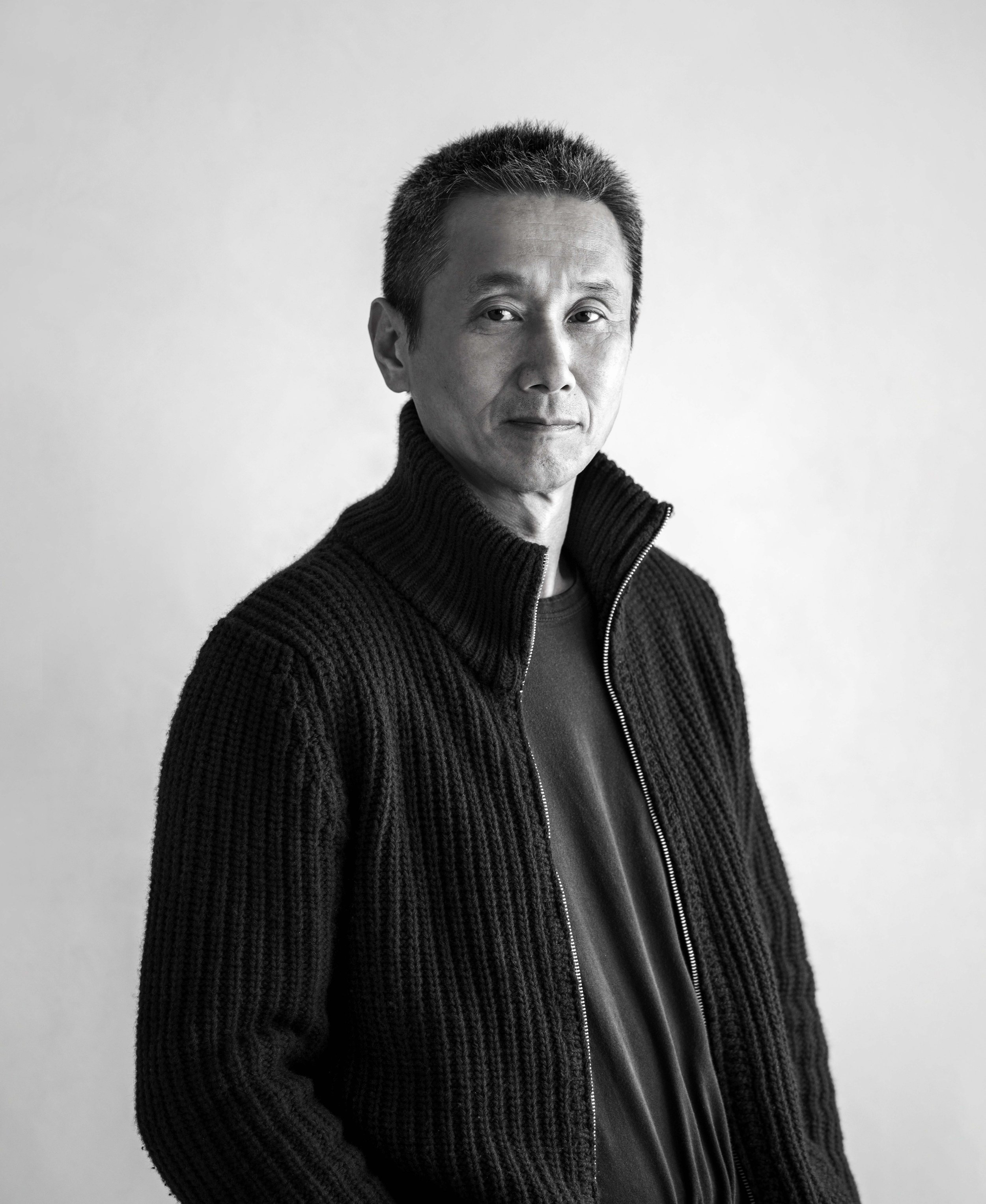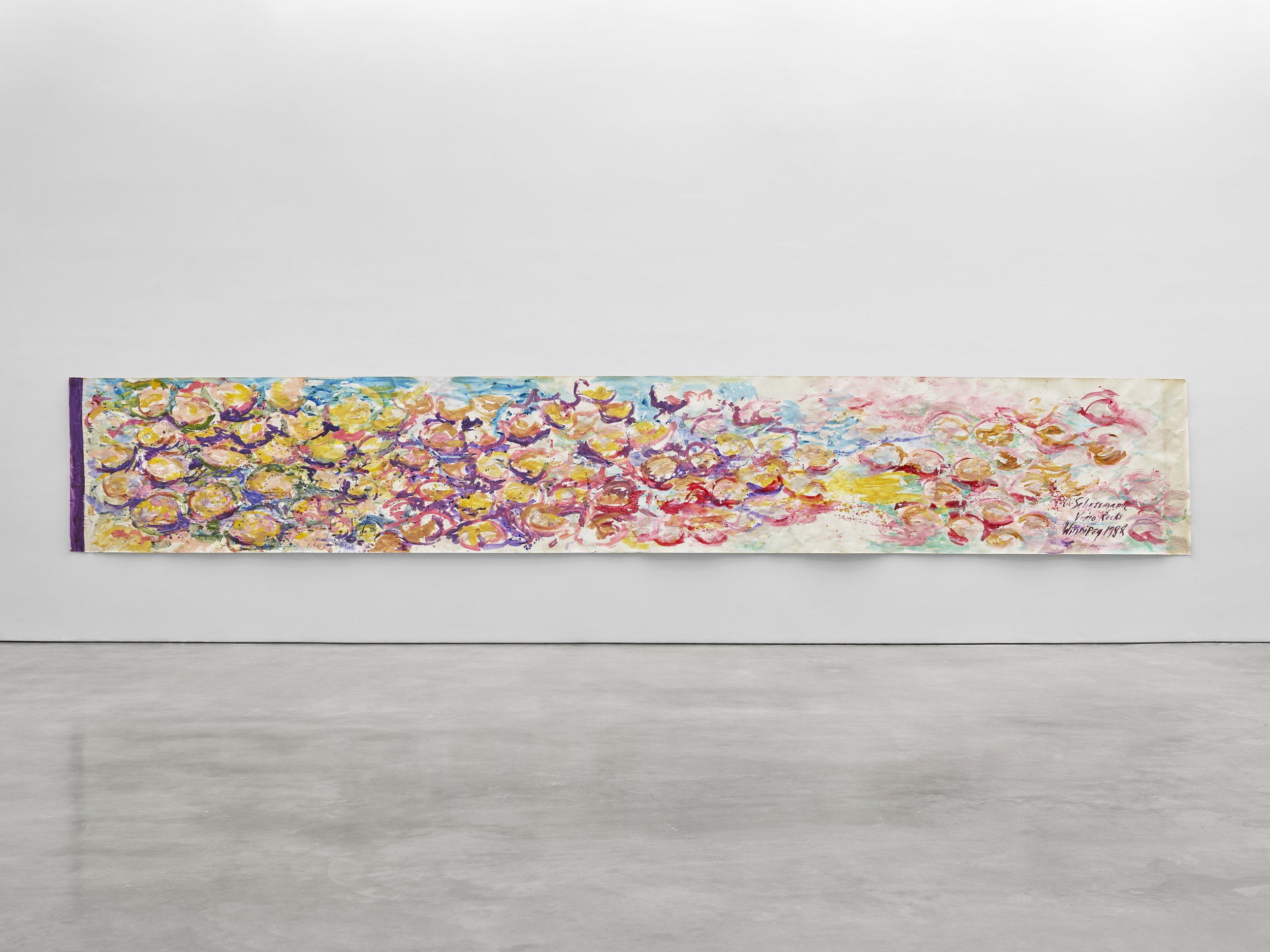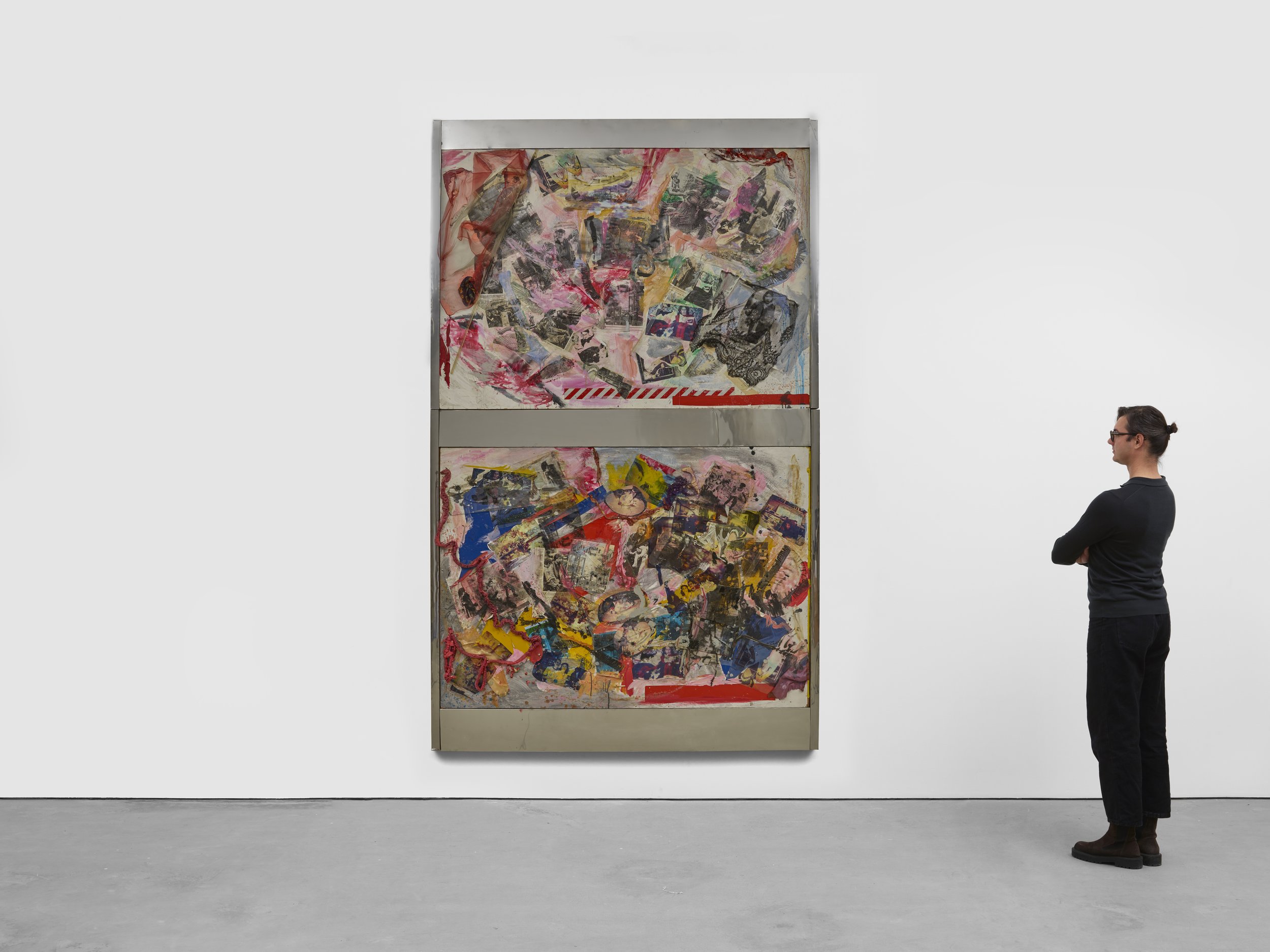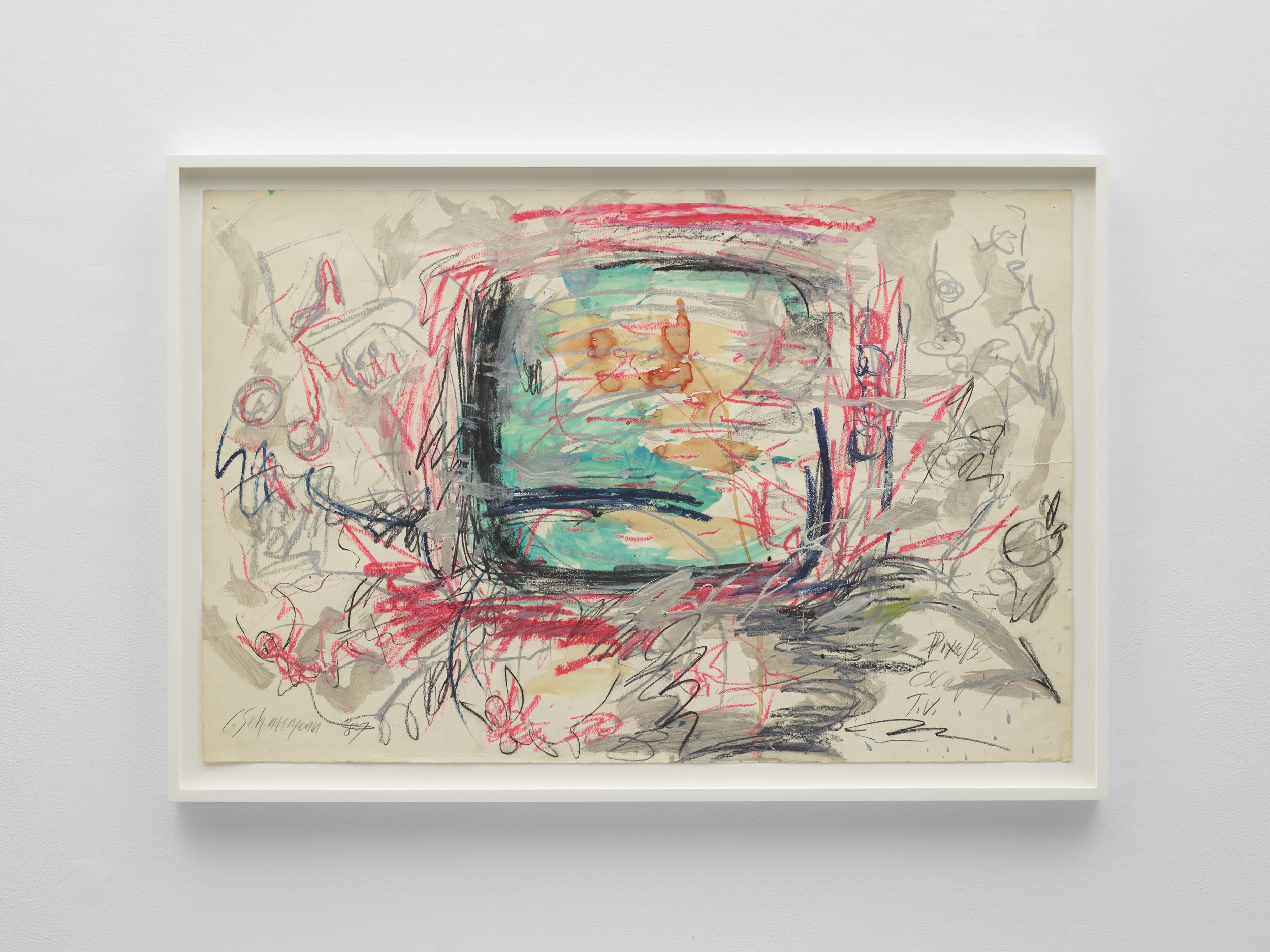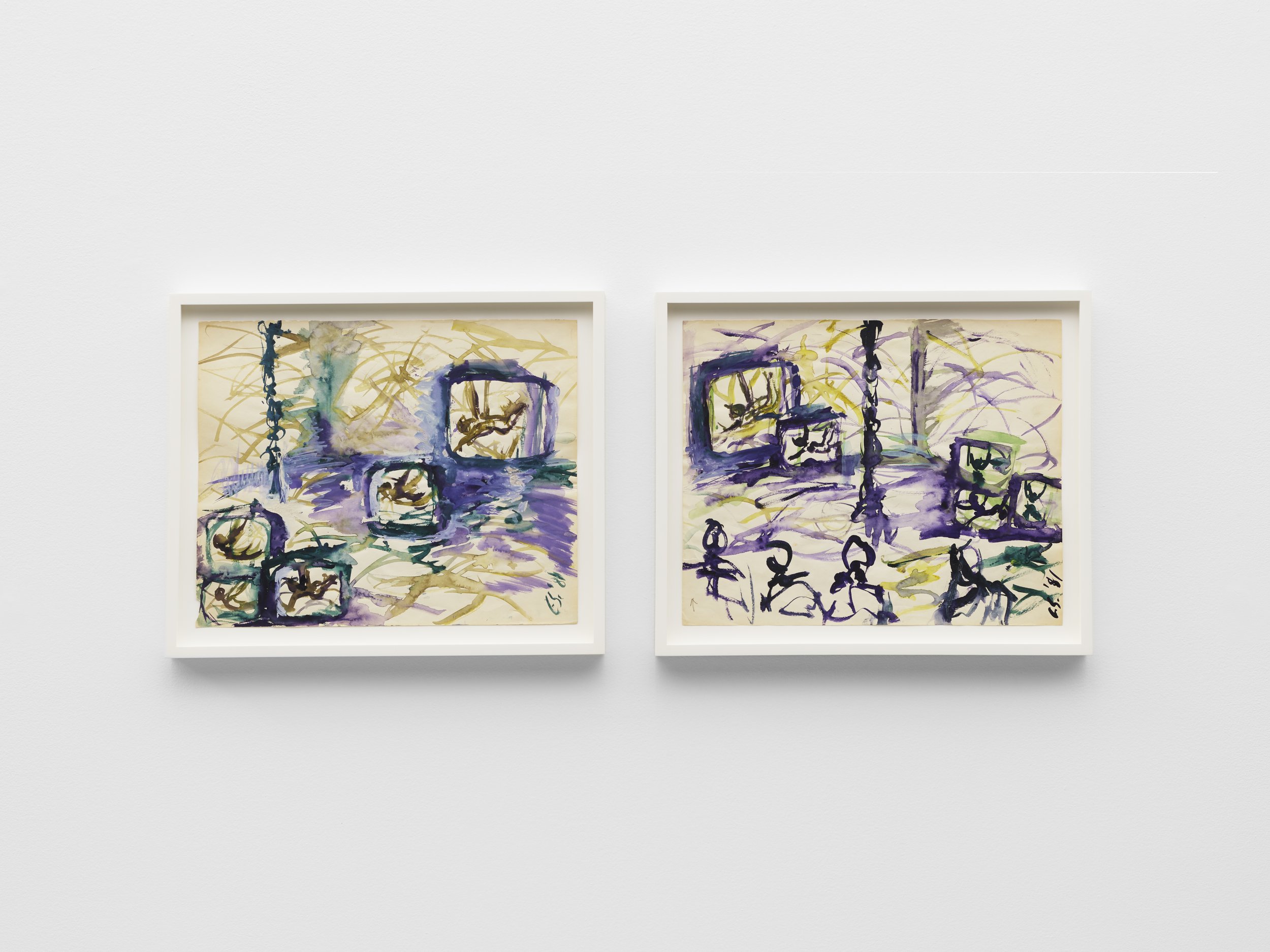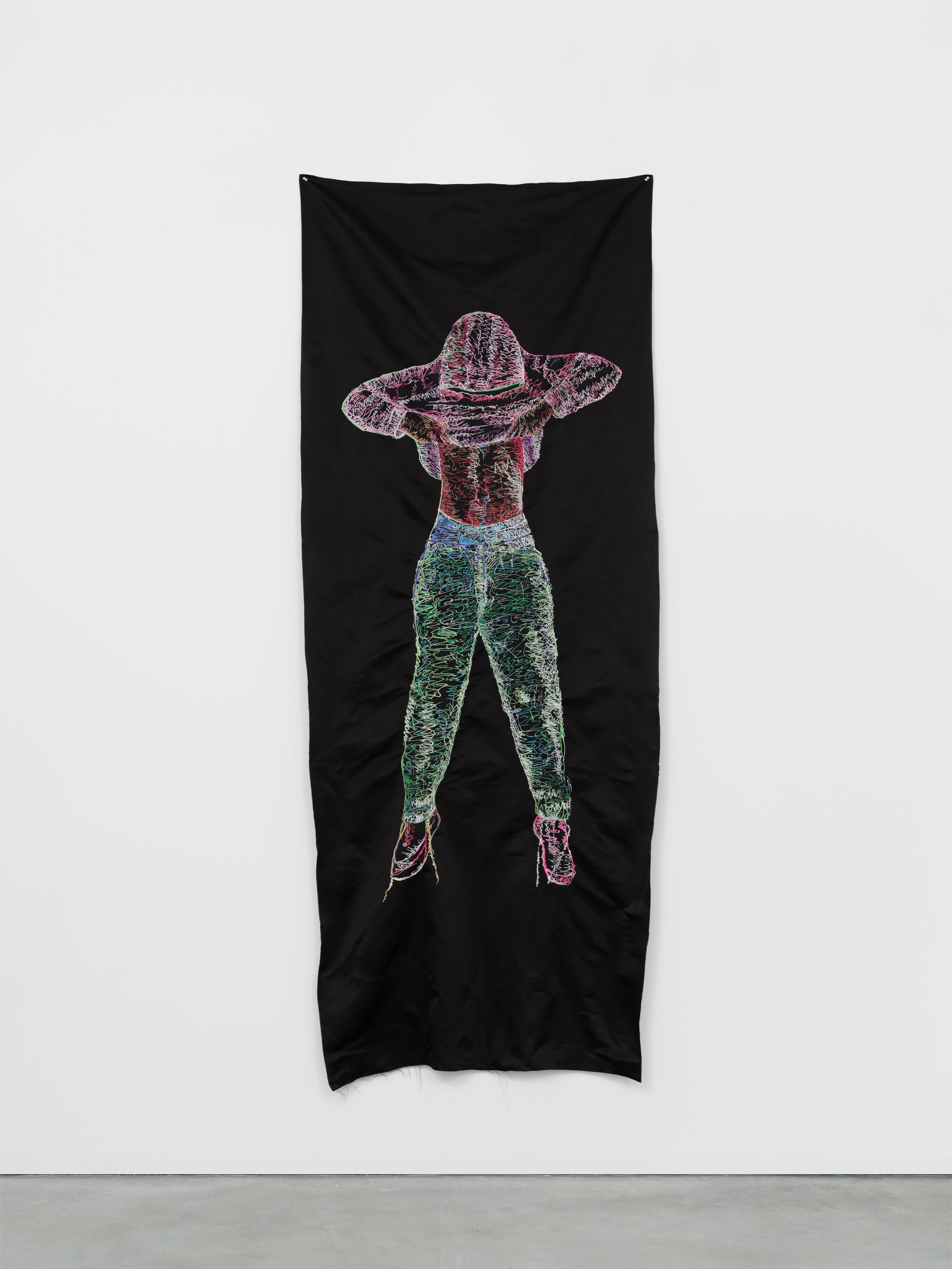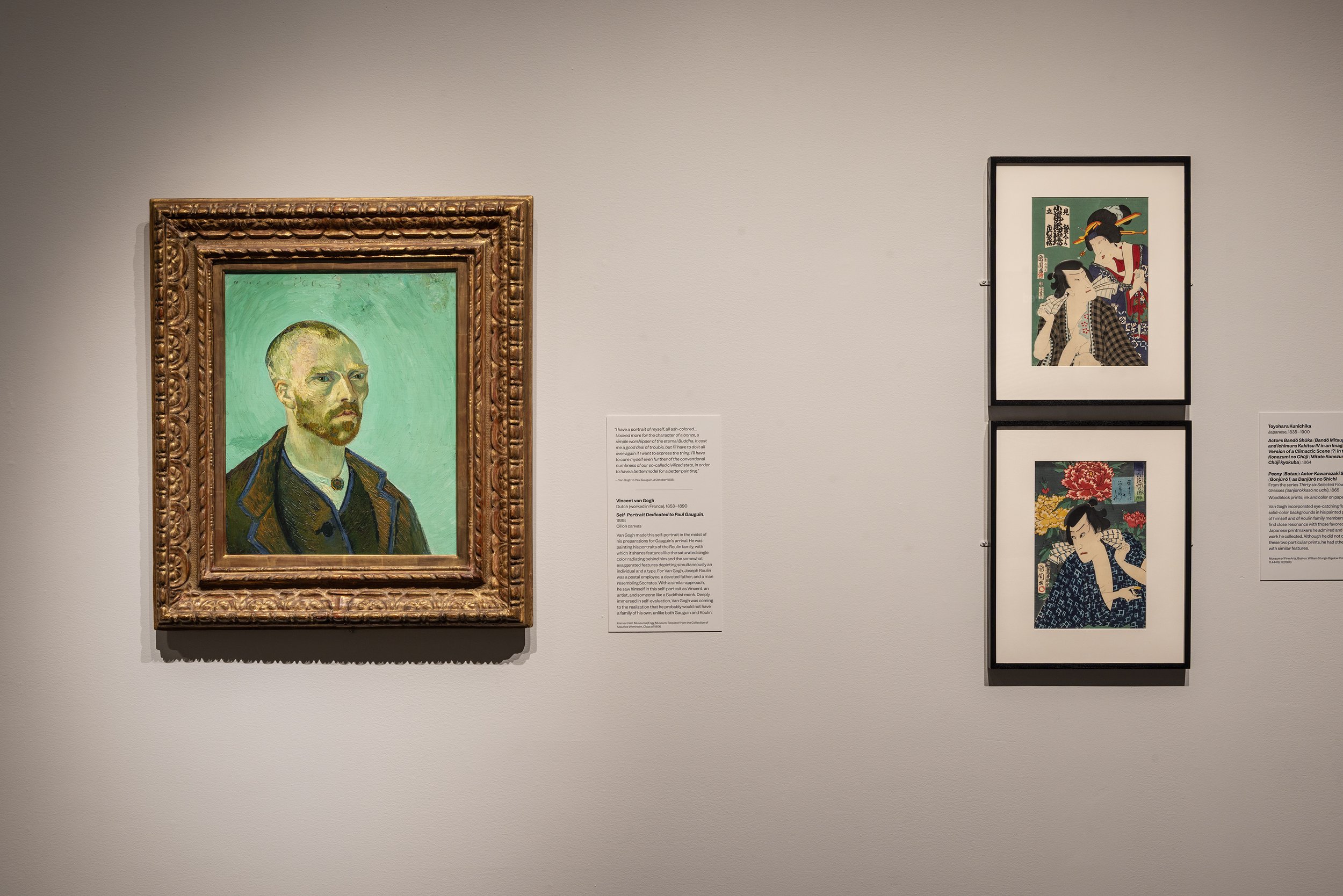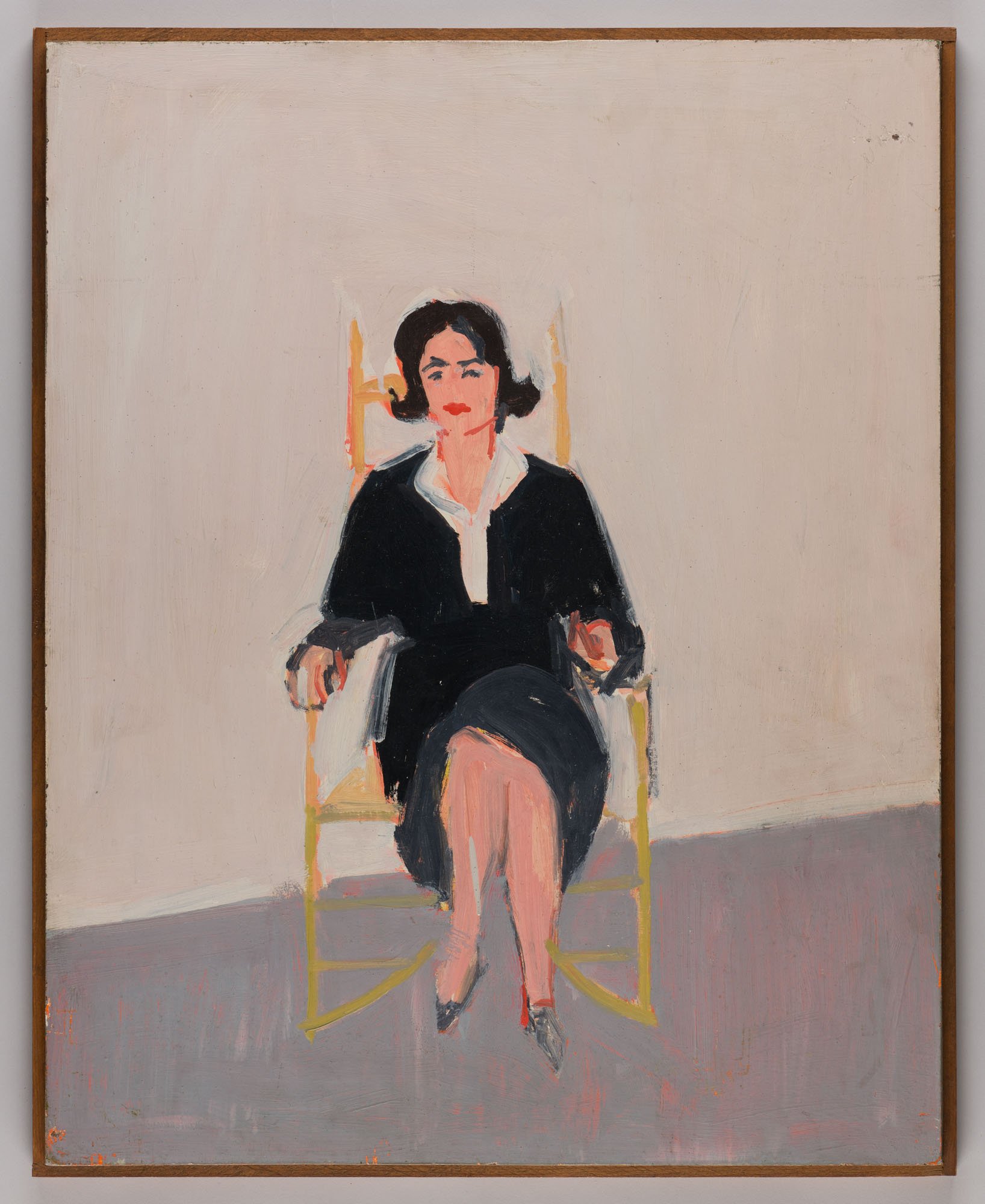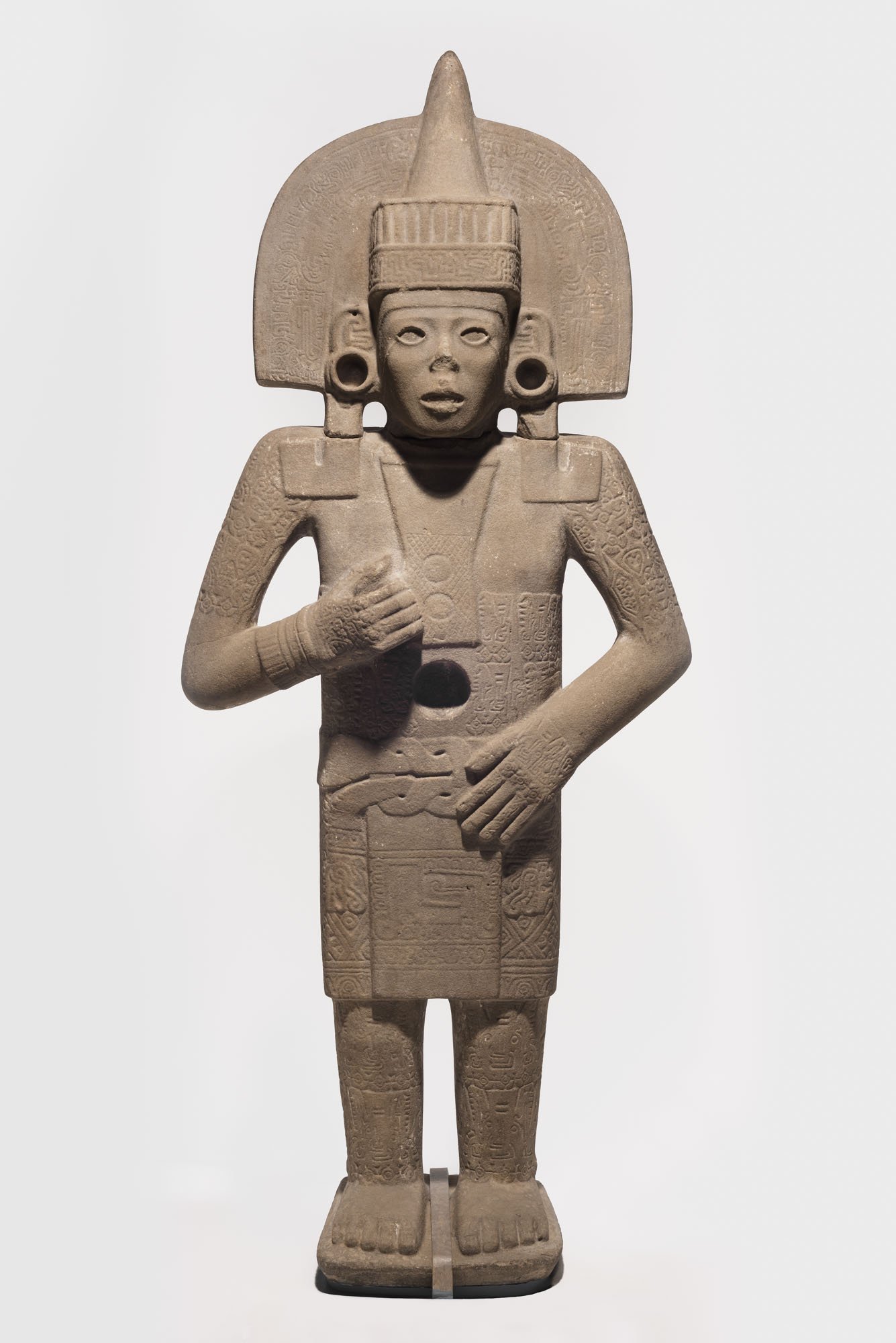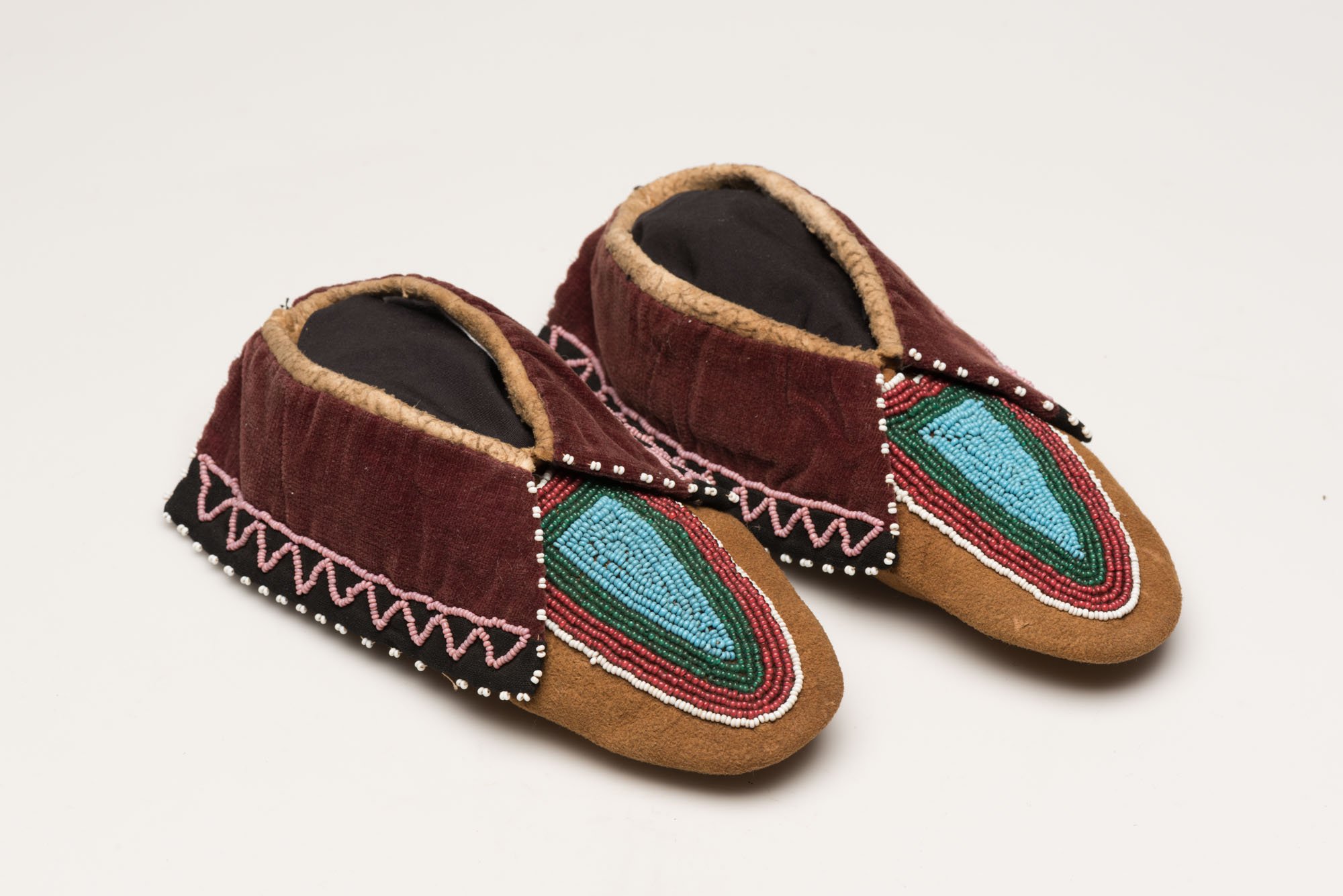Kings and Queens of Africa: Forms and Figures of Power
Installation Views: Kings and Queens of Africa: Forms and Figures of Power ©Department of Culture and Tourism–Abu Dhabi. Photo: Ismail Noor/Seeing Things
Abu Dhabi, UAE 2025 Louvre Abu Dhabi has unveiled its first exhibition of the year, Kings and Queens of Africa: Forms and Figures of Power, marking a milestone as the first exhibition of its kind in the UAE and the region dedicated to African art. Inaugurated by H.E. Shaikh Shakhboot bin Nayhan Al Nahyan, Minister of State; The Honorable Minister of Art, Culture, Tourism, and the Creative Economy of Nigeria, Hon. Hannatu Musa Musawa; H.E. Noura Al Kaabi, Minister of State; and H.E. Mohamed Khalifa Al Mubarak, Chairman of Louvre Abu Dhabi, this groundbreaking exhibition is presented in partnership with Musée du quai Branly-Jacques Chirac and France Muséums, with the support of HONOR as the exhibition's official partner and Valrhona as the exhibition sponsor.
Anthropomorphic mask Baule, Côte d’lvoire, Bouaké region 19th centuryWood, pigment© musée du quai Branly -Jacques Chirac, photo Patrick Gries, Bruno Descoings
Open until 8 June 2025, the exhibition celebrates Africa's rich history, creativity, and cultural legacy from the 11th to the 21st centuries, and highlights its vitality in contemporary art. Visitors can explore an extraordinary collection of royal portraits, sculptures, ceremonial objects, and textiles, discovering the enduring connection between art, power, and identity across the African continent.
Installation Views: Kings and Queens of Africa: Forms and Figures of Power ©Department of Culture and Tourism–Abu Dhabi. Photo: Ismail Noor/Seeing Things
The exhibition is curated by three curators in ancient and contemporary African art: Hélène Joubert, Exhibition General Curator, General Curator, Head of the African Collections at the Musée du quai Branly – Jacques Chirac, Paris; El Hadji Malick Ndiaye, Associate Curator, Head of the Museums Department and Curator of the Musée Théodore Monod d’Art Africain, Institut Fondamental d’Afrique Noire – Cheikh Anta Diop (IFAN-Cheikh Anta Diop), Dakar; and Cindy Olohou, Associate Curator, Head of Collections at the Regional Collection of Contemporary Art, Île-de-France, and Independent Art Critic. Support was provided by Louvre Abu Dhabi Curatorial team, represented by Mariam AlDhaheri, Curatorial Assistant at Louvre Abu Dhabi.
Installation Views: Kings and Queens of Africa: Forms and Figures of Power ©Department of Culture and Tourism–Abu Dhabi. Photo: Ismail Noor/Seeing Things
The showcase features over 350 objects from West, Central, Southern and East Africa, including intricately crafted royal attire and spiritually significant figures, highlighting the exceptional skill of artisans while offering deeper insight into the continent’s rich and diverse heritage.


![Kings and Queens of Africa. ©Department of Culture and Tourism-Abu Dhabi [© musée du quai Branly - Jacques Chirac, Dist. GrandPalaisRmn] (5).jpg](https://images.squarespace-cdn.com/content/v1/5f99c58376d5773ac55d35d6/1747836914861-9ITUKJLCMGJGTJVBN6U0/Kings+and+Queens+of+Africa.+%C2%A9Department+of+Culture+and+Tourism-Abu+Dhabi+%5B%C2%A9+mus%C3%A9e+du+quai+Branly+-+Jacques+Chirac%2C+Dist.+GrandPalaisRmn%5D+%285%29.jpg)





Installation Views: Kings and Queens of Africa: Forms and Figures of Power ©Department of Culture and Tourism–Abu Dhabi. Photo: Ismail Noor/Seeing Things
Kings and Queens of Africa evokes the concept of kingdoms while exploring diverse expressions of power. Spanning empires, kingdoms, city-states, chiefdoms, and figures from divine rulers to heroic leaders, it highlights the many dimensions of power and influence in African history.
H.E. Mohamed Khalifa Al Mubarak, Chairman of Louvre Abu Dhabi, said: “Kings and Queens of Africa offers a remarkable glimpse into the lives of Africa’s revered rulers. Its extraordinary curatorial vision reveals how their cultural legacies continue to inspire contemporary African art and culture and beyond, reflecting Louvre Abu Dhabi’s mission to share universal stories through art. In Abu Dhabi, we view cultural history in all its richness, spotlighting diverse forms of creative expression from cultures around the globe. I hope that visitors are inspired and enriched by these treasures that tell such compelling stories.”
Manuel Rabaté, Director of Louvre Abu Dhabi, said: “In line with our commitment to presenting pivotal moments in the history of art, Kings and Queens of Africa: Forms and Figures of Power offers a profound exploration of Africa’s rich artistic heritage. Africa, as the cradle of humanity and a continent with rich and diverse traditions, has long been a source of resilience and creative expression. By shedding light on its enduring legacy, this exhibition resonates with our mission to engage diverse audiences by presenting stories that transcend boundaries and connect cultures. Louvre Abu Dhabi is honoured to present this exceptional exhibition, thanks to Musée du quai Branly-Jacques Chirac and the invaluable contributions of the curators, lenders, and partners.”
Emmanuel Kasarhérou, President of the Musée du quai Branly – Jacques Chirac, said: “Kings and Queens of Africa’ explores the intricate notion of power through works from the collections of the Musée du Quai Branly-Jacques Chirac and numerous African museums. Enriched with contemporary references, the exhibition is a thousand-year journey that pays tribute to the creative force of an entire continent. Above and beyond the narrative, I salute the approach: a multi-vocal project embodied by a shared curatorship, Kings and Queens of Africa was conceived in a spirit of fertile cooperation. I am also delighted by the forthcoming symposium ‘Encounters & Connections: African Museums Today & Tomorrow,’ which will bring together representatives from museums across Africa and further demonstrating the links that have been forged and this open, horizontal working method. I am pleased that this exhibition will further strengthen the relationship between the Musée du Quai Branly - Jacques Chirac and the Louvre Abu Dhabi in their shared ambition to promote our heritage and the knowledge it reveals.”
The exhibition is divided into three sections, each exploring the art and power of Africa's great kingdoms. West Africa highlights the artistic legacies of Ife, Benin, Akan, Yoruba, and Danhomè, showcasing exquisite sculptures, royal regalia, and art’s role in shaping power and identity. Central Africa features the Kongo, Luba and Teke kingdoms, with ceremonial objects and imagery reflecting the connection between art, spirituality, and leadership. Southern and Eastern Africa spotlights the Zulu and Ethiopian kingdoms, presenting artefacts that celebrate the region’s rich artistic traditions. The journey concludes with an African Pop Art section, featuring contemporary comics and video games.
Hélène Joubert, Exhibition General Curator, General Curator, Head of the African Collections at Musée du quai Branly – Jacques Chirac, said: “Kings and Queens of Africa: Forms and Figures of Power grew out of my reflections on objects of power and the pursuit of a universal theme. Drawing on the collections of the Musée du quai Branly – Jacques Chirac with numerous exceptional masterpieces lent for the first time and recent targeted acquisitions, I envisioned an expansive exhibition introducing African art from the 11th century to today. Spanning all major regions of sub-Saharan Africa, it explores interconnected themes, highlighting the notions of excellence and beauty in service of power. In addition to the collections of the Musée du quai Branly, we collaborated with other international institutions, particularly in Africa, and to private lenders.”
She added: “This exhibition is a collective achievement, with two associate curators joining me in this exceptional project – El Hadj Malick Ndiaye and Cindy Olohou. They have enriched the exhibition’s historical narrative with contemporary insights, deepening its exploration of royalty through a dialogue between past and present. Additionally, Mariam AlDhaheri, Curatorial Assistant at Louvre Abu Dhabi, contributed by exploring local resources. The input and insights of everyone involved have woven a vibrant and unique project that I hope will inspire admiration, surprise, and curiosity in the Emirati public towards the arts of this continent.”
Dr. Guilhem André, Scientific Curatorial & Collection Management Director, commented: “Bringing Kings and Queens of Africa: Forms and Figures of Power to the UAE represents a significant milestone in broadening the spectrum of art history presented in our exhibitions and honouring Africa’s extraordinary cultural legacy. This exhibition provides audiences with a rare opportunity to delve into the pivotal role of African art in shaping concepts of leadership, identity, and power over centuries. From regal artefacts to contemporary masterpieces, the remarkable works on display illuminate the richness and global influence of African artistry. We are also happy to host the forthcoming symposium, African Museums Today and Tomorrow, which will bring together thought leaders from African and international museums, providing an unprecedented platform for exchange between these institutions and an ideal opportunity to take stock of their current situation.”
Crowned head of Queen Oluwo Nigeria, Ife, Wunmonije-Nigeria14th to 15th centuryBrass with zinc content©musée du quai Branly –Jacques Chirac, photographie Hughes Duboi
Highlights of the objects on loan include Crowned head of Queen Oluwo, Ife, Nigeria (14th/15th century); Royal shoes gilded with leaf, Baule, Côte d'Ivoire; Akan chair, Côte d'Ivoire/Ghana; Akatahounto drum, Fon, Benin; Okuyi anthropomorphic mask, Punu, Gabon; Nkisi nkondi magical zoomorphic figurine, Kongo, Congo, and Lefem statue, Bangwa, Cameroon. Contemporary artworks include Mali, a Treasure by Abdoulaye Konaté, and Eddy Kamuanga Ilunga’s painted skins of electronic circuits, amongst others.
The influence of Islam on the African continent is reflected through significant artworks on display, including: A Koran Manuscript with accompanying cases (late 19th to early 20th century), a Koranic Tablet (pre-1972), and a contemporary artwork by Louis Barthélémy and Tarek El Safty of Mansa Musa in Hajj depicting Mansa Musa’s 14th-century pilgrimage to Mecca on a cotton tapestry, symbolising the Mali ruler’s profound legacy.
Louvre Abu Dhabi also presents a significant new acquisition, Fluctuating Throne by renowned Mozambican artist Gonçalo Mabunda. Crafted from decommissioned weapons from Mozambique’s civil war (1976–1992), this powerful sculpture transforms instruments of conflict into a symbol of resilience, hope, and the transformative power of art. With its anthropomorphic design and mask-like face, the throne reflects the duality of human struggle and strength, enriching the exhibition’s narrative of history, identity, and creativity in African art.
The exhibition brings together a diverse collection, combining works from Louvre Abu Dhabi’s permanent collection with pieces loaned by prestigious international institutions from Nigeria, Senegal, Côte d'Ivoire, South Africa, and France. Notable contributions from UAE-based institutions, including Guggenheim Abu Dhabi and Sharjah Art Foundation, further enrich the showcase. This collaboration of local and global partnerships creates a dynamic tapestry of African art, highlighting its cultural richness and global connections.
Laurance Li, General Manager, HONOR GCC, said: “We are honoured to partner with Louvre Abu Dhabi on this remarkable exhibition. This collaboration reflects our dedication to fostering innovation and creativity, not only through technology but also by supporting cultural and artistic initiatives that inspire and unite communities. Our partnership with Louvre Abu Dhabi is a true testament to this commitment.”
Cultural and Educational Programme
A rich cultural and educational programme will accompany Kings and Queens of Africa: Forms and Figures of Power, offering an array of events:
· A symposium: From 28 to 30 January, Louvre Abu Dhabi hosted a three-day symposium, featuring over 23 speakers from the African continent and bringing together over 30 international institutions from across four continents. This event will explore key topics such as shifting museum narratives, renewed approaches to collections management, shared international collaborations, and the role of youth in shaping the future of museums in Africa. This symposium, commissioned by Louvre Abu Dhabi and produced by France Muséums, offers a dynamic platform for dialogue, innovation, and cultural exchange between museum professionals worldwide.
· The Coffee Festival: From 14 to 16 February, coffee lovers were invited to explore the cultural ties between Africa and the Arabian Peninsula through coffee traditions at Louvre Abu Dhabi Park. Visitors will enjoy live Ethiopian and local coffee ceremonies, enriched with storytelling. The festival will also feature Fables from the Land that Stood Still, a contemporary dance performance that connects audiences to Nama culture through storytelling and movement.
Masquerave: On 15 February, guests were invited to an unforgettable Masquerave, headlined by DJ Black Coffee, with an opening act by his son, Sona. The Masquerave will be a fusion of classical masquerade and the artist’s blend of house, African percussions, and electronic music. In collaboration with the DCT Abu Dhabi Events Bureau, the event features stunning masks designed by artist Zak Ové, alongside captivating performances like the Espresso Martini Acrobat, Coffee Cup Roly Poly, and dynamic dancers, offering a mesmerising blend of music and art.
· Community activities: A diverse range of educational activities for adults, families, and youth will be offered, including family weekends and guided tours to provide deeper insights into the exhibition.
For the first time ever, Louvre Abu Dhabi Park transformed into an outdoor gallery, featuring Black Starliner, a 12-metre monumental totem by British-Trinidadian artist Zak Ové. This striking contemporary artwork explores themes of the African diaspora, Afrofuturism, multiculturalism, and globalisation, reflecting the complexity and interconnectedness of identity.
At night, visitors were able to see stunning projections against the museum architecture with vibrant geometric African patterns known as ‘Projection of Harmony,’ created by the renowned South African artist, Dr. Esther Mahlangu.
The Kings and Queens of Africa: Forms and Figures of Power catalogue is available in Arabic, English, and French at the museum’s boutique.
Created by an exceptional agreement between the governments of Abu Dhabi and France, Louvre Abu Dhabi was designed by Jean Nouvel and opened on Saadiyat Island in November 2017. The museum is inspired by traditional Islamic architecture, and its monumental dome creates a rain of light effect and a unique social space that brings people together.
Louvre Abu Dhabi celebrates the universal creativity of mankind and invites audiences to see humanity in a new light. Through its innovative curatorial approach, the museum focuses on building understanding across cultures: through stories of human creativity that transcend civilisations, geographies, and times.
The museum’s growing collection is unparalleled in the region and spans thousands of years of human history, including prehistoric tools, artefacts, religious texts, iconic paintings, and contemporary artworks. The permanent collection is supplemented by rotating loans from 19 French partner institutions and regional and international museums.
Louvre Abu Dhabi is a testing ground for new ideas in a globalized world and champions new generations of cultural leaders. Its international exhibitions, programming, and Children’s Museum are inclusive platforms that connect communities and offer enjoyment for all.
ABOUT MUSÉE DU QUAI BRANLY
The musée du quai Branly - Jacques Chirac is dedicated to the arts and civilisations of Africa, Asia, Oceania and the Americas. Designed by the architect Jean Nouvel, the building has become an iconic signature of Paris’ heritage, just a stone’s throw from the Eiffel Tower. Since its opening in 2006, the museum welcomes some 1.3 million visitors from all continents every year.
With 370,000 objects, 700,000 images, and over 200,000 reference works, its collection is one of the largest in the world and includes many masterpieces. A testament to human genius and the life of societies, these pieces are of major cultural and scientific interest. The many scientific, cultural and technical activities run by the establishment in partnership with the countries its collections originate from contribute to the study, conservation and circulation of works, thus encouraging the spread of knowledge to a broad audience, both in France and internationally. At the same time, a rich and multi-annual programme allows visitors to discover or add to their knowledge of non-European arts and societies.
Permanent and temporary exhibitions, concerts, performances, readings and conferences all play their part in making the musée du quai Branly – Jacques Chirac a living forum for culture where cultures meet every day in dialogue.
For more information about musée du quai Branly, please visit here.
ABOUT FRANCE MUSÉUMS
Following the intergovernmental agreement between France and the Emirates of Abu Dhabi signed in 2007, France Muséums, a cultural consulting and engineering agency, was created to work towards the creation of Louvre Abu Dhabi and support the project in all its dimensions (strategic, scientific, cultural, building, human resources).
Since the opening of the UAE museum in 2017, France Muséums continues to support Louvre Abu Dhabi in four main fields of activity: the management and coordination of loans from French museums for the permanent galleries of the museum, the organisation and production of international exhibitions, training of teams and a wide range of consultancy and auditing assignments in all areas of museum management.
France Muséums mobilises its teams based in Paris and Abu Dhabi and a network of 18 major French cultural institutions and museum partners: Musée du Louvre, Centre national d’art et de culture – Georges Pompidou, Musées d’Orsay et de l’Orangerie, Bibliothèque nationale de France, Musée du quai Branly-Jacques Chirac, Réunion des Musées Nationaux et du Grand Palais (RMN-GP), Château de Versailles, Musée national des arts asiatiques-Guimet, Musée de Cluny – musée national du Moyen-Âge, École du Louvre, Musée des Arts Décoratifs (MAD), Musée d’Archéologie nationale – Saint-Germain en Laye, Musée Rodin, Domaine national de Chambord, OPPIC (Opérateur du patrimoine et des projets immobiliers de la culture), Musée de l’Armée, Institut National du Patrimoine and Centre de Recherche et de Restauration des Musées de France (C2RMF).
For more information about France Muséums, please visit the site here.
About HONOR
HONOR is a leading global provider of smart devices. It is dedicated to becoming a global iconic technology brand and creating a new intelligent world for everyone through its powerful products and services. With an unwavering focus on R&D, it is committed to developing technology that empowers people around the globe to go beyond, giving them the freedom to achieve and do more. Offering a range of high-quality smartphones, tablets, laptops, and wearables to suit every budget, HONOR’s portfolio of innovative, premium, and reliable products enables people to become a better version of themselves.
About Valrhona
Valrhona has been a partner to flavor professionals since 1922 and a pioneer in setting the standard in the world of chocolate. Today, it defines itself as a company whose mission - “together, let’s do good things with good food” - expresses the strength of its commitment. Together with its colleagues, chefs and cocoa growers, Valrhona imagines the best of chocolate to create a fair and sustainable cocoa industry and inspire gastronomy that tastes good, looks good, and does good.
Every day, Valrhona is driven by a determination to build direct, long-term relationships with producers, seek out chocolate’s next innovation, and share expertise. Valrhona works with chefs to support skills and craftsmanship, guiding them on their quest for a unique identity by constantly pushing back creativity’s boundaries.
In January 2020, Valrhona became a B Corporation®. The company is proud to have been awarded this demanding label for the second time in January 2024. It rewards the world’s most ethically conscious companies, all of which combine economic performance with social and environmental responsibility. This distinction is a recognition of “Live Long”, the company’s sustainable development strategy shaped by our desire to co-construct a model that would have a positive impact on producers, employees, flavor professionals, and everyone who loves chocolate.
Choosing Valrhona means making a commitment to ethical chocolate. 100% of our cocoa beans are traced back to our producers, so you know exactly where they come from, who harvested them, and that they were produced in the right conditions. Choosing Valrhona means choosing chocolate that respects people and the planet.
For more information about Valrhona, please visit here.
ABOUT THE DEPARTMENT OF CULTURE AND TOURISM – ABU DHABI
The Department of Culture and Tourism–Abu Dhabi (DCT Abu Dhabi) drives the sustainable growth of Abu Dhabi’s culture and tourism sectors and its creative industries, fuels economic progress and helps achieve Abu Dhabi’s wider global ambitions. By working in partnership with the organisations that define the emirate’s position as a leading international destination, DCT Abu Dhabi strives to unite the ecosystem around a shared vision of the emirate’s potential, coordinate effort and investment, deliver innovative solutions, and use the best tools, policies, and systems to support the culture and tourism industries.
DCT Abu Dhabi’s vision is defined by the emirate’s people, heritage, and landscape. We work to enhance Abu Dhabi’s status as a place of authenticity, innovation, and unparalleled experiences, represented by its living traditions of hospitality, pioneering initiatives, and creative thought.
ABOUT SAADIYAT CULTURAL DISTRICT
Home to Louvre Abu Dhabi, Berklee Abu Dhabi, Manarat Al Saadiyat, Abrahamic Family House and the soon-to-open Zayed National Museum, teamLab Phenomena Abu Dhabi, Guggenheim Abu Dhabi and Natural History Museum Abu Dhabi, Saadiyat Cultural District is one of the greatest concentrations of cultural institutions.
Saadiyat Cultural District is a global platform, emanating from a rich cultural heritage, celebrating traditions, and advancing equitable culture. It is an embodiment of empowerment, showcasing museums, collections, and narratives that support the region’s heritage while promoting a diverse global cultural landscape.
Saadiyat Cultural District is a testament to Abu Dhabi's commitment to preserving heritage while embracing a forward-looking vision. The District invites the world to engage with diverse cultures, fostering dialogue exchange, and offers a global cultural space that supports the region and the global South.
For more information about the exhibition and others, please visit here. The museum can also be found on YouTube, X, Instagram, and Facebook.
Daniel Kukla: Thanatosis (Playing Dead)
Installation view: Daniel Kukla: Thanatosis (Playing Dead), The Empty Circle Gallery, New York, 2025.
(Gowanus, Brooklyn, NY)— The Empty Circle presents Thanatosis (Playing Dead), a solo exhibition by multidisciplinary artist Daniel Kukla, marking his second exhibition with the gallery. The show brings together recent photographic and sculptural works that explore the fragile tension between preservation and loss, examining how aesthetic, scientific, and museological practices attempt to contain nature's transience. Informed by Kukla's background in biology, the exhibition reflects his ongoing engagement with the visual strategies used to capture, classify, and arrest natural phenomena.
Installation view: Daniel Kukla: Thanatosis (Playing Dead), The Empty Circle Gallery, New York, 2025.
Rooted in fieldwork and archival research, Kukla’s practice considers the archive, the specimen, and the image as charged sites where systems of observation collide with acts of disappearance. Images of extinct specimens and archival traces, made within a natural history collection, encapsulate this dynamic: remnants that mark presence through absence. This conceptual tension recurs throughout the exhibition, where the aesthetics of containment—pins, specimen cards, and photographic stillness—are interrogated for their complicity in both revelation and erasure.
In several camera-less photographic works, Kukla pierces and folds the paper, embedding fragments of black coral and burning holes through photographs. Photogram moiré patterns and marbling techniques introduce additional visual ruptures, destabilizing the image plane and inviting viewers to navigate an unstable field. A sculptural work made of marbled hog intestine, once used in preservation practices, confronts the viewer with both visceral materiality and ornamental beauty, embodying the exhibition’s central inquiry: How do we hold what is always slipping away?











Installation view: Daniel Kukla: Thanatosis (Playing Dead), The Empty Circle Gallery, New York, 2025.
A cyanotype exposed on a found blanket using stones as masks extends Kukla's exploration of elemental processes. The resulting image captures the environment’s touch not through depiction, but through direct impression, registering presence by way of absence. Nearby, a self-portrait shrouded in black velvet and cradling the skull of an endangered Siberian tiger offers a meditation on visibility and authority. The figure is nearly invisible, subsumed beneath fabric while the relic gleams with taxonomic clarity, complicating hierarchies between subject and object.
Throughout the exhibition, paper marbling recurs as both medium and metaphor. Once used to embellish scientific folios, it becomes a resistance to fixed classification, its fluid, non-repeating forms standing in contrast to the rigidity of Victorian damask patterns etched onto butterfly specimens. This juxtaposition merges scientific display with decorative imperialism. Here, beauty and taxonomy are historically entangled, exposing the aesthetics of power embedded in collection practices.
Installation view: Daniel Kukla: Thanatosis (Playing Dead), The Empty Circle Gallery, New York, 2025.
Kukla crafts a visual language centered on fragility, interference, and the impossibility of preservation without transformation. Folding, burning, piercing, and painting are not only formal gestures, but interpretive tactics echoing his belief that attempts to hold on to what is in flux inevitably leave their own marks. Rather than seek restoration, Thanatosis (Playing Dead) acknowledges the layered consequences of loss, offering a quiet meditation on what remains and what refuses to be contained.
Courtsey of Artist
About the Artist
Daniel Kukla (b. 1983) is a visual artist whose work spans installation, sculpture, video, and image-making. Kukla's work has been exhibited at Aperture Foundation, The International Center of Photography, The National Art Gallery of the Bahamas, RISD Museum of Art, Masin Museo de Art de Sinaloa, Williams College Museum of Art, among others. His work has been featured in the New Yorker Magazine, The New York Times, Time Magazine, Wall Street Journal, Wallpaper Magazine, Juxtapoz, Granta Magazine, Guernica Magazine, The Washington Post, and others. Kukla is a graduate of the International Center of Photography’s program in Documentary Photography and Photojournalism. Prior to his photographic education, he attended the University of Toronto and received an Honours Bachelors of Science in Biology and Evolutionary Ecology.
About The Empty Circle
The Empty Circle, located at 499 3rd Ave in Gowanus, Brooklyn, is a contemporary art gallery dedicated to showcasing emerging artists in their first solo exhibitions in New York City. Focused on fostering creativity, conversation, and bold experimentation, the gallery aims to be a cornerstone of the vibrant Gowanus art scene.
The exhibition opened on April 26 of this year and had an opening reception on the same day. The exhibition will close on May 31, 2025. For more information about this exhibition and others at The Empty Circle, please visit their site here; the gallery can also be found on Instagram here. The magazine did an interview with Daniel which can be found here.
Tarek Atoui Improvisation in 10 Days
















Exhibition view, Tarek Atoui “Improvisation in 10 Days” Pirelli HangarBicocca, Milan, 2025 Courtesy the artist and Pirelli HangarBicocca, Milan Photo Rasa Juskeviciute
Tarek Atoui Improvisation in 10 Days Curated by Lucia Aspesi, opened on Wednesday, February 5, 2025 there was a Press preview on Tuesday, February 4, 2025 the exhibition will run until July 20, 2025
From February 6 to July 20, 2025, Pirelli HangarBicocca will present "Improvisation in 10 Days", the first solo exhibition in Italy by artist and electro-acoustic composer Tarek Atoui. Focusing on sound, his research expands on the acoustic medium provoking physical and mental responses in the public, stimulating activities of perception, experience and knowledge. Through installations, complex acoustic environments, and collaborative performances, Tarek Atoui experiments around the concept of listening, and pursues an artistic research that originates from different geographical, historical, and social contexts.
Tarek Atoui Waters' Witness (detail), 2020-23 Exhibition view, Kunsthaus Bregenz, 2024 Courtesy the artist Photo: Agota Lukyte © Kunsthaus Bregenz, 2024
Known for his distinctive approach to music, Tarek Atoui (Beirut, Lebanon, 1980; lives and works in Paris) investigates the acoustic properties of elements such as water, air, stone, and bronze and the ways in which they absorb sound and return it with unexpected nuances. This process initiates forms of aggregation and curiosity in the visitors, who are asked to play an active, participatory role.
The sonic environments created by the ensemble of the works present in the space suggest possible\ listening experiences and stimulate non-traditional learning processes.
Tarek Atoui The Rain, Rotating String Drum, 2023 (detail) Mixed media installation Installation view, Art Sonje Center, Seoul, 2023 Courtesy the artist, Vitamin Creative Space © Ahina
After an education in music, Atoui began by exploring the properties of sound through performance, and later expanded his research into the spatiality of objects in relation to the artistic context. Throughout his career, he has collaborated with composers and artisans from various countries to invent and produce instruments with a strong sculptural imprint, combining a wide range of materials and skills. Using electronic devices and software, the artist reflects on contemporary social and political realities, revealing the importance of music and new technologies as dimensions of expression and identity. Educational values and social relations are constitutive aspects of Atoui's practice, which often involves collaborations with various local communities and invites visitors to interact and experience his multi-sensory environments.
"Improvisation in 10 Days", curated by Lucia Aspesi, is the title of Tarek Atoui's exhibition. "In Milan, my proposal is an homage to improvisation", explains the artist. Borrowing a specific term from the lexicon of music, Atoui explores the potential of composition in space, bringing the material, sculptural, architectural and relational qualities of the works into dialogue with the immaterial nature of sound and its reverberation in bodies and things. Using the Shed as a large blank canvas, the artist rearranges and recomposes works from one of his previous exhibitions, starting from the identity of the space (a place of production) and the time coordinates (the days on which the artist will set up the exhibition) and using them to "improvise" movements, harmonies, and tunings to create a collective experience in a sonic environment. This is the first time that Atoui has conceived an exhibition as an actual device capable of evolving and materializing over time in a given situation, creating a dynamic relationship between space, instruments, and people. The true potential of the project lies in its "dynamic" status, in its openness to chance.
Tarek Atoui Souffle Continu, 2024 Exhibition view, Kunsthaus Bregenz, 2024 Photo: Markus Tretter Courtesy the artist © Tarek Atoui, Kunsthaus Bregenz
As the artist explains, "There is no loop, there is no beginning and end in the sense of a musical composition or structure that starts and ends. There's a cycle that is always transforming, and a relationship between instruments that is always changing"
.
Tarek Atoui's works are conceived as constantly evolving projects that change over time and adapt to the different contexts in which they are presented. The artist is often inspired by past works that are reimagined, resulting in a different poetic experience and sensibility with each reworking. His research always begins with an acoustic paradigm that is experimented with through activities such as workshops with local communities of artisans, researchers, or musicians, and then leads to the production of sculptures and installations that invite a meditative and multi-sensory approach. In his work, sound takes on material qualities and, in addition to being heard, it can be transmitted and perceived through vibration, mechanical stress on a surface, or tactile experience. The exhibition presents three bodies of work, harmoniously displayed in space and in dialogue with natural light.
The first group of works, WITHIN (2013-ongoing), is one of the artist's longest running projects, stemming from a workshop Atoui designed and led with a community of deaf people. In these works, the artist searches for a method to perceive sound in a sensorial, visual, and performative dimension. Drawing on his background as an educator, he reflects on the act of listening and reinterprets musical sound as a language of learning. From this series of works, the exhibition includes the Souffle Continu group, consisting of Organ Within (2022), a sculpture that reinvents the traditional organ and its performative, spatial, and perceptual characteristics, and the more recent Wind House #1 and #2 (2023-24), two "wind rooms" accessible to visitors, who can experience through their bodies the sound produced by a flow of air compressed and shaped by the transparent structure. The second corpus, Waters' Witness (2020-23), stems from research conducted in collaboration with musician and composer Eric La Casa in various ports, including Athens, Abu Dhabi, Beirut, Istanbul, Porto, Sydney, and Singapore. Experimenting with different technologies such as underwater and environmental microphones, Atoui recorded the sounds of these non-places that were once the beating heart of cities. For the version at Pirelli HangarBicocca, the artist displays several marbles from the city of Athens, now used in the restoration of ancient Greek temples.
The Rain (2023-24), one of the artist's lesser-known bodies of work, is dedicated to rain. Characterized by sophisticated forms and materials such as wood, rope, and bronze, the work is inspired by traditional Korean drum-making techniques and the craft of ceramics and paper. Atoui explores multiple sound compositions through the use of technological devices associated with the four elements—earth, water, fire, and wind—in a process that transforms the cycle of energy into new instruments and stimulates different listening experiences. As the artist reveals, "The four elements here play a fundamental role, they are the performers, and they are, I would say, at the forefront of bringing this piece to life and making it come together".
Tarek Atoui Portrait Photo: Miro Kuzmanovic © Tarek Atoui, Kunsthaus Bregenz, 2024
The artist
Tarek Atoui has exhibited his work at many leading institutions, including Museo Nacional Thyssen- Bornemisza and TBA21 Thyssen-Bornemisza Art Contemporary, Madrid (the exhibition will open on February 18, 2025); Kunsthaus, Bregenz, S.M.A.K., Ghent (2024); Art Sonje Center, Seoul, Museum of Contemporary Art MCA, Sydney, Institut d'art contemporain - Villeurbanne/Rhône-Alpes (2023); The Contemporary Austin, Texas, FLAG Art Foundation, New York, Museo Serralves, Porto, MUDAM, Luxembourg (2022); Fridericianum, Kassel (2020); NTU Centre for Contemporary Art Singapore, Kunstenfestivaldesarts, Brussels (2017); Bergen Assembly (2016); Berkeley Art Museum, Pacific Film Archive (2015); Fondation Louis Vuitton, Paris (2014). In addition, Atoui has presented his performances at Sharjah Art Foundation (2020); Palazzo Grassi - Punta della Dogana - Fondazione Pinault, Venice (2019); Para Site, Hong Kong; Museo d'Arte Contemporanea Castello di Rivoli, Turin (2017); Tate Modern, London (2016); Serpentine Gallery, London (2012); Performa 11, New York (2011).
His major group exhibitions include: Taipei Biennial (2023); Istanbul Biennial (2022); Bourse de Commerce - Pinault Collection, Paris, Gwangju Biennial (2021); the Walker Art Center, Minneapolis, Venice Biennale, Schirn Kunsthalle, Frankfurt (2019); Garage Museum of Contemporary Art, Moscow (2018); Fondazione Prada, Ca' Corner della Regina, Venice (2014); documenta, Kassel (2012); New Museum of Contemporary Art, New York, the Mediacity Biennial, Seoul, Haus Der Kunst, Munich (2010); Sharjah Biennial (2009).
Catalog
The exhibition is accompanied by a monograph published by Marsilio Editori. Through a poetic visual narrative, the volume will present the exhibition at Pirelli HangarBicocca and the artist's previous solo exhibitions at three international institutions: Kunsthaus Bregenz, S.M.A.K Gent (2024), and Institut d'art contemporain—Villeurbanne/Rhône-Alpes (2023). The book, designed by Goda Budvytyte, is the result of a collaboration between these four European institutions and will include a critical essay by curator Ute Meta Bauer that examines Atoui's practice. In addition to the catalog, it will be realized a vinyl set featuring recordings of Atoui's instruments activated by a number of international musicians, including Jad Atuoi, Nicolas Becker, Laure Boer, Gobu Drab, Susanna Gartmayer, Charbel Haber, Mazen Kerbaj, Eric La Casa, Boris Shershenkov, DJ Snif, and Ziúr.
Pirelli HangarBicocca
Pirelli HangarBicocca is a non-profit foundation dedicated to producing and promoting contemporary art. It was conceived and is supported by Pirelli. Established in 2004, Pirelli HangarBicocca has become a benchmark institution for the international art community, local public and region. It is a museum that is free of charge, accessible and open, and a place for experimentation, research and dissemination, where art is a point of reflection on the most topical themes of contemporary culture and society.
It caters to a broad and diverse public with a programme of major solo exhibitions by both Italian and international artists, a multi-disciplinary program of accompanying events and in-depth discussions, theoretical and informational publications, and educational courses. A team of museum facilitators is on hand at all times to help the public connect with the art. Vicente Todolí has been the foundation’s artistic director since 2012.
Situated in a former industrial building, once a locomotive manufacturing facility, Pirelli HangarBicocca occupies 15,000 square metres, making it one of the largest single-level exhibition spaces in Europe. This vast area comprises the Shed and Navate spaces, which are used for temporary exhibitions, and the permanent display of Anselm Kiefer’s The Seven Heavenly Palaces 2004-2015. This monumental installation with seven reinforced concrete towers has become one of the most iconic works in Milan. While since 2010 La Sequenza (1971-1981), a work by sculptor Fausto Melotti, has been located in the outdoor garden at the entrance of Pirelli HangarBicocca.
The building also houses a number of services for the public: a spacious entrance with reception area, facilities for educational activities, space for conferences and meetings, bookshop and bistro with a charming outdoor area.
For more information about this exhibition and others at Pirelli HangarBicocca please visit their site here. Pirelli can also be found on Facebook, Instagram, YouTube, Spotify, and Pinterest.
Leiko Ikemura: Talk to the sky, seeking light
Exhibition view of ‘Leiko Ikemura: Talk to the sky, seeking light’ at Lisson Gallery, New York, 1 May – 1 August 2025 © Leiko Ikemura, Courtesy Lisson Gallery
“The uncertainty of our time brings many questions, but also possibilities. The female figures initiate new life, holding it in their arms and in their body as a part of themselves”
Leiko Ikemura Genesis, 2015 Tempera on jute 190.2 x 290.2 x 6.4 cm 74 7/8 x 114 1/4 x 2 1/2 in © Leiko Ikemura, Courtesy Lisson Gallery
Lisson is pleased to host Leiko Ikemura’s first exhibition with the gallery, featuring many of the themes present in her work over the past 30 years, including a wide range of media from paintings in tempera to bronze figures and glass forms. The installation revolves around a central, three-and-a-half metre rabbit/woman figure, known as Usagi Janus (2025). This hand-sculpted and hand-patinated, protective spirit – part-bunny, part-bodhisattva of compassion – provides respite from the outside world in her conical-shaped bodily enclosure, the tiny punctures in her mothering skirt creating an internal universe of projected stars. The giant’s two faces – one staring forward, the other looking backwards – refer to the many alter egos and avatars that appear throughout Ikemura’s oeuvre, some of which can be seen in the smaller bronze pieces and crystal heads. The Janus-faced figure represents less of an either/or dialectic than a it does state of in-betweenness, one she seeks to explore through her anthropomorphic creatures and objects, or else in the spaces that dwell neither in light nor dark, neither in good nor evil, but rather in a twilit dusk and a zone of uncertainty.
Leiko Ikemura Sleep, 2010/2024 Patinated bronze 41.9 x 79.1 x 52.4 cm 16 1/2 x 31 1/8 x 20 5/8 in © Leiko Ikemura, Courtesy Lisson Gallery
The Usagi is a recurring motif that Ikemura recalls from a childhood game to locate the shadowy features of a rabbit on the surface of the moon, but first appeared as a character in her practice following the Tōhoku earthquake and associated Fukushima nuclear accident of 2011. Witnessing reports from afar of devastation for both the Japanese population and its natural habitats, including subsequent birth defects in animals, the artist envisaged this mythical Usagi acting both as a messenger for the kami (gods) and as a container for universal suffering, resilience and renewal. A precursor can be seen in a smaller-scale bronze from 1990, titled Hasen-Frau or Hare-Woman, revealing how Ikemura’s creatures have endured and survived many decades, while the German title points to the decision, relatively early on in her career, to settle and make work in Europe.



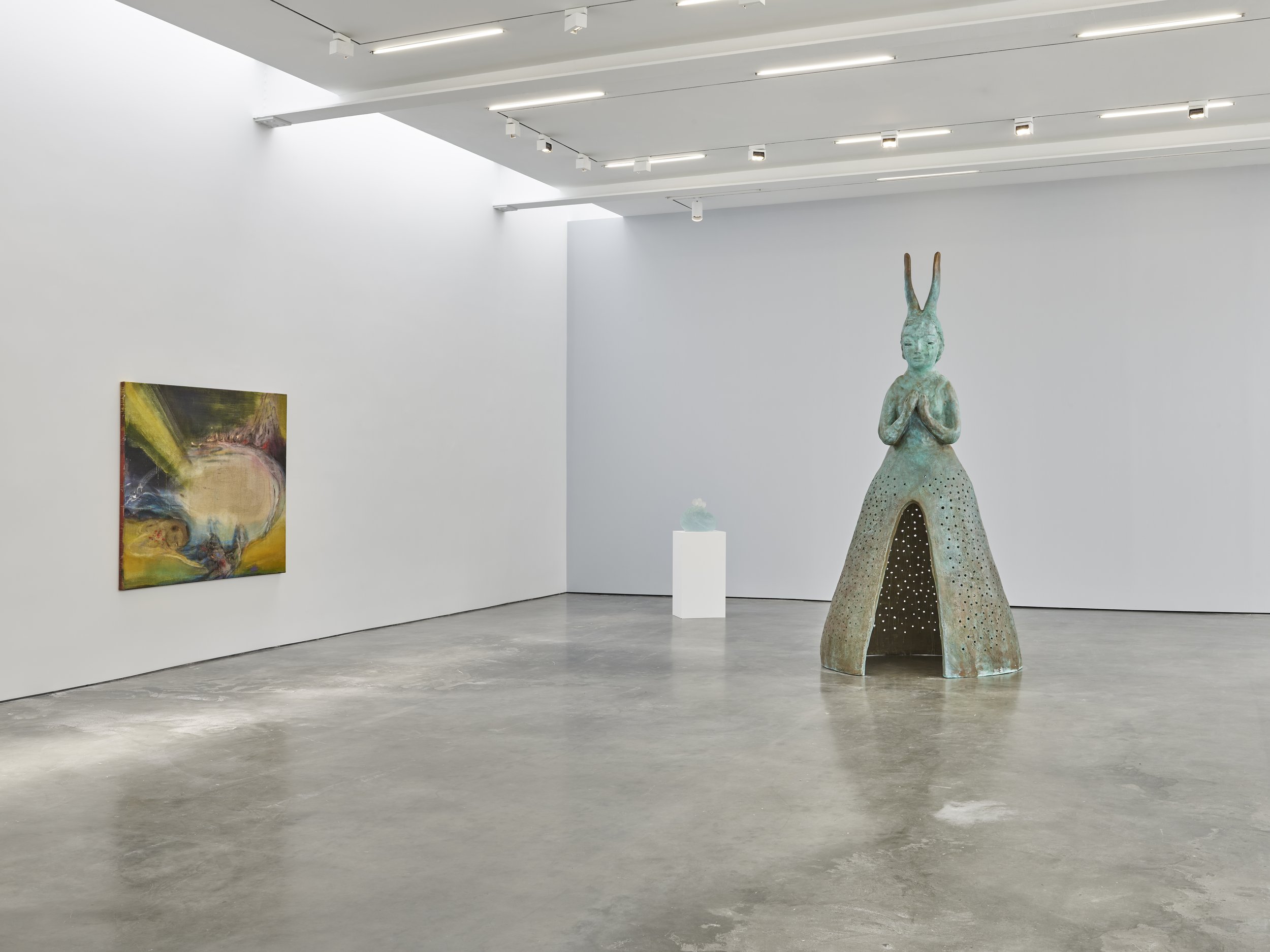
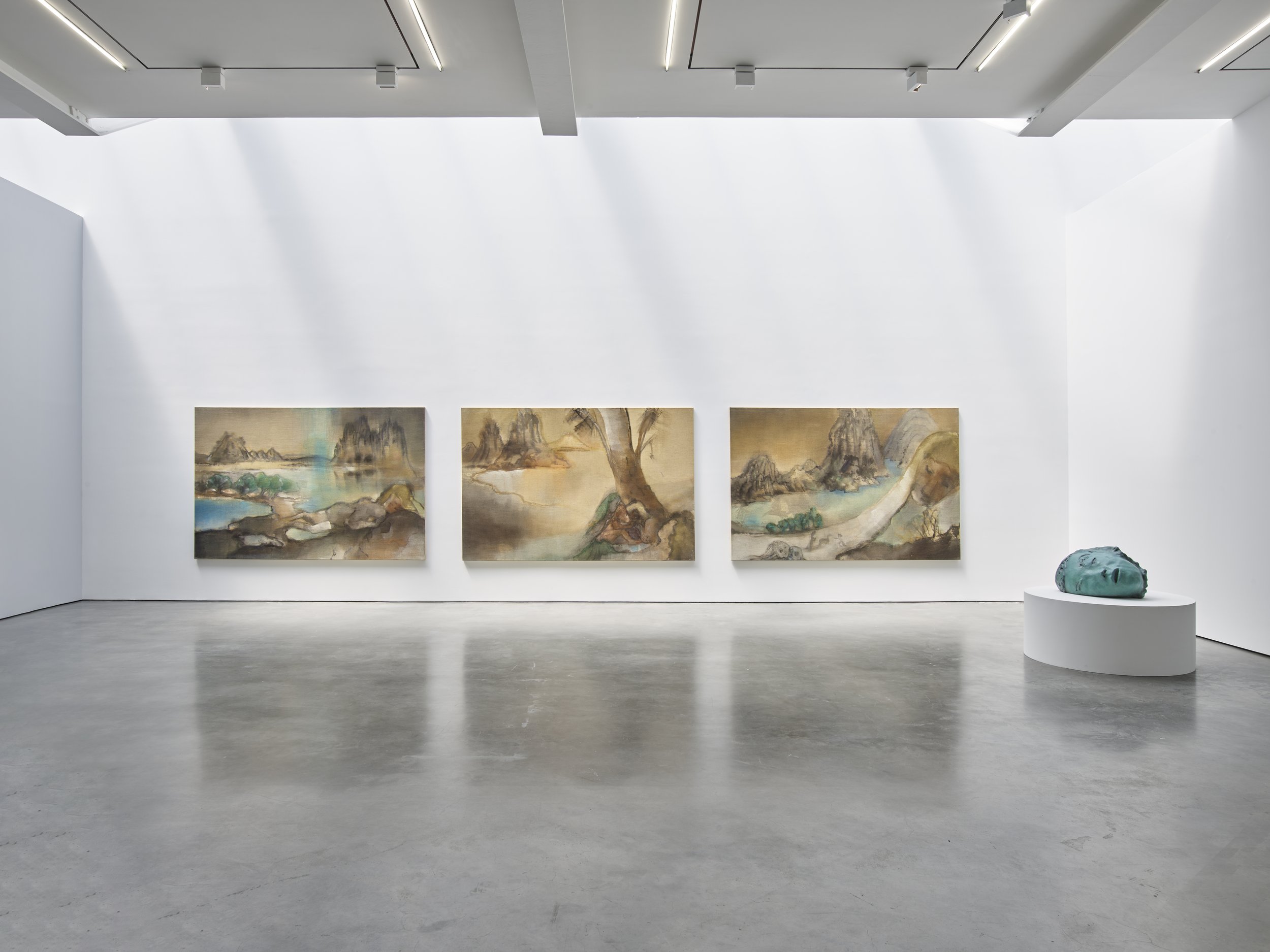
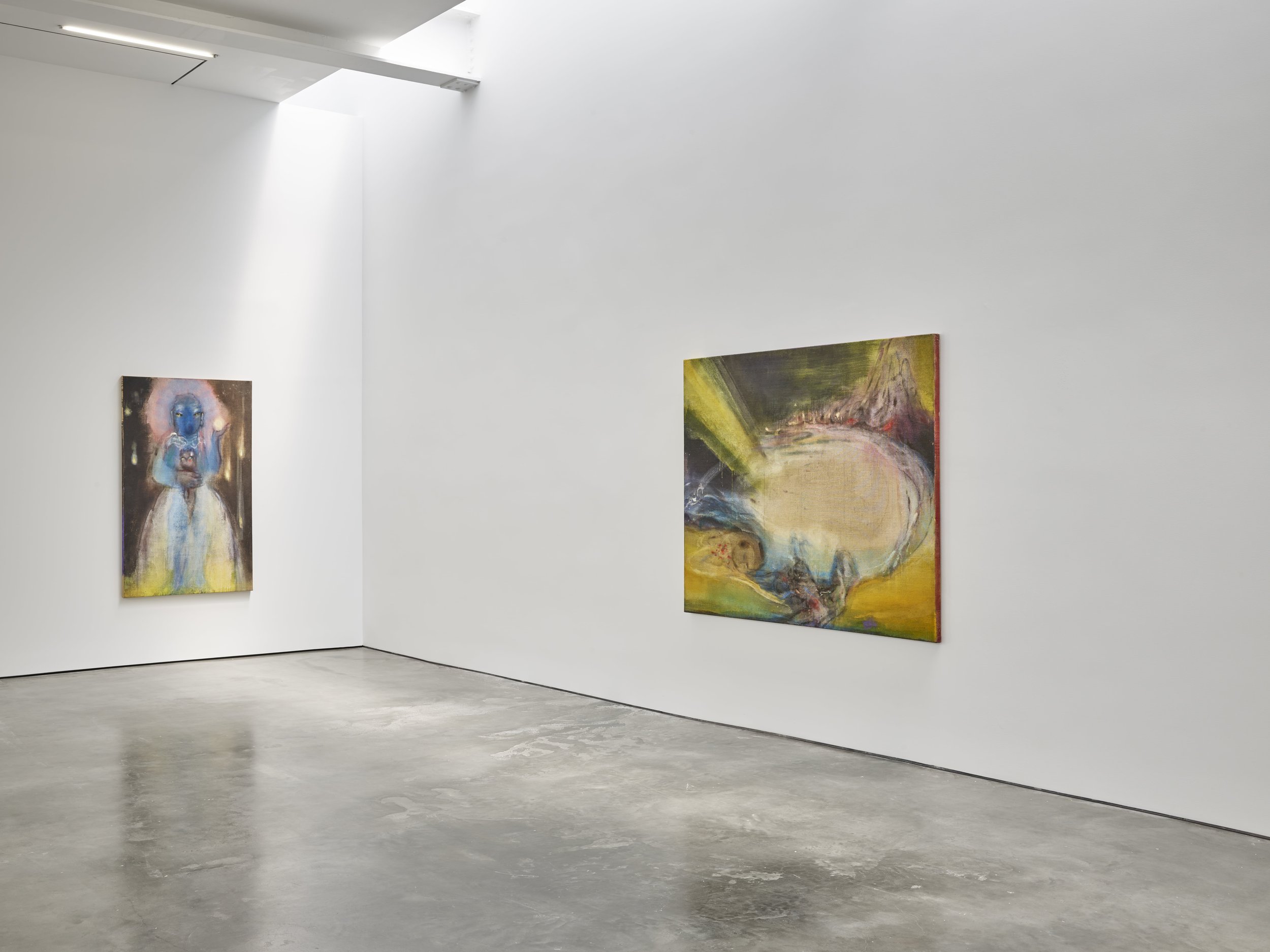
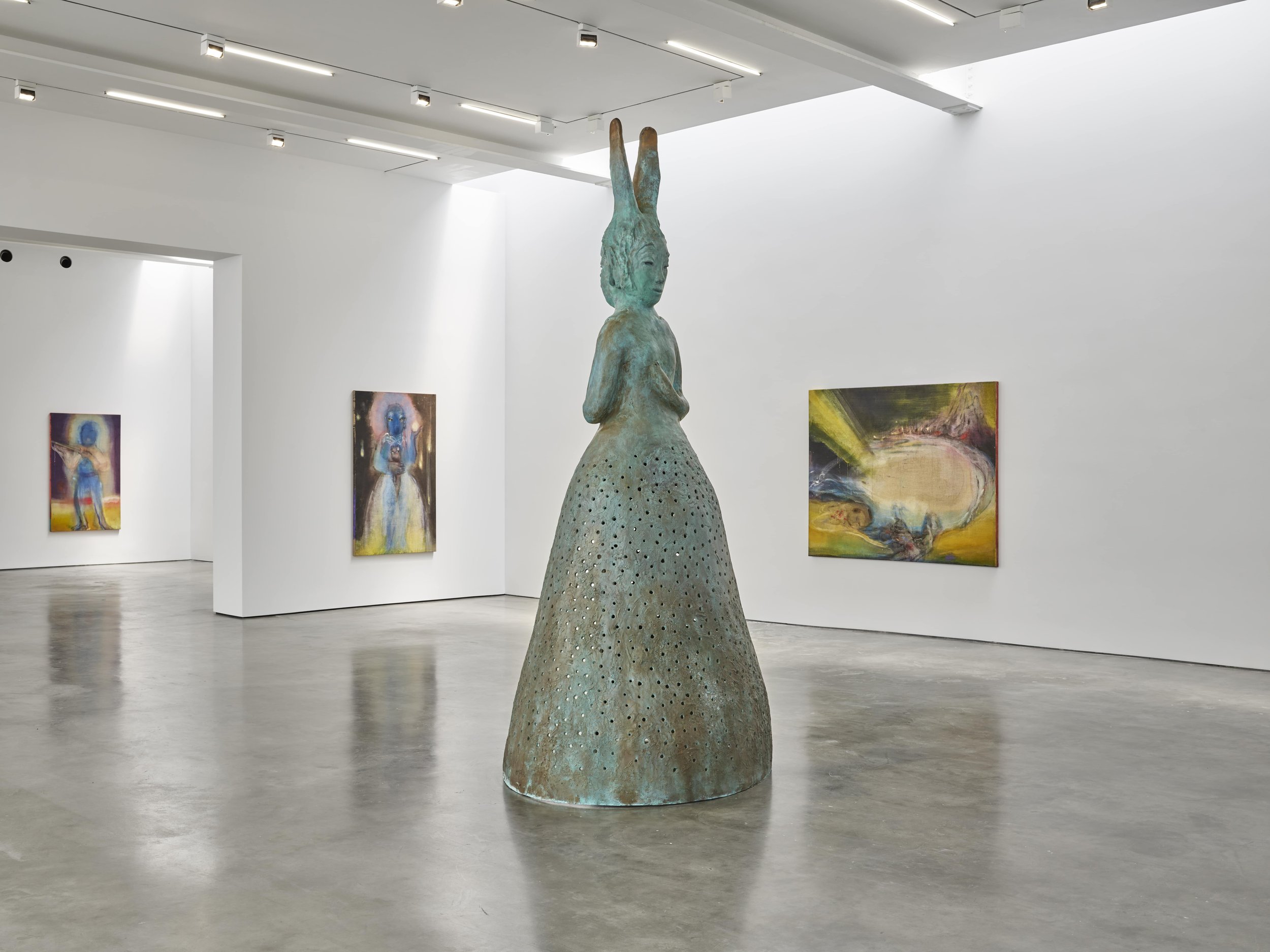

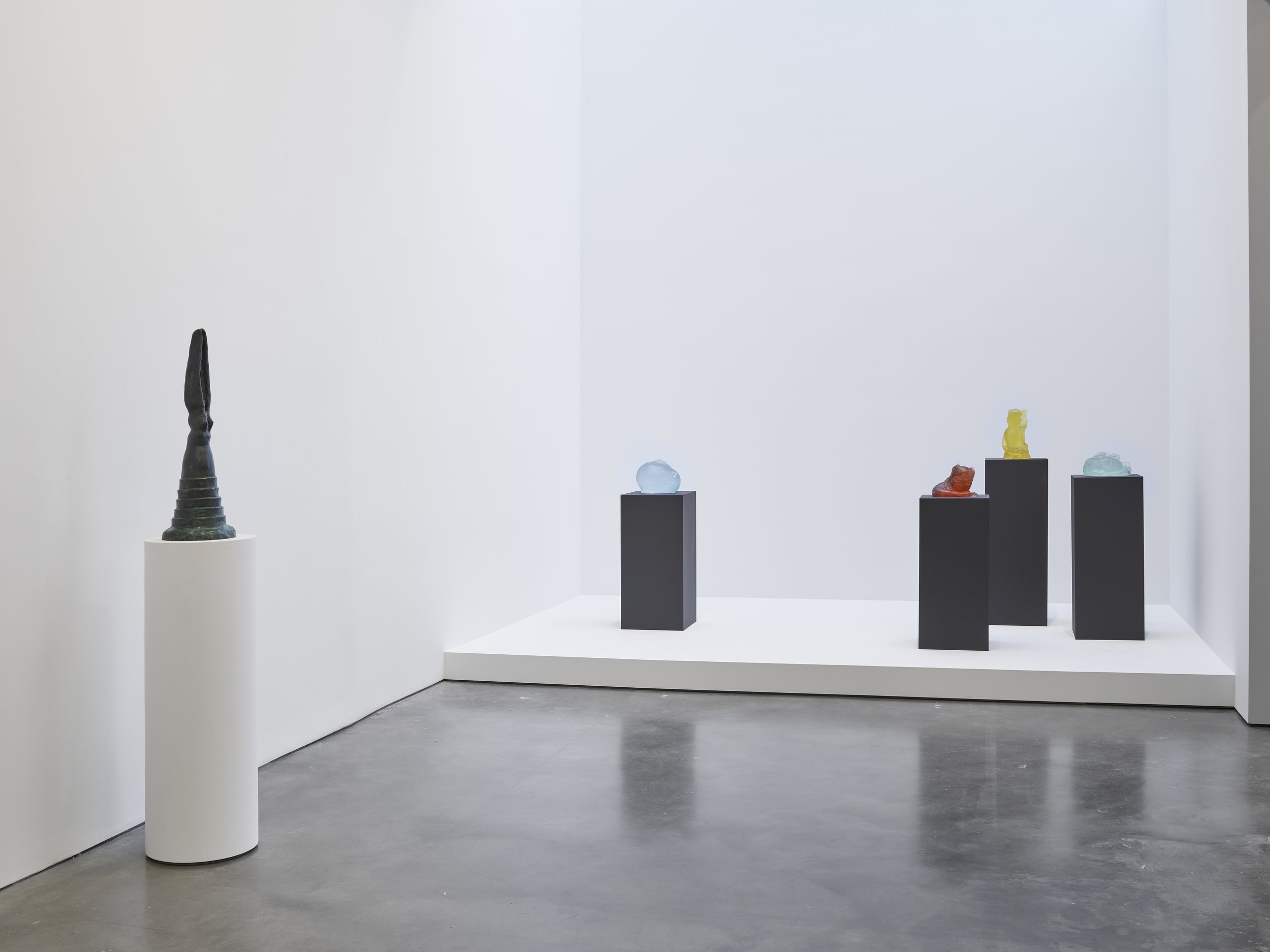
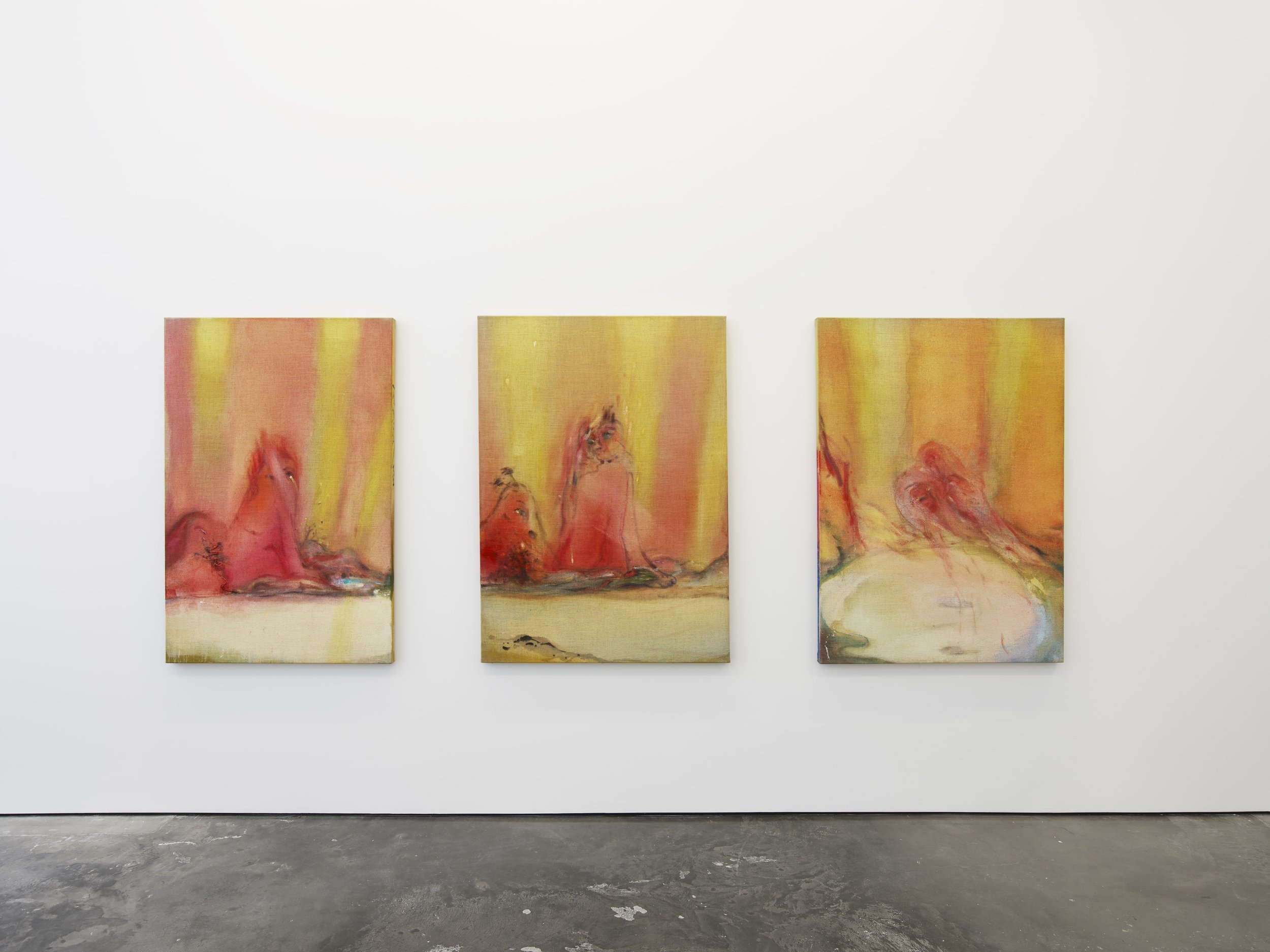
Exhibition view of ‘Leiko Ikemura: Talk to the sky, seeking light’ at Lisson Gallery, New York, 1 May – 1 August 2025 © Leiko Ikemura, Courtesy Lisson Gallery
Framing the shrine-like form of Usagi Janus is a trio of fantastical landscapes depicting a bucolic, forest scene, which might also depict the very origins of life on our planet. Among the mountainsides and wooded pastures are reclining figures or hidden faces, either fused indelibly with the land or haunting its borders through skeletal or skull-like apparitions. In one of Ikemura’s poems, entitled Transfiguration, she writes: “I’ve seen it / everything changes / people turn into rocks / into mountains / into oceans.” A figure in repose is also captured vividly in Sleeping Figure in Red (1997/2012), in which a young female is face down, with head in hands, perhaps in distress or, as the title suggests, at rest.
Ikemura’s recurring cast of young girls can be found variously recumbent, strident, floating, crying, laughing. Here a duo of Brave Girls(2022), one in pink with a cat, one in orange with a wedding veil, flank a third, Pièta in Cherry Red (2024), also cradling a cat or baby, with a pair of hypnotizing eyes blazing back at the viewer. At once powerful and confrontational, but also vulnerable and naive, Ikemura again finds a subtler path between these extremes for her fearsome adolescents, the pigments soaking through and infusing the raw jute canvas with their glowing, glowering presence. Whether as psychological portraits of moods or alternate, hybrid beings, these singular objects by Ikemura amount to an impressive act of world building and longevity.
Leiko Ikemura Cat, 2020 Cast glass 20 x 27 x 17 cm 7 7/8 x 10 5/8 x 6 3/4 in © Leiko Ikemura, Courtesy Lisson Gallery
About the artist
Since the 1980s, Leiko Ikemura has explored themes of transition, cross-culturalism, collective responsibility, and sexuality, emancipating the feminine body from its position in history and mainstream contemporary culture by challenging artistic conventions and disrupting social norms. The internationally recognized artist seamlessly shifts between luminous, otherworldly and often monumental oil paintings, introspective drawings and watercolours, glazed terracotta sculptures, glass and ceramics.
Focusing on the transient innocence of childhood, Ikemura’s female spirits are defiant and independent, yet fragile and ethereal, almost ghost-like, bestowing the spirits with a composite power to exist within multiple worlds, between dreaming and waking states. Fusing Eastern and Western art – conceiving a realm inspired by East Asian sansuiga painting traditions, old Japanese masters, surrealism, post-war abstraction, and the revival of figurative painting in the 1980s – Ikemura’s spiritual works are imbued with a raw and tender presence that highlights the intimate relationship between human, animal, plant, mineral forms, and cosmology.
Leiko Ikemura (イケムラレイコ, 池村 玲子, Ikemura Reiko) was born in Tsu, Mie Prefecture, Japan and is based in Berlin. She studied at the Osaka University of Foreign Studies from 1970–1972, followed by the Escuela Superior de Bellas Artes de Santa Isabel de Hungría, Seville, Spain from 1973–1978. In 1979, Ikemura moved to Zurich to pursue a career as an artist. In 1991, Ikemura became a professor of painting at the Universität der Künste in Berlin. Since 2014, she has held a professorship at the Joshibi University of Art and Design near Tokyo.
A major survey exhibition by Leiko Ikemura, ‘Motherscapes’, takes place at the Albertina, Vienna, Austria November 21 – February 8, 2026. She has exhibited in numerous solo exhibitions internationally, including Kunsthalle Emden, Germany (2024-25) HEREDIUM in South Korea (2024), Georg Kolbe Museum Berlin (2023), Feuerle Collection, Berlin (2023), Museum de Fundatie, Zwolle, Netherlands (2023), Museo de Arte de Zapopan, Guadalajara, Mexico (2023), Being Art Museum, Shanghai (2023), Museum für Asiatische Kunst, Berlin (2022 & 2012), Sainsbury Centre for Visual Arts, Norwich (2021), CAC La Ciutat de les Arts i les Ciències Valencia (2021), Stiftung St. Matthäus, Berlin (2020), The National Art Center, Tokyo (2019), Kunstmuseum Basel (2019 & 1987), and Nordiska Akvarellmuseet Skarhamn (2019).
About Lisson Gallery
Lisson Gallery is one of the most influential and longest-running international contemporary art galleries in the world. Today the gallery supports and promotes the work of more than 70 international artists across spaces in London, New York, Los Angeles, Shanghai and Beijing. Established in 1967 by Nicholas Logsdail, Lisson Gallery pioneered the early careers of important Minimal and Conceptual artists such as Art & Language, Carl Andre, Daniel Buren, Donald Judd, John Latham, Sol LeWitt, Richard Long and Robert Ryman among many others. It still works with many of these artists and others of that generation, from Carmen Herrera and Olga de Amaral to Hélio Oiticica and Lee Ufan. In its second decade the gallery introduced significant British sculptors to the public for the first time, including Tony Cragg, Richard Deacon, Anish Kapoor, Shirazeh Houshiary and Julian Opie. Since 2000, the gallery has gone on to represent many more leading international artists such as Marina Abramović, Ai Weiwei, John Akomfrah, Liu Xiaodong, Otobong Nkanga, Pedro Reyes, Sean Scully, Hiroshi Sugimoto and Wael Shawky. It is also responsible for raising the international profile of a younger generation of artists including Dana Awartani, Cory Arcangel, Garrett Bradley, Ryan Gander, Josh Kline, Hugh Hayden, Haroon Mirza, Laure Prouvost and Cheyney Thompson.
The exhibition opened on May 1 and will be on view until August 1, 2025, at the NYC location at 508 West 24th Street. For more information about this exhibition and others, please visit the Lisson Gallery here. The gallery can also be found on Facebook, YouTube, and Instagram.
Carmen Herrera: The Paris Years 1948 –1953
Exhibition view of ‘Carmen Herrera: The Paris Years, 1948 – 1953’ at Lisson Gallery, New York, 1 May – 1 August 2025 © Carmen Herrera, Courtesy Lisson Gallery
From 1948 to 1953, Carmen Herrera lived in Paris, immersing herself in the city’s dynamic postwar artistic community while frequently traveling to New York and Havana. This period marked a decisive shift in her practice, as she moved from biomorphic forms and fevered, gestural compositions to the rigorous geometric abstraction that would define her career for the next seven decades. A new exhibition at Lisson New York, Carmen Herrera: The Paris Years, 1948 - 1953—the most comprehensive presentation of her work from this period to-date— examines a young artist deep in experimentation, subsuming the seismic influences of many colliding midcentury art movements, in order to develop her own breakthrough language of painting.
Carmen Herrera Conquete de l'air, 1950 Acrylic on canvas 75.9 x 117.2 x 2.2 cm 29 7/8 x 46 1/8 x 7/8 in © Carmen Herrera, Courtesy Lisson Gallery
Herrera’s years in Paris were a time of creative freedom and intellectual exchange, particularly through her participation in exhibitions such as the Salon des Réalités Nouvelles, where she exhibited alongside other prominent figures such as Theo van Doesburg, Max Bill, and Piet Mondrian, as well as younger artists associated with Venezuela’s Los Disidentes, Brazil’s Concretists, and Argentina’s Grupo Madi. The city exposed her to key modernist movements such as Bauhaus and Russian Suprematism, which deeply influenced the shift toward her own uniquely minimal language. During her time in Paris, Herrera began employing shaped canvases while also becoming a pioneer in solvent-based acrylics, a material still novel in postwar Europe. Notably, an important work from this period, Iberic (1949), is currently the oldest work in the permanent collection of the Metropolitan Museum of Art to use this particular medium, a fact that was discovered through scientific analysis by the museum in 2021.
Key works on view include Way (1950), an early example of the hard-edged, dichromatic abstraction that would later become her signature. The painting’s four symmetrical ochre-colored triangles against a black background prefigure later masterpieces such as Black and White (1952) in the permanent collection of the Museum of Modern Art. Another major work from this period, Thrust (1950), exemplifies Herrera’s precision and spatial tension, featuring a striking white dart slashing across a cobalt blue ground. The work, both in its palette and bold linear composition, foreshadows Herrera’s future direction while also underscoring her approach to painting as object. This idea is further emphasized by the use of an artist-made frame, which was intended to prevent a buyer from re-framing the work. This concept evolves in subsequent pieces where she allowed her compositions to wrap about the edges, transforming them into fully three-dimensional forms.
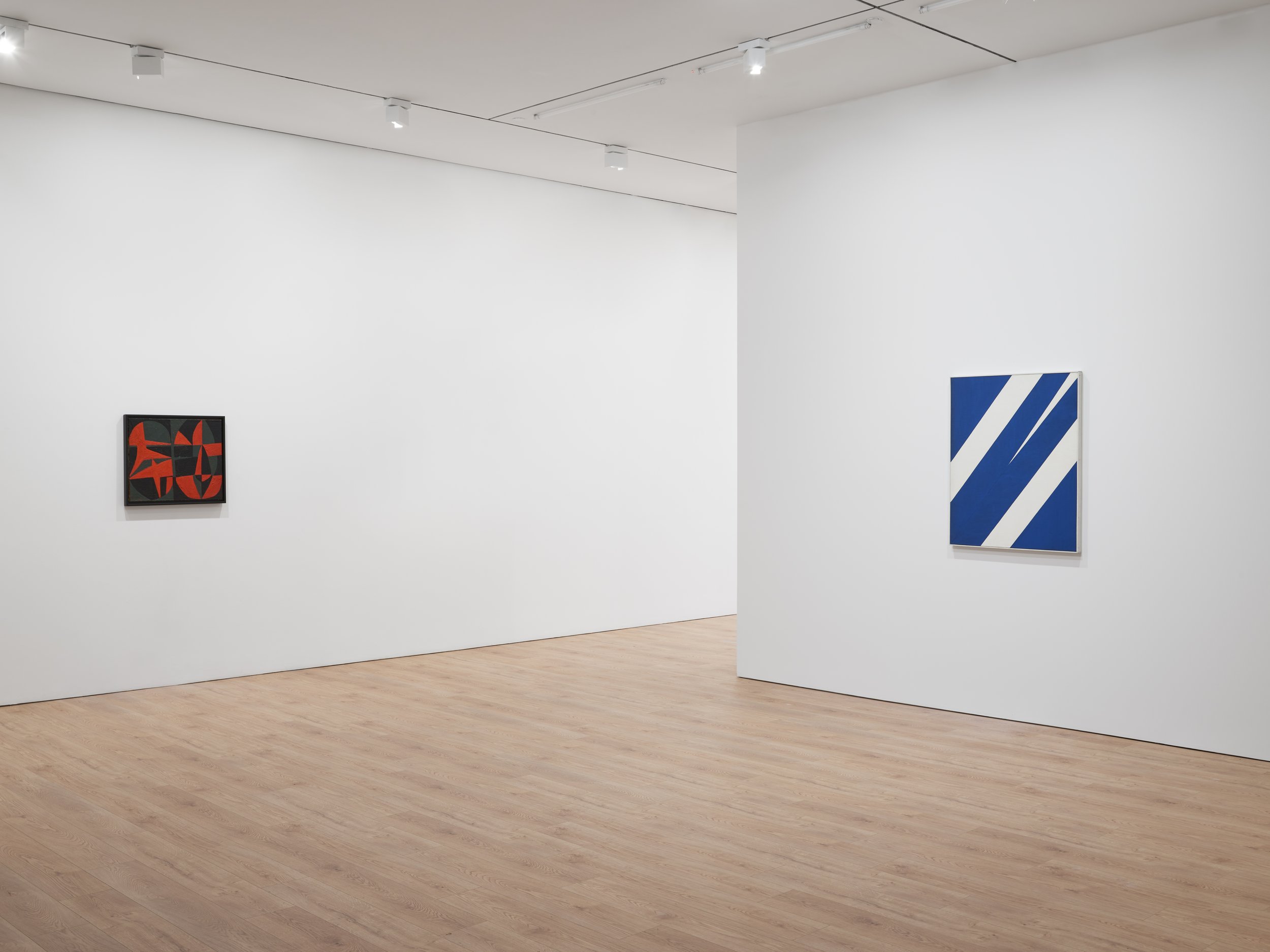
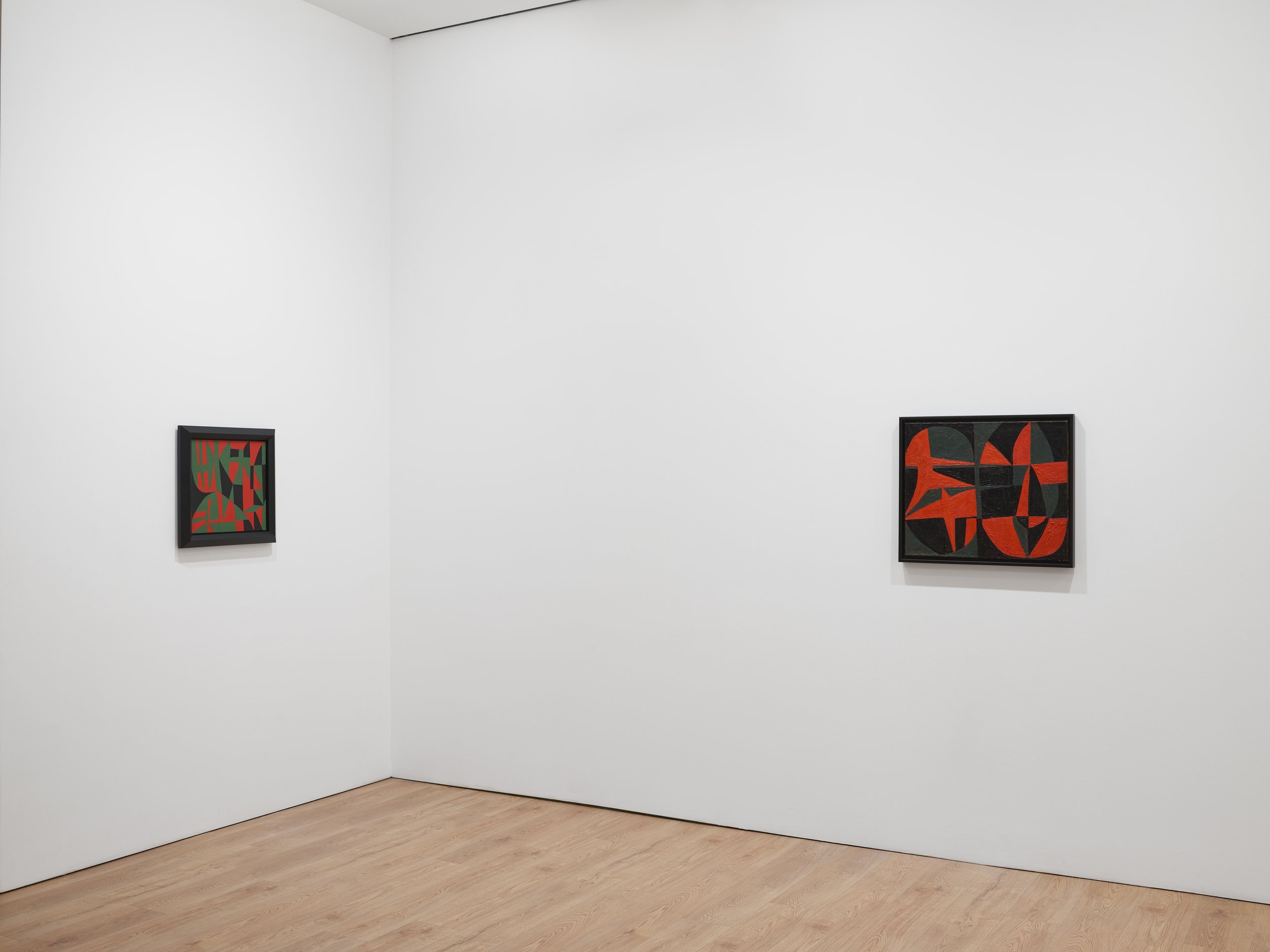
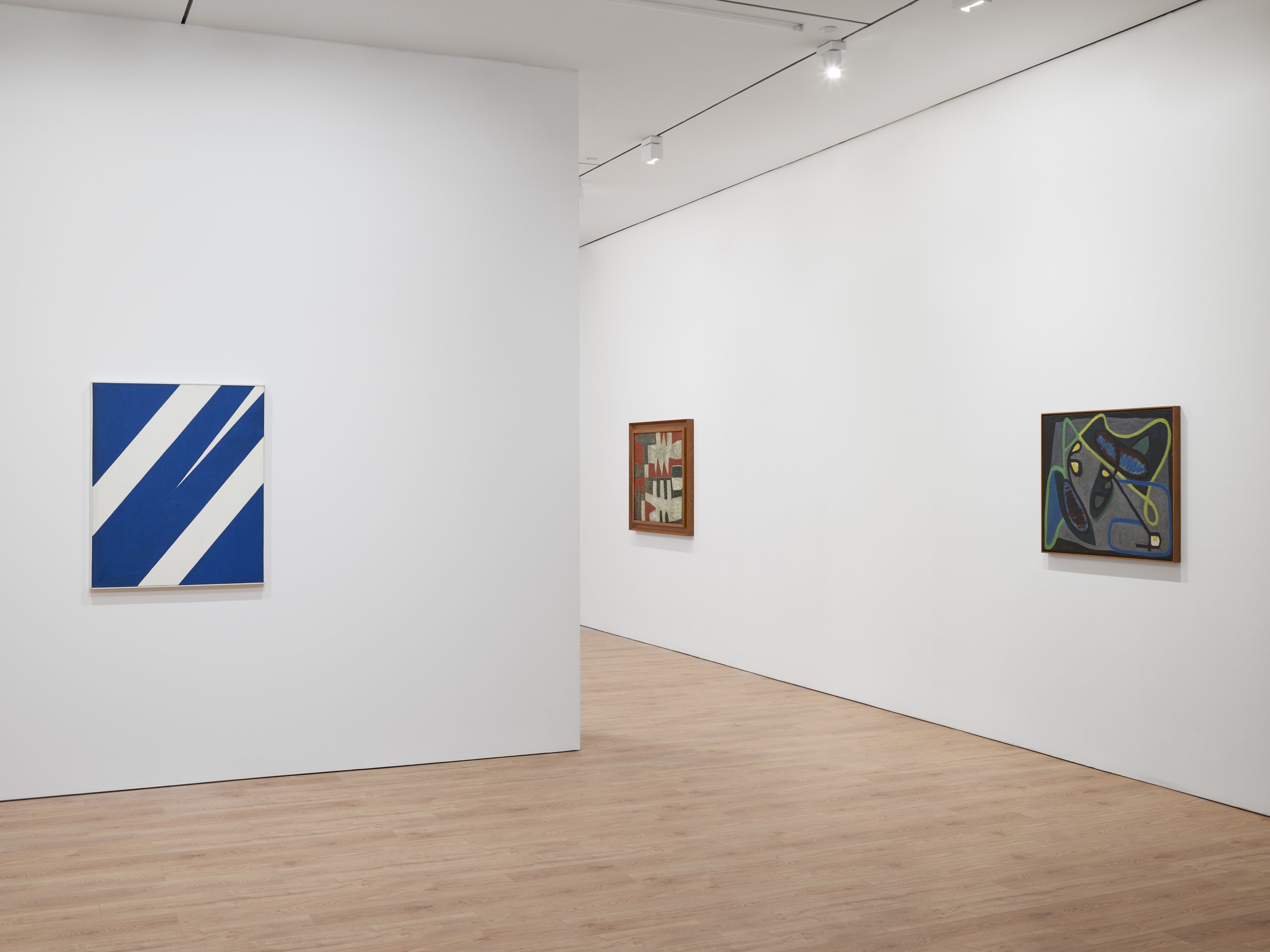
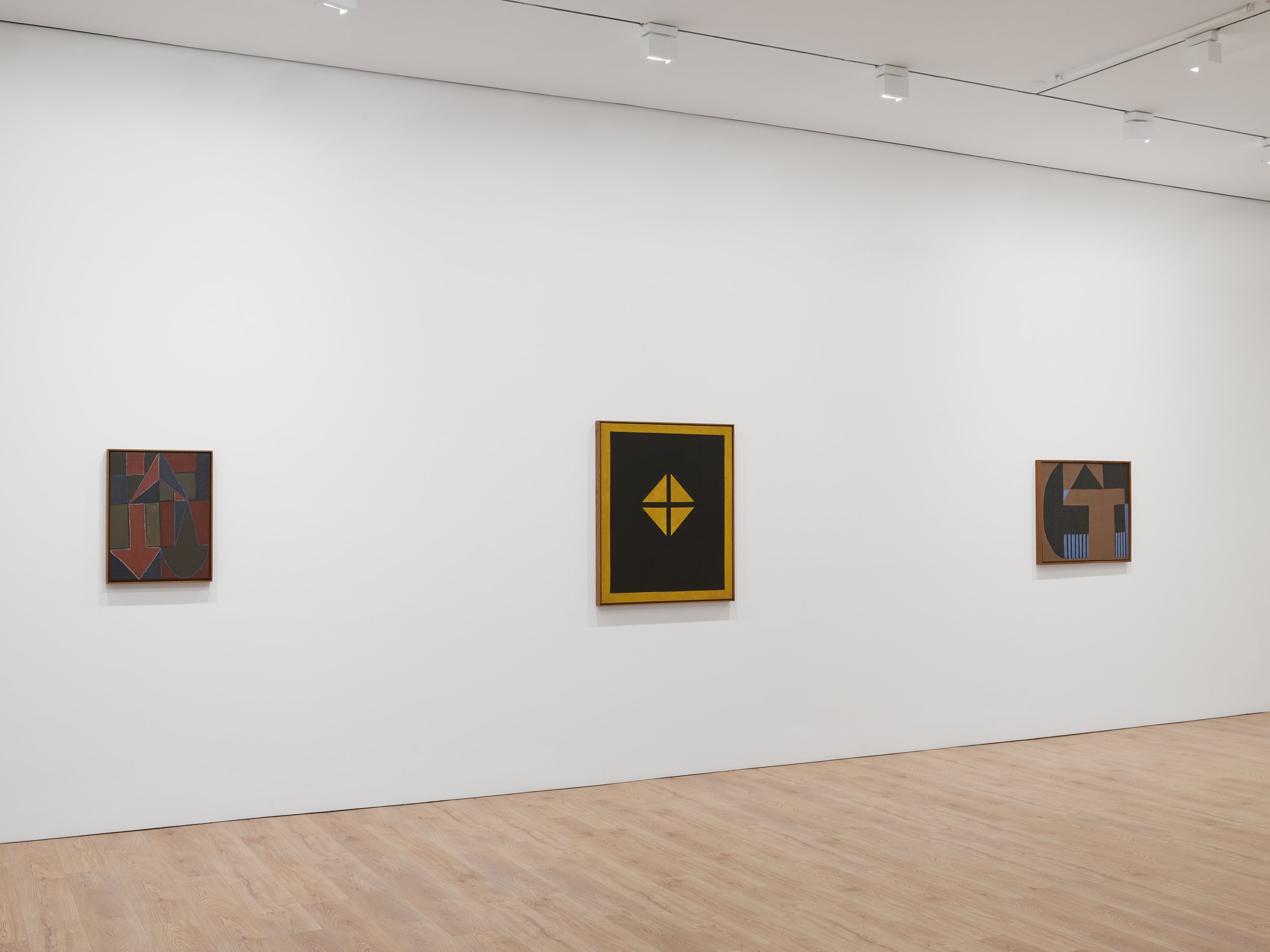

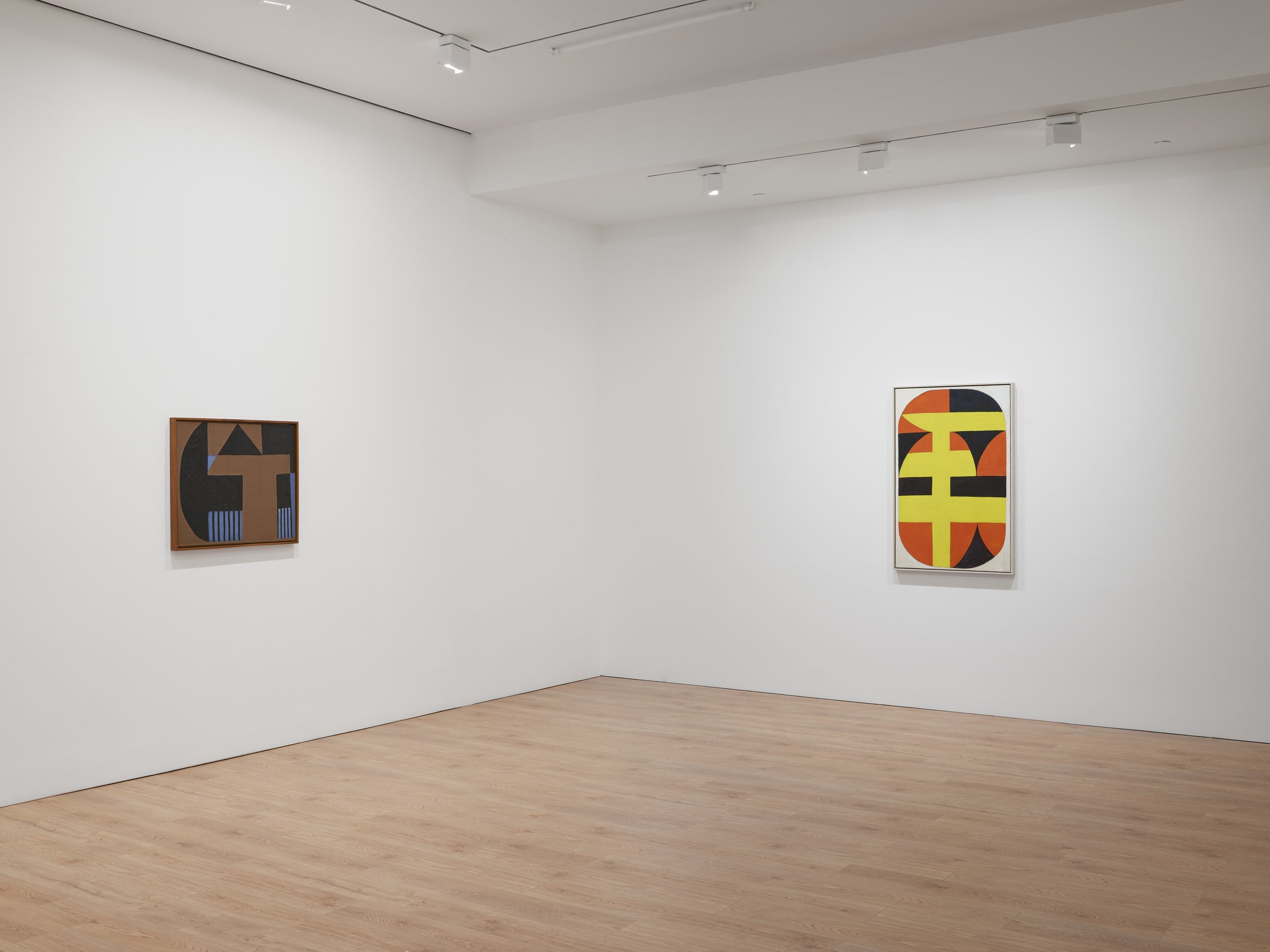
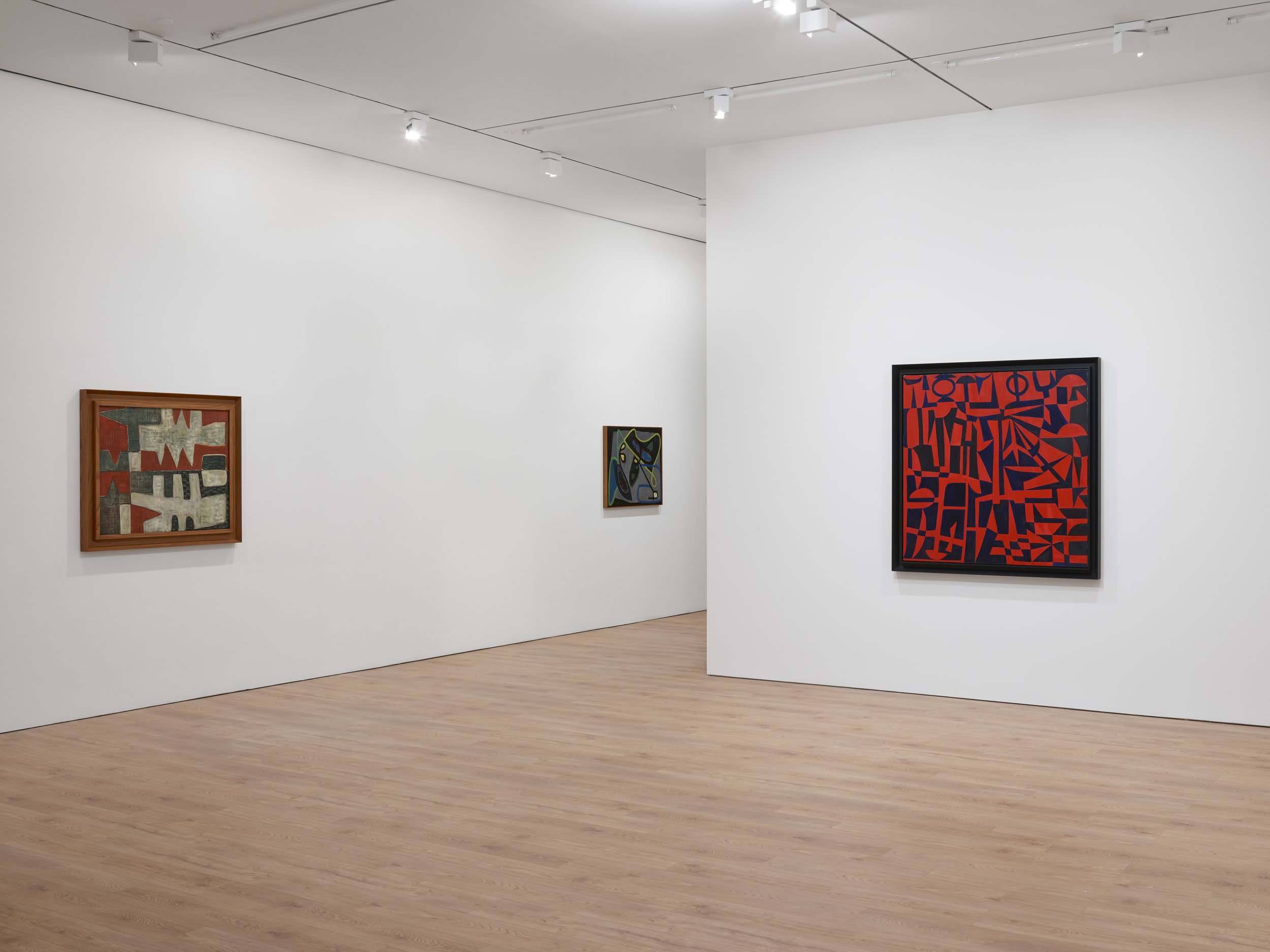

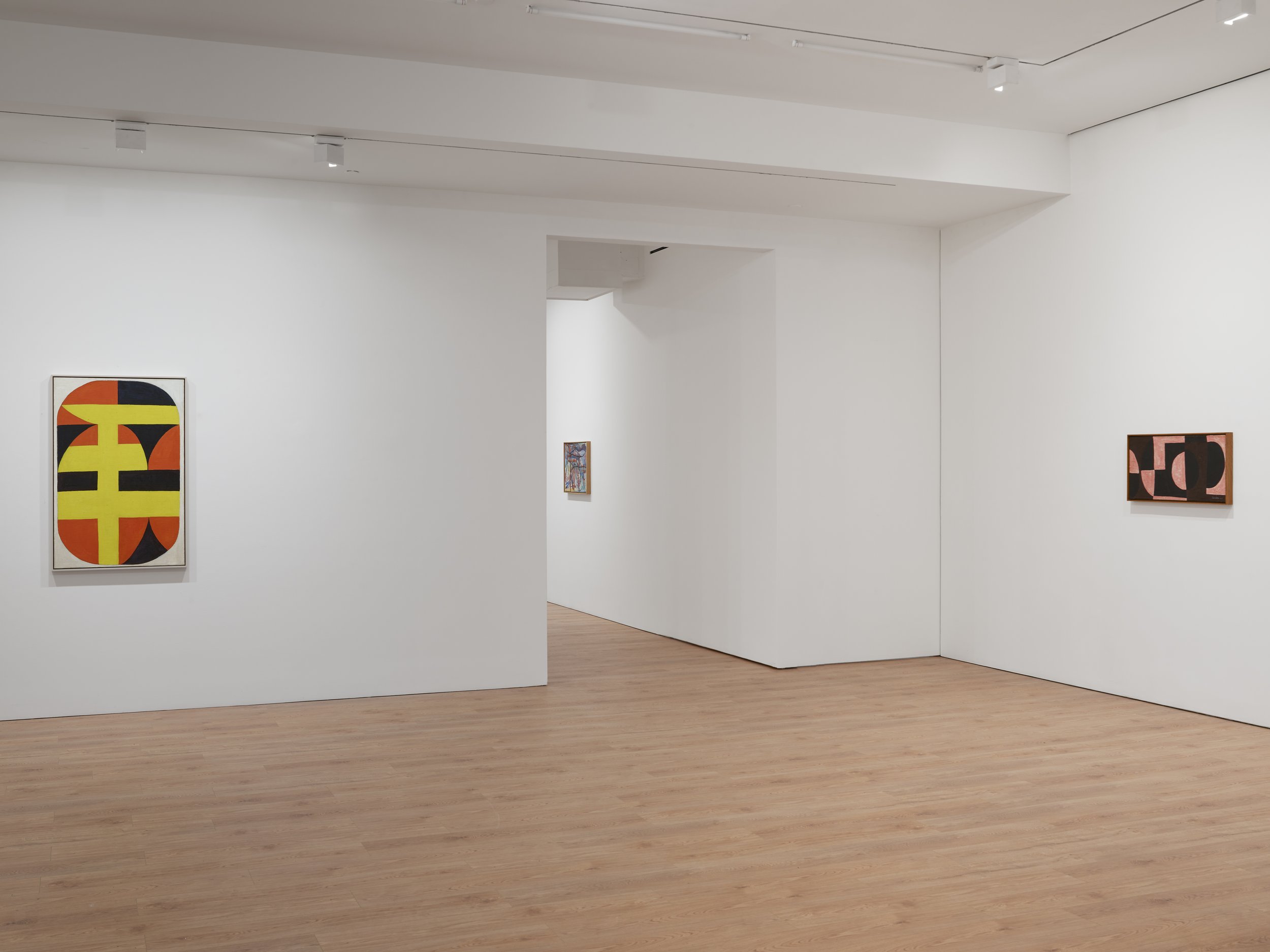
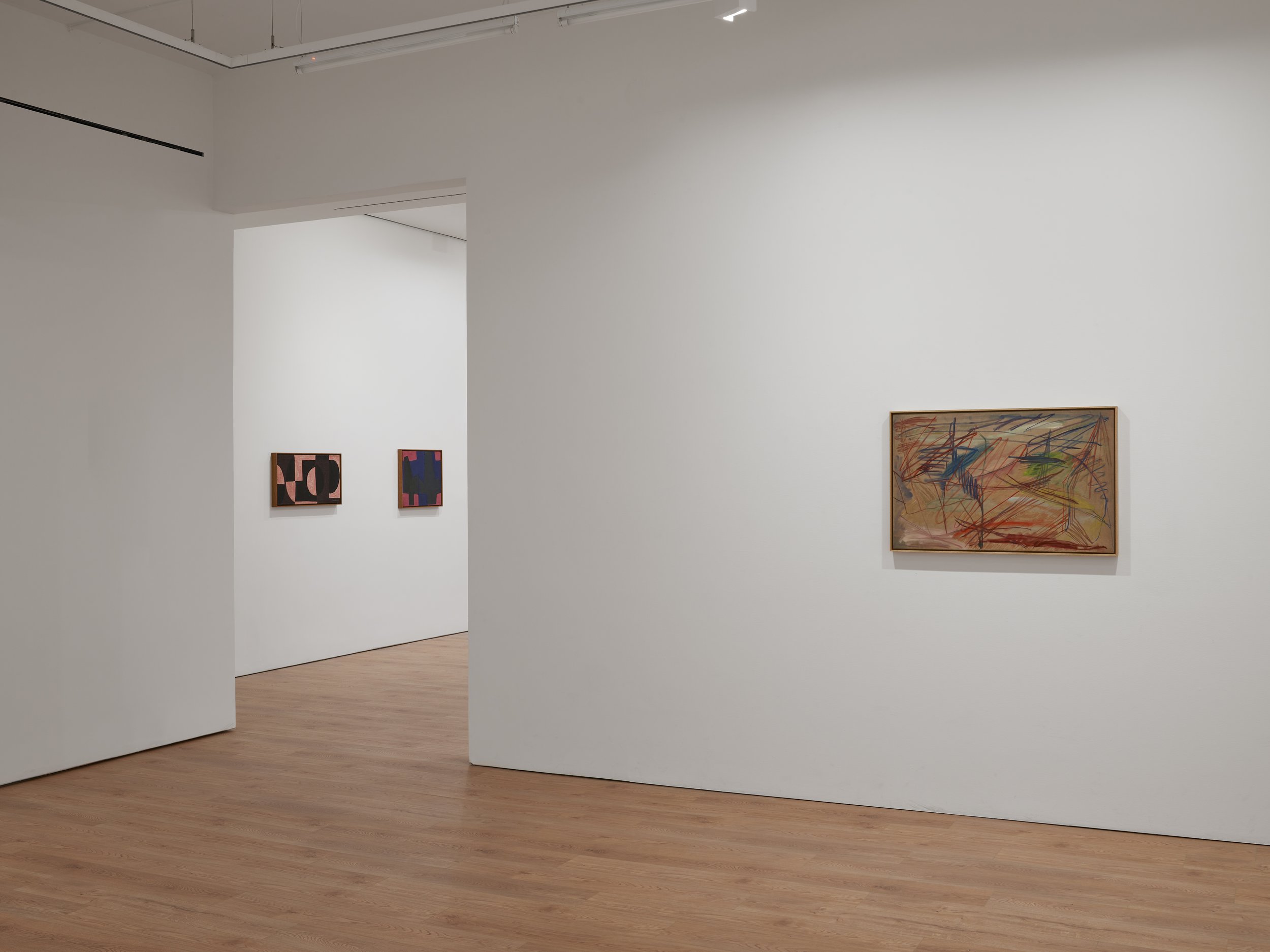
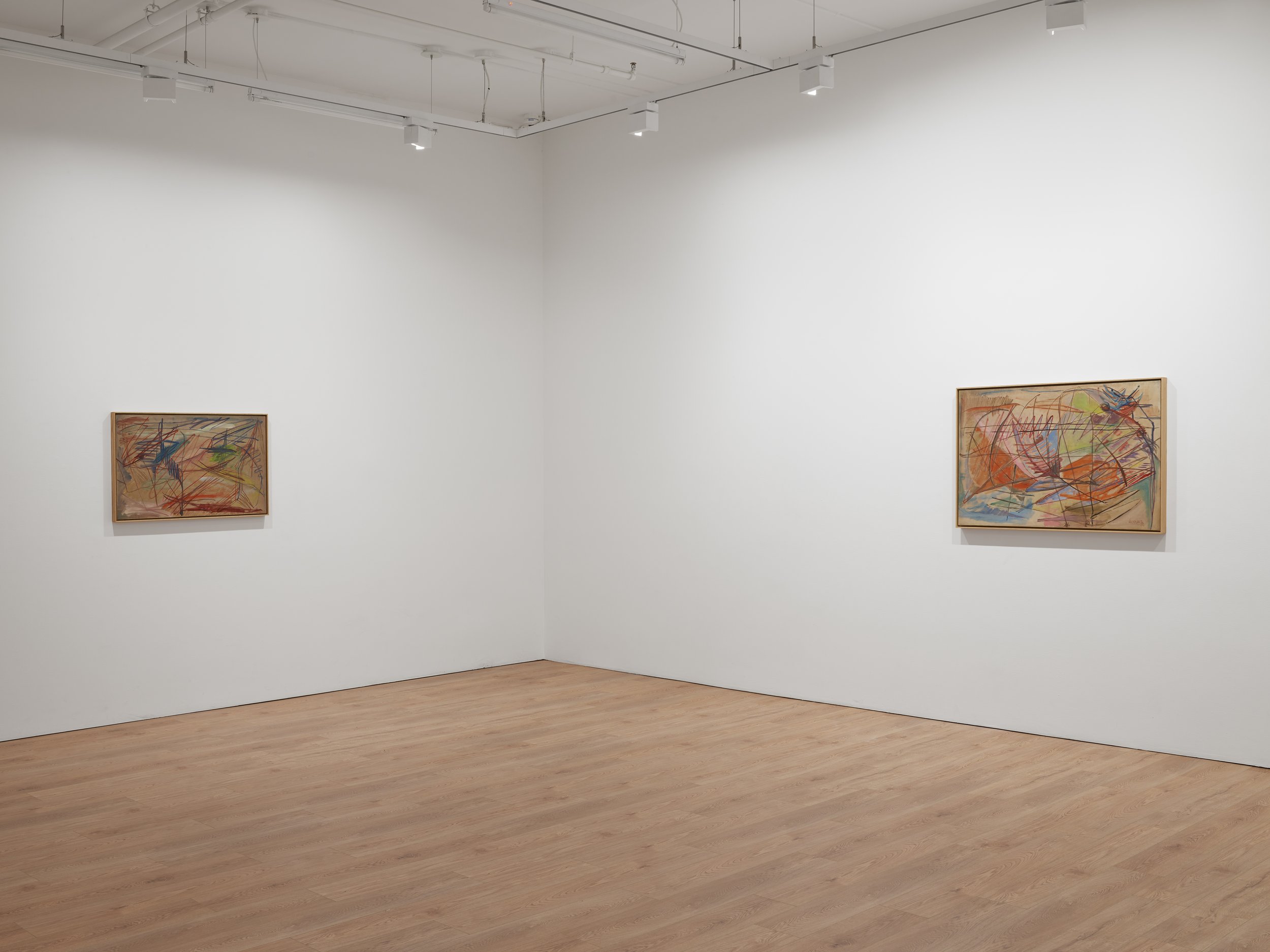
Exhibition view of ‘Carmen Herrera: The Paris Years, 1948 – 1953’ at Lisson Gallery, New York, 1 May – 1 August 2025 © Carmen Herrera, Courtesy Lisson Gallery
Herrera’s Habana Series marks a pivotal moment in the artist’s development, showcasing her experimentation with gestural abstraction and Informalism during a brief stay in New York in 1950, as argued by Roxane Ilias in her essay, “Carmen Herrera and the Paris School.” Created in response to transnational developments in Abstract Expressionism, these works contrast with the structured geometric compositions of her Paris paintings. Like others from this series, Conquete de l'air (1950) features spontaneous brushstrokes, unruly lines, amorphous forms, and vibrant colors applied without Herrera’s typical preparatory sketches. Modest in scale, the paintings emphasize a tactile graphic quality with thick, rough surfaces. Named after her first solo exhibition at Havana’s Lyceum and Lawn Tennis Club (December 1950 - January 1951), the series reflects Herrera’s synthesis of Tachisme and Expressionism, blending the gestural techniques of Hans Hartung with those of Jackson Pollock.
The exhibition also features Early Dynasty (1953), the largest painting from this period, which demonstrates Herrera’s ambition and evolving style. In this work, she layers multiple colors and geometric forms, referencing motifs from earlier paintings to create a composition in constant motion. The deep blue, mushroom-like form at the top left echoes a similar shape in other canvasses from this period including Logique Coloree No. 5 (1949) and The King in Jail, 1948 both on view in this exhibition. This tendency to revisit and refine geometric forms would become a hallmark of her later work, reinforcing her relentless pursuit of visual clarity and balance.
Carmen Herrera Way, 1950 Acrylic on Burlap 99.4 x 84.1 x 2.9 cm 39 1/8 x 33 1/8 x 1 1/8 in © Carmen Herrera, Courtesy Lisson Gallery
Herrera’s move back to New York in September 1953 presented challenges, as the art world’s gender and racial biases delayed her recognition. However, the radical developments of her Paris period laid the foundation for the rigorously precise, minimalist works that would define her later career. This exhibition builds on recent institutional recognition of Herrera’s artistic contributions during this period, including her inclusion in Women in Abstraction (Centre Pompidou, 2021–22) and Americans in Paris (Grey Art Museum, 2024). It also precedes Both Sides of the Line: Carmen Herrera and Leon Polk Smith, a major touring museum show curated by Dana Miller, who also curated Carmen Herrera: Lines of Sight at the Whitney Museum of American Art in 2016.
About the artist
Carmen Herrera was born in Havana, Cuba in 1915. She moved frequently between France and Cuba throughout the 1930s and 1940s; having started studying architecture at the Universidad de La Habana, Havana (1938–39), she trained at the Art Students League, New York (1942– 43), before exhibiting five times at the Salon des Réalités Nouvelles, Musée d’Art Moderne de la Ville de Paris, France (1949–53). She settled in New York in 1954, where she lived and worked until her death in 2022. Herrera’s work was the subject of a large-scale survey, Carmen Herrera: Lines of Sight, at the Whitney Museum of American Art, New York (2016), which travelled to the Wexner Center for the Arts, Columbus (2017) and Kunstsammlung Nordrhein-Westfalen (K20), Düsseldorf (2017–2018). Herrera premiered her Estructuras Monumentales, massive aluminium structures largely conceived in the 1960s and 1970s, at City Hall Park in New York City in 2019, organised by the Public Art Fund. Herrera’s large-scale mural, Verde, que te quiero verde (2020) was unveiled at the Blanton Museum of Art in Austin in May of 2023 as part of the museum’s grounds redesign. In March of 2024, an exhibition focusing on the last fifteen years Herrera's output opened at SITE Santa Fe, NM. Herrera's work was featured in Adriano Pedrosa's exhibition Straniere Ovunque - Foreigners Everywhere at the 60th International Art Exhibition of La Biennale di Venezia, 20 April - 24 November, 2024.
Herrera’s work is in numerous public and private collections including the National Gallery of Art, Washington DC; the Museum of Modern Art, New York; the Whitney Museum of American Art, New York; the Metropolitan Museum of Art, New York; the Tate Collection, London; Kunstsammlung Nordrhein-Westfalen (K20), Düsseldorf; the Guggenheim Abu Dhabi; El Museo del Barrio, New York; the Hirshhorn Museum, Washington DC; the Smithsonian American Art Museum, Washington DC; the Walker Art Center, Minneapolis; the Museum of Fine Arts Boston; the Pérez Art Museum, Miami; Crystal Bridges Museum of Art, Bentonville; the Cleveland Museum of Art, Cleveland; the Blanton Museum of Art, Austin; and the Morgan Library & Museum, New York.
About Lisson Gallery
Lisson Gallery is one of the most influential and longest-running international contemporary art galleries in the world. Today the gallery supports and promotes the work of more than 70 international artists across spaces in London, New York, Los Angeles, Shanghai and Beijing. Established in 1967 by Nicholas Logsdail, Lisson Gallery pioneered the early careers of important Minimal and Conceptual artists such as Art & Language, Carl Andre, Daniel Buren, Donald Judd, John Latham, Sol LeWitt, Richard Long and Robert Ryman among many others. It still works with many of these artists and others of that generation, from Carmen Herrera and Olga de Amaral to Hélio Oiticica and Lee Ufan. In its second decade the gallery introduced significant British sculptors to the public for the first time, including Tony Cragg, Richard Deacon, Anish Kapoor, Shirazeh Houshiary and Julian Opie. Since 2000, the gallery has gone on to represent many more leading international artists such as Marina Abramović, Ai Weiwei, John Akomfrah, Liu Xiaodong, Otobong Nkanga, Pedro Reyes, Sean Scully, Hiroshi Sugimoto and Wael Shawky. It is also responsible for raising the international profile of a younger generation of artists including Dana Awartani, Cory Arcangel, Garrett Bradley, Ryan Gander, Josh Kline, Hugh Hayden, Haroon Mirza, Laure Prouvost and Cheyney Thompson.
The exhibition opened on May 1 and will be on view until August 1, 2025, at the NYC location at 508 West 24th Street. The opening was held on May 1st and was held from 6 – 8 pm. For more information about this exhibition and others, please visit the Lisson Gallery here. The gallery can also be found on Facebook, YouTube, and Instagram.
Yukinori Yanagi: ICARUS
Yukinori Yanag The World Flag Ant Farm, 1990 Ants, colored sand, plastic boxes, plastic tubes, plastic pipes, monitors 180 boxes, 24 x 30 cm (each) Installation view, Benesse House Museum, Naoshima, Kagawa, Japan, 2008 Photo YANAGI STUDIO Collection of Benesse Holdings, Inc., Okayama
ICARUS opened on March 27 and will be on view until July 27, 2025, at Pirelli HangarBicocca they are pleased to present "ICARUS", the first major anthological exhibition in Europe dedicated to the art of Yukinori Yanagi, with a wide selection of key works from the 1990s and 2000s, as well as more recent works. Visitors will experience the unpredictable trajectories created by the Japanese artist. Yanagi will recontextualize some of his most significant and monumental installations in the former industrial spaces of Pirelli HangarBicocca, offering insights that are more relevant than ever on issues of nationalism, governance mechanisms, and the paradoxical aspects of contemporary societies.
Yukinori Yanagi (Fukuoka, 1959) lives and works on the Japanese island of Momoshima, far from the public eye, despite being one of the most influential contemporary Japanese artists. In 1993, he was invited to his first international exhibition, the 45th Venice Biennale, where he presented hundred eighty colored sand flags that crumbled day by day due to the unremitting work of thousands of live ants. Now, after thirty-two years, Yanagi returns to Italy with a major exhibition.
Known for exploring complex issues of sovereignty, globalization, and borders through large-scale, site-specific installations, the artist often delves into Japanese history whilst confronting universal themes of nationalism, the impact of modernization and technology on society. His modus operandi evokes the intricate systems of symbolic imagery and preconceived notions of political and national oppression, challenging their immobility and dissolving them into organic forms that are inherently mutable.
Yukinori Yanagi Atomic Clouds over Ground Zero (Left) From the Ground, Hiroshima, 8:30 am, August 6, 1945 (Right) From the Sky, Hiroshima, 8:30 am, August 6, 1945 Cyanotype exposed by the sun of 8:30 am, August 6, 2024, 2024 Installation view, Pirelli HangarBicocca, Milan, 2025 ©YANAGI STUDIO Courtesy the artist and Pirelli HangarBicocca, Milan Photo Agostino Osio
From 1988 to 1990 Yanagi studied at the Yale University where he was a student of Vito Acconci and Frank Gehry and, in this period, he was struck by conceptual art. He then left the United States in the 2000s to return to Japan where he continued developing his artistic practice whilst maintaining "wandering as a permanent position" as a recurring idea. This paradox evokes a sense of constant movement and change – often suggested in his work by the employment of organic and living materials – at the same time, this is contrasted against the permanence and stability of fixed, seemingly unchanging symbolic images.
"ICARUS" is the title of Yukinori Yanagi's exhibition, curated by Vicente Todolí and Fiammetta Griccioli, which brings together a series of site-specific, immersive works that chronicle the artist's career in the Navate and Cubo spaces of Pirelli HangarBicocca. The title evokes the Greek myth of Icarus and Daedalus which serves as a cautionary message as well as an invitation to reflect upon human arrogance born from overconfidence in technology. By getting too close to the sun (which the artist understands as a metaphor for nuclear energy), Icarus becomes responsible for his own downfall. The exhibition narrative presents visitors with a constant duality, establishing a dialogue between past and present, destruction and rebirth, reality and fantasy, matter and symbolism, movement and permanence. The idea of transcending physical boundaries, represented by elements such as containers, barrels and other objects used in transportation systems, becomes a metaphor for global interconnectedness.
Yukinori Yanagi Banzai Container, 2025 (detail) Installation view, Pirelli HangarBicocca, Milan, 2025 ©YANAGI STUDIO Courtesy the artist and Pirelli HangarBicocca, Milan Photo Agostino Osio
Some of Yanagi's provocative multimedia works are inspired by pop icons that shaped the collective imagination and global consciousness of the 1960s. The characters of Godzilla and Ultraman, emblems that emerge from the fusion of popular culture and industry, appear in works such as Banzai Container (2025), on view in the Pirelli HangarBicocca exhibition. Yanagi remembers, “[When I was a child] I loved TV shows and movies with the special effects of the time, such as Ultra- Q, Ultraman and Godzilla. These shows dealt with issues such as nuclear radiation, environmental pollution, the right to self-defense, and discrimination, and they had a strong effect on my subconscious mind as a boy.” Another integral part of Yanagi’s work is the reference to major landmark events, such as the bombing of Hiroshima. The atomic bomb, which has left an indelible and tragic mark on the historical memory of Japan and the world, is recreated in the form of an iron replica entitled Absolute Dud (2007). In this material form, the bomb no longer has the potential to destroy, but is presented as a physical reminder of the consequences of war and the abuse of power in the name of progress.
Yukinori Yanagi Project God-Zilla Onomichi U3, 2017 Mixed media, scraps from a demolished house, mirrors, acrylic, video, sound Installation view, Nishigosho Prefectural Warehouse No.3, Hiroshima, Japan, 2017 Photo YANAGI STUDIO
The exhibition opened with the work Project God-zilla 2025 - The Revenant from “ El Mare Pacificum" (2025). The large eye of Godzilla, a monster created and empowered by nuclear energy, is projected amidst an accumulation of debris and discarded objects, pieces of steel, wood, machine parts and sandbags. Recalling the pop character from Japanese cinema, the work refers to the environmental impact caused using nuclear weapons, creating a post-apocalyptic scenario that evokes a sense of mass destruction and emphasizes the vulnerability of nature and humanity. This monumental work is in dialogue with Article 9 (1994), composed of several neon structures scattered in the exhibition space that switch on and off intermittently. Visitors are encouraged to assemble words, phrases, and fragments in Japanese, distinguished by a vivid red color, which, when correctly arranged, recreate the text of Article 9 of the Japanese Constitution. In this clause which aspires to international peace, the renunciation of war and the use of force as means of resolving disputes with other nations are declared absolute and perpetual.
Yukinori Yanagi Icarus Container 2025, 2025 (detail) Installation view, Pirelli HangarBicocca, Milan, 2025 ©YANAGI STUDIO Courtesy the artist and Pirelli HangarBicocca, Milan Photo Agostino Osio
The central space of the Navate is filled with the monumental labyrinth of Icarus Container 2025 (2025), composed of several container modules and connected to a tower positioned outside the building, allowing natural light to enter. Visitors will be able to walk through this labyrinth, where they will encounter verses from the renowned poet Yukio Mishima’s poem “Icarus” – taken from his autobiographical essay “Sun and Steel” (1968) – engraved on mirrors that create a constant play of reflections. Inspired by the ancient Greek myth of Daedalus and Icarus, like the title of the exhibition, the immersive experience explores the consequences of human hybris and obsession with technological progress, leaving visitors with a sense of disorientation.
Yukinori Yanagi Hinomaru Illumination 2025, 2025 Installation view, Pirelli HangarBicocca, Milan, 2025 ©YANAGI STUDIO Courtesy the artist and Pirelli HangarBicocca, Milan Photo Agostino Osio
The exhibition tour continues with Hinomaru Illumination 2025 (2025), which reproduces the Japanese flag in a neon installation reflected in a body of water. The symbol of hinomaru, which literally means “circle of the sun”, spreads out in the liquid. In this way, the artist once again introduces a dynamic, changing component with the aim of challenging the stability of the symbol itself.
Yukinori Yanagi The World Flag Ant Farm 2025, 2025 Installation view, Pirelli HangarBicocca, Milan, 2025 ©YANAGI STUDIO Courtesy the artist and Pirelli HangarBicocca, Milan Photo Agostino Osio
Finally, the Cubo hosts the well-known work The World Flag Ant Farm 2025 (2025), which received international recognition when it was awarded the “Aperto 93” prize at the 45th Venice Biennale. The work is composed of two hundred flags representing the 193 states recognized by the United Nations and 7 non-UN members such as Taiwan, Tibet, and Palestine. The flags are made of colored sand meticulously placed in transparent Plexiglas boxes. The boxes are connected by plastic tubes, in which thousands of ants create paths by carrying grains of sand from one box to another, slowly dissolving the borders and the flags themselves as symbols of national identity. The path of the ants ironically exposes the fragility of these symbols, transforming their static forms into an enormous, active “ant farm”, as the title of the work suggests.
Portrait by Hideyo Fukuda
The artist
Yukinori Yanagi has exhibited his work at many leading institutions, including Tsunagi Museum, Kumamoto (2019); Bank-ART 1929, Tokyo (2016); Inujima Art House Project, Okayama (2010); Inujima Seirensho Art Museum, Okayama (2008); Fukuoka Art Museum (2005); Hiroshima City Museum of Contemporary Art (2000); University Art Gallery, University of California, Irvine (1998); Chisenhale Gallery, London, Beaver College Art Gallery, Philadelphia, Fabric Workshop and Museum, Philadelphia (1997); Capp Street Project, San Francisco (1996); Queens Museum of Art, New York, Kirin Plaza Osaka, Wadsworth Atheneum Museum of Art, Hartford, University Art Museum, University of California at Santa Barbara (1995); Naoshima Contemporary Art Museum, Japan (1992); Los Angeles Contemporary Exhibitions – LACE (1991). His work has also been included in numerous group exhibitions, such as Setouchi Triennale, Japan (2022); Diriyah Contemporary Art Biennale, Saudi Arabia (2021); 21. Biennale of Sydney (2018); Yokohama Triennale, Japan (2017); Busan Biennale, South Korea (2016); Liverpool Biennial (2012); Fukuoka Triennale, Japan, Gwangju Biennale (2002); Whitney Biennial, New York (2000); Biennale de Lyon (1997); Asia-Pacific Triennial, Brisbane (1996); Nagoya International Biennial, Japan; Venice Biennale (1993).
Large-scale projects in Japan
Beginning in the 2000s, Yanagi began to distance himself from the market mechanisms that govern contemporary art, as he recalls “I became disturbed by the commercialization of contemporary art. […] I felt there was something insidious about the American economy, which was expanding rapidly while the gap between rich and poor grew wider, so I closed my studio in San Francisco and pulled out of the United States”. He then returned to Japan to devote himself to long-term, large-scalev projects on a number of islands south of the Japanese peninsula: his goal was to transform them entirely into works of art. The artist creates works that have a decisive, real impact on the society that receives them, distancing himself from the mechanisms of the art system and focusing on the needs of the context in which he works. As he explains, “the guiding concept is an encounter with the everyday lives of the island people, who live in a landscape that includes art as well as the traditional gods. The overall aim is a revitalization of the community.” The artist’s fascination with inaccessible and geographically remote areas had already led him to develop a site-specific project on Alcatraz Island, the famous U.S. prison off the coast of San Francisco, in 1996. There, Yanagi created several installations that explored the definition of boundaries and the understanding of space as a process of identity creation.
The artist has developed large-scale public art projects that aim to breathe new life into abandoned spaces. One of the most ambitious is the Inujima Seirensho Art Museum, a former copper refinery that the artist transformed into a museum powered by renewable energy in 2008. The building houses several of his permanent installations on Inujima, Okayama, an island that was otherwise destined to become a landfill of industrial waste.
In 2012, Yukinori Yanagi founded Art Base Momoshima, an art center on the small island of Momoshima in the middle of the Seto Inland Sea, where the artist currently resides. Here, he has renovated and transformed a former 1950s middle school and cinema into a contemporary art museum, exhibiting his works alongside those of other artists he admires.
Major project underway in Korea
In 2025, Yukinori Yanagi's project called the Anjwa-Do Project will be developed on the island of Anjwa, Korea. It involves the opening of a floating museum dedicated to the artist's work, designed by YANAGI + ART BASE, a collaborative team lead by Yanagi. Architecture and art come together in this project, which involves the creation of seven floating cubes of different sizes, representing both the islands of the Jeollanam-Do Province and the number of continents on Earth. The works, linked to the history of the Korean peninsula, will create a dreamlike and disorienting environment where space and time dissolve into reflections in the water.
Catalog
The exhibition is accompanied by a monograph published by Marsilio Editori. The volume explores the recurring themes that have shaped Yukinori Yanagi's career and delves deeper into the influences and evolution of his practice throughout his career. The volume includes essays by international scholars and critics, including curator Mami Kataoka and art historian Reiko Tomii, as well as a conversation between Yanagi and Vicente Todolí and Fiammetta Griccioli, curators of the exhibition at Pirelli HangarBicocca. The book will also contain for the first time an overview of the most ambitious architectural projects realized by the artist between 2008 until today. The works on display will also be accompanied by detailed fact sheets written by scholars and enriched with a selection of historical images.
Pirelli HangarBicocca
Pirelli HangarBicocca is a non-profit foundation dedicated to producing and promoting contemporary art. It was conceived and is supported by Pirelli. Established in 2004, Pirelli HangarBicocca has become a benchmark institution for the international art community, local public and region. It is a museum that is free of charge, accessible and open, and a place for experimentation, research and dissemination, where art is a point of reflection on the most topical themes of contemporary culture and society.
It caters to a broad and diverse public with a programme of major solo exhibitions by both Italian and international artists, a multi-disciplinary program of accompanying events and in-depth discussions, theoretical and informational publications, and educational courses. A team of museum facilitators is on hand at all times to help the public connect with the art. Vicente Todolí has been the foundation’s artistic director since 2012.
Situated in a former industrial building, once a locomotive manufacturing facility, Pirelli HangarBicocca occupies 15,000 square metres, making it one of the largest single-level exhibition spaces in Europe. This vast area comprises the Shed and Navate spaces, which are used for temporary exhibitions, and the permanent display of Anselm Kiefer’s The Seven Heavenly Palaces 2004-2015. This monumental installation with seven reinforced concrete towers has become one of the most iconic works in Milan. While since 2010 La Sequenza (1971-1981), a work by sculptor Fausto Melotti, has been located in the outdoor garden at the entrance of Pirelli HangarBicocca.
The building also houses a number of services for the public: a spacious entrance with reception area, facilities for educational activities, space for conferences and meetings, bookshop and bistro with a charming outdoor area.
For more information about this exhibition and others at Pirelli HangarBicocca please visit their site here. Pirelli can also be found on Facebook, Instagram, YouTube, Spotify, and Pinterest.
Carolee Schneemann
Carolee Schneemann Souvenir of...Tyre...Sidon...Damour (for Bruce McP.), 1982 Diptych, acrylic paint, mylar, fabric, photographs, glass, collaged on board, aluminium frame 295.9 x 174.6 x 6.4 cm 116 1/2 x 68 3/4 x 2 1/2 in © Carolee Schneemann Foundation, Courtesy Lisson Gallery
Lisson Gallery is pleased to announce its first exhibition with Carolee Schneemann (1939–2019), one of the boldest and most influential artists of the twentieth and early twenty-first centuries, whose foundation has been represented by the gallery since October of last year. This inaugural show also marks the artist’s first solo exhibition in Los Angeles. Known for her groundbreaking and multidisciplinary practice, which spanned six decades, Schneemann challenged societal and artistic conventions by using her own body and diverse media to address issues of sexual expression, gender, politics, and war.
Carolee Schneemann Pixels Escaping T.V., 1987 Paint and crayon on paper 58.4 x 88.9 cm 23 x 35 in © Carolee Schneemann Foundation, Courtesy Lisson Gallery
The exhibition focuses on Schneemann’s work two decades into her career, centering on a unique multimedia installation engendered by a dream she had while visiting Los Angeles in the summer of 1985. In the dream, Schneemann envisioned round, rock-like shapes reminiscent of Monet’s Water Lillies, floating in the distance. The resulting piece, Video Rocks (1987), shown at Lisson for the first time in its entirety, consists of 180 discs, each roughly the size and shape of a cow dung pat, spread across the floor in a shallow mound. At the head of this mound, five video monitors have been arranged in a row. Each screen plays staggered filmed scenes that allude to the preceding sculptural landscape — footage of people and animals crossing the rocks. Building on the self-reflexive explorations of embodiment and personal narrative she had established in her early 8mm and 16mm films such as Fuses (1965), Plumb Line (1968–71) and Kitch’s Last Meal (1973–76), Video Rocks marks a pivotal moment in Schneemann’s practice. This immersive, multifaceted work was last exhibited in the United States nearly thirty years ago during her solo show Carolee Schneemann: Up to and Including Her Limits at the New Museum in New York.
Carolee Schneemann Untitled, 1981 Watercolor on paper Each: 35.6 x 43.2 cm Each: 14 x 17 in © Carolee Schneemann Foundation, Courtesy Lisson Gallery
Alongside this installation, the exhibition includes a series of drawings that Schneemann simultaneously created to document the imagery and possible configurations of Video Rocks—expressive sketches in paint, crayon, and marker that capture the artist’s sources and methods. A selection of these works, including a 31 ½-foot-wide painting of pink and yellow floral forms that hangs horizontally on the adjacent wall—a reference to the water lilies in Schneemann’s dream—is also on display. Framing the entire assemblage in the gallery are five acrylic light rods suspended from the ceiling, illuminating the rocks below and adding another layer of lyricism to this ‘dream/vision’ space, as the artist described it.
Carolee Schneemann Video Rocks as Column, 1989 Watercolor, marker, and crayon on paper Un-Folded 106.7 x 129.5 cm Un-Folded 42 x 51 in © Carolee Schneemann Foundation, Courtesy Lisson Gallery
The exhibition also features works from Schneemann’s Lebanon Series (1981–1999), including Souvenir of...Tyre... Sidon...Damour (for Bruce McP.) (1982), a tactile collaged painting that blends and abstracts personal and political imagery to address the violence of the Lebanese Civil War and its aftermath. The Dust Paintings (1983–86), also part of the Lebanon Series, are abstract compositions that incorporate circuit boards, silkscreened images, nails, glass particles, ash, and other materials. These works reflect Schneemann’s long-standing engagement with political atrocities, such as her protest film Viet-Flakes (1965), connecting to her early experiments with painting and collage in the 1950s and 1960s. The Dust Paintings reinforce her deep material exploration, with rag paper surfaces layered with paint, string, vegetable dye, and glass.
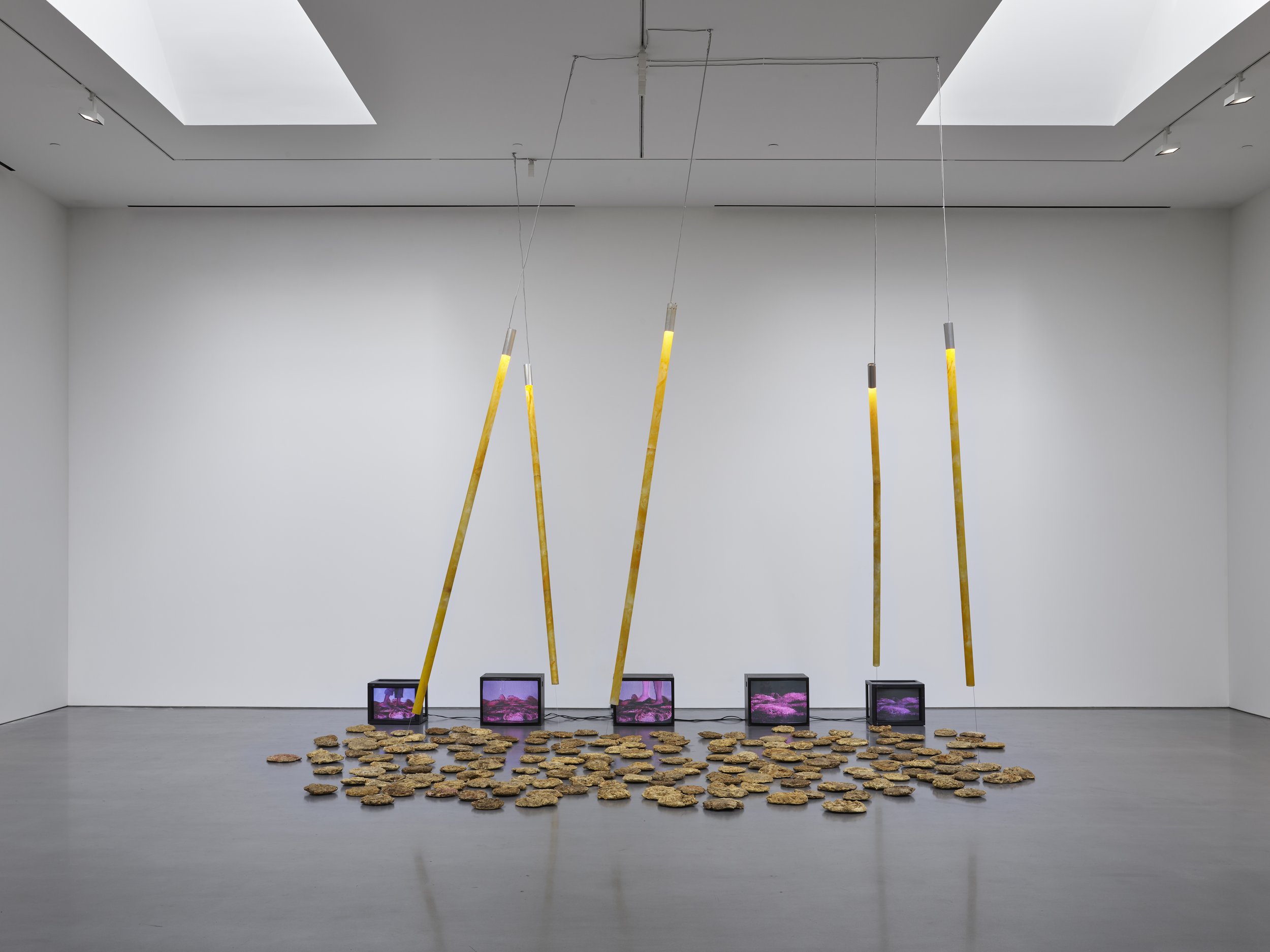


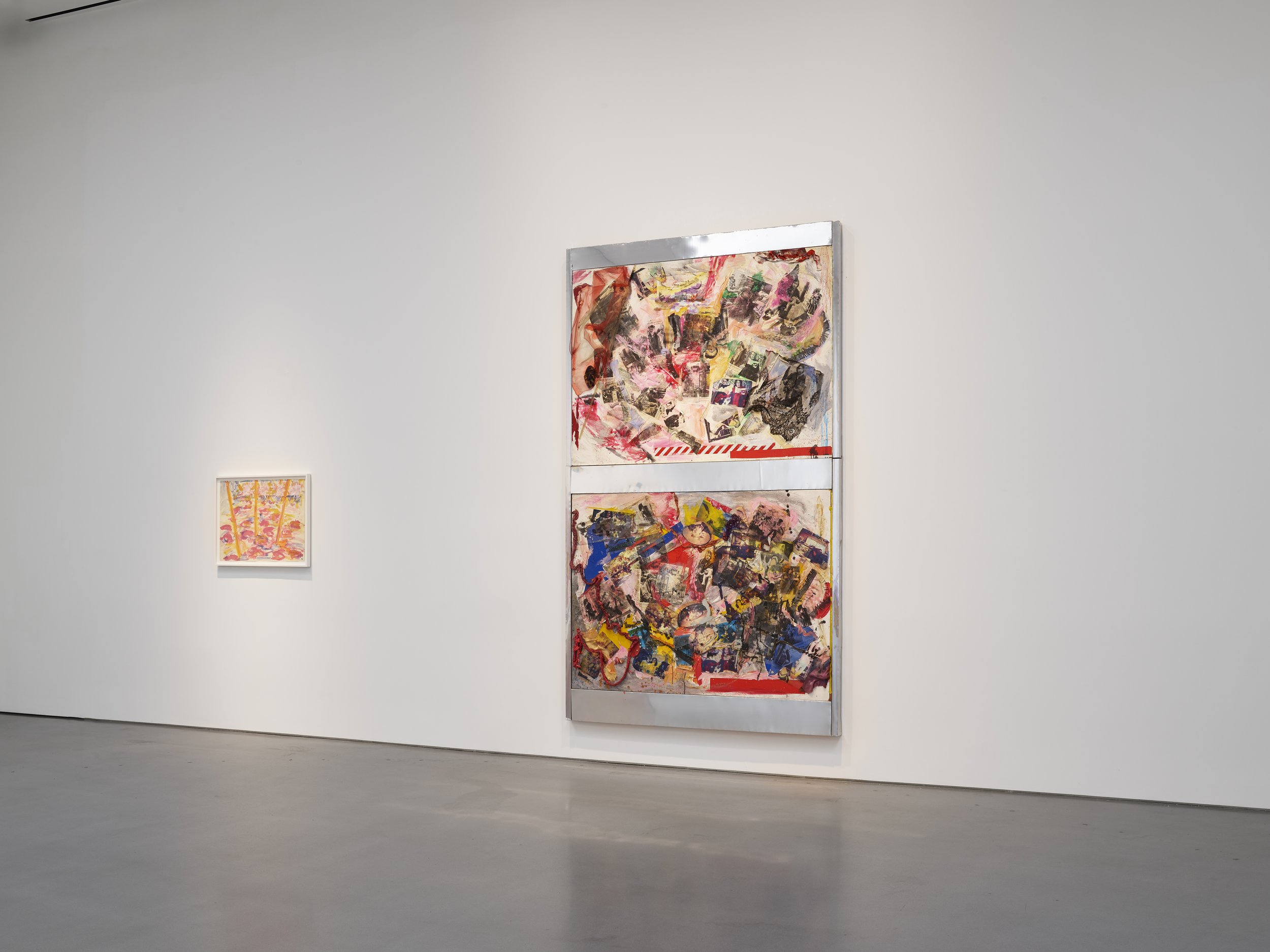
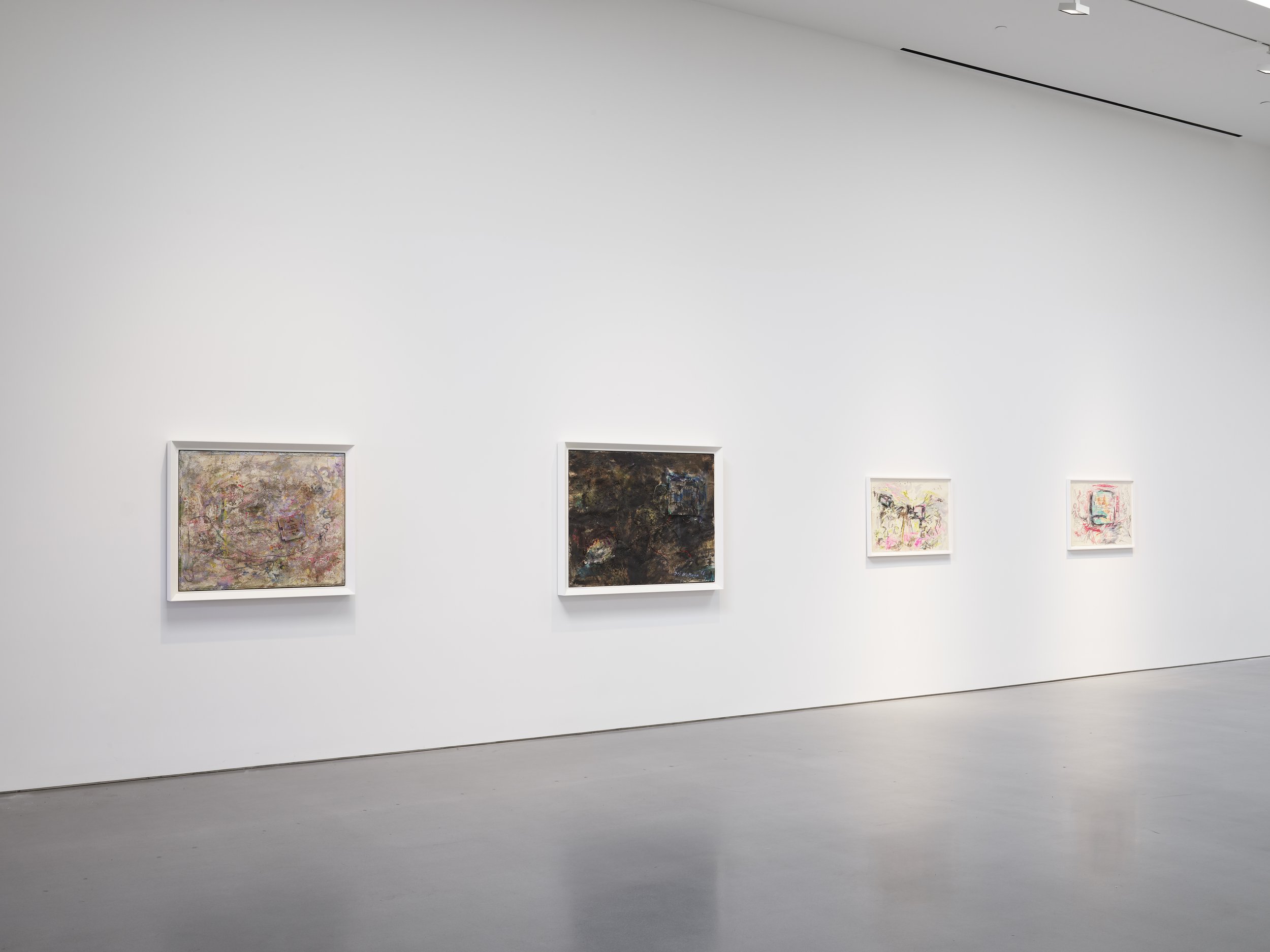
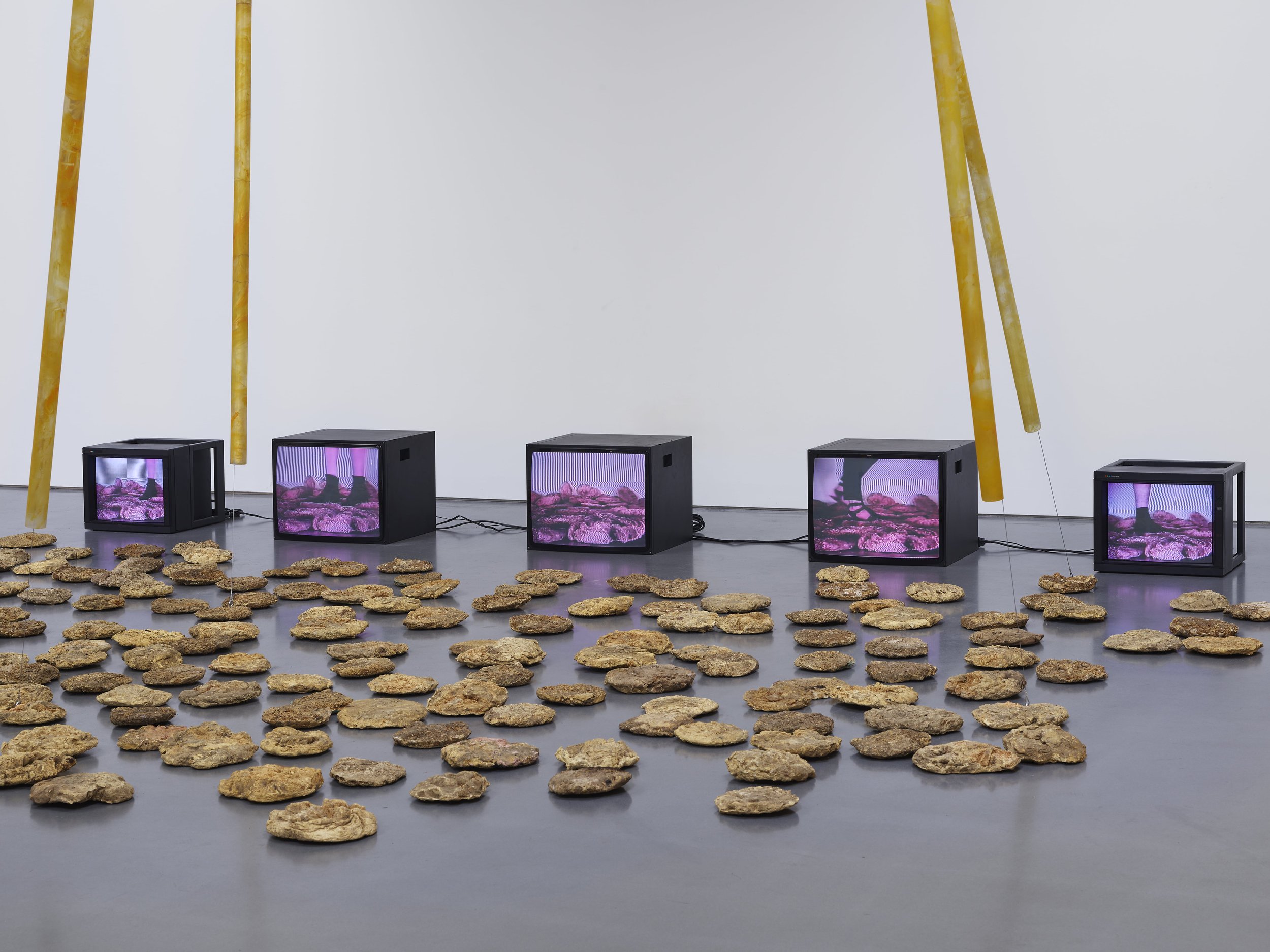
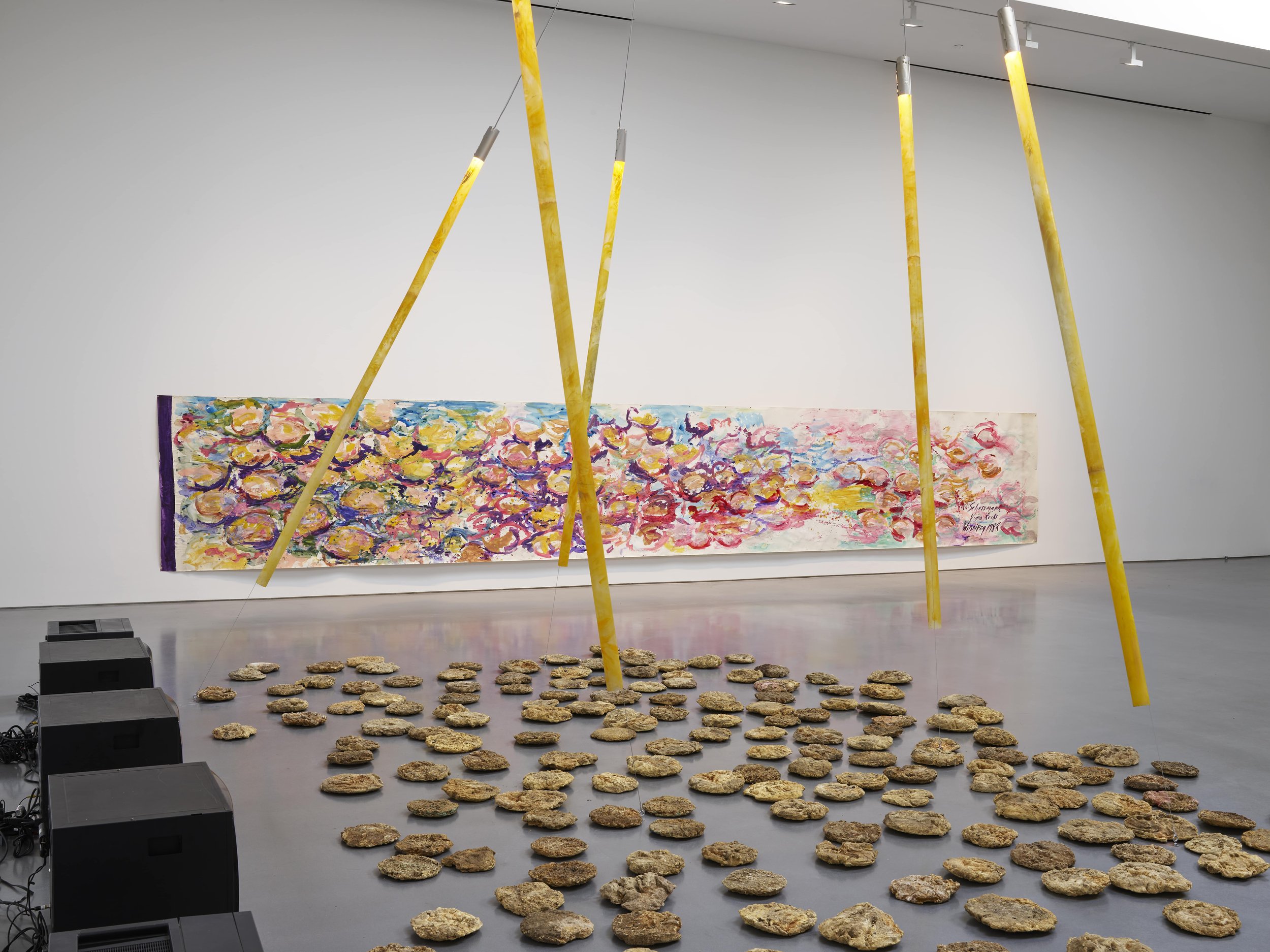
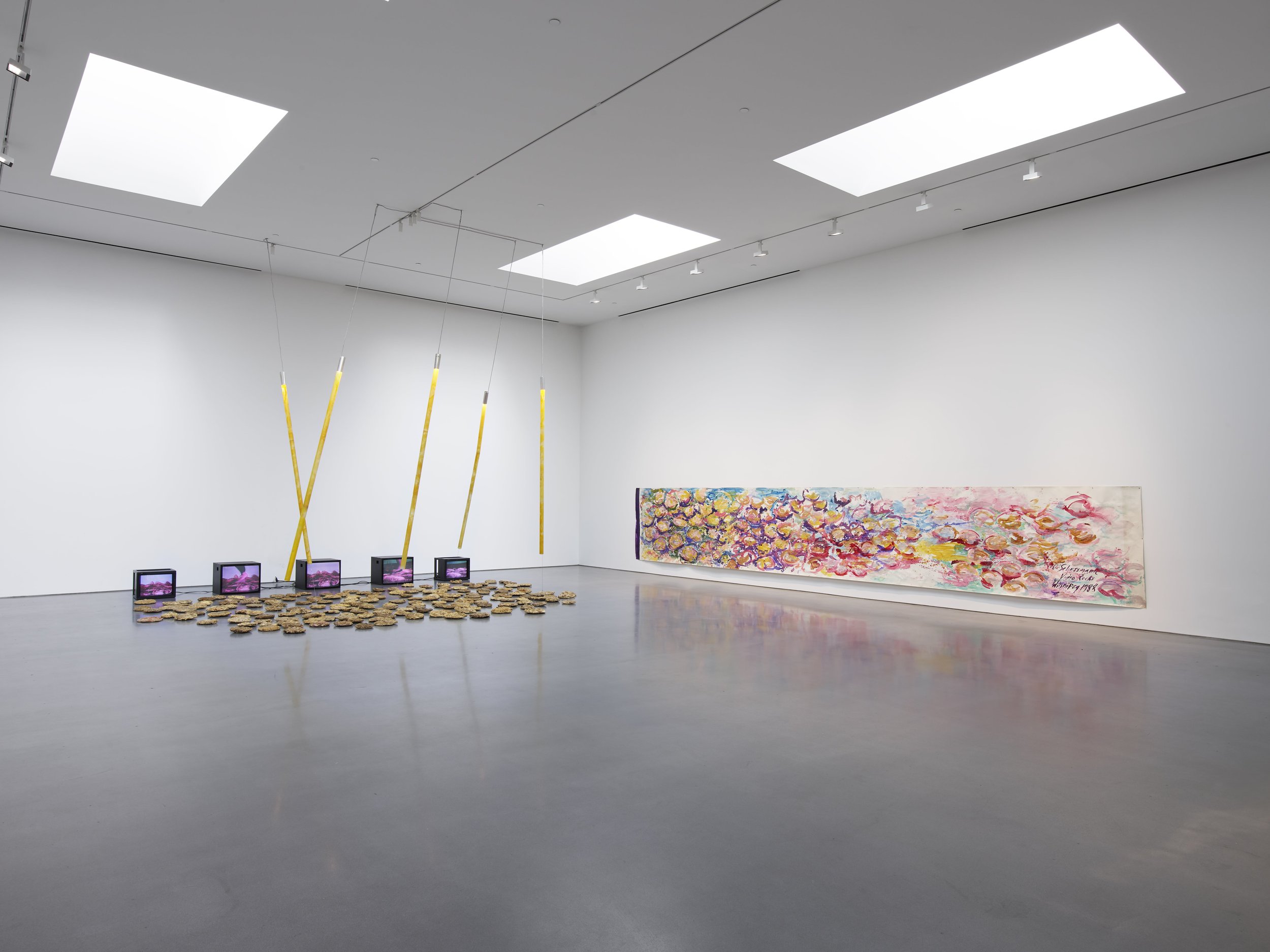
Exhibition view of ‘Carolee Schneemann’ at Lisson, Gallery Los Angeles, 11 April – 24 May 2025 © Carolee Schneemann Foundation, Courtesy Lisson Gallery
If Video Rocks was Schneemann’s early attempt to merge her video works with sculpture, the Dust Paintings represent another instance of her desire to fuse and disrupt artistic mediums. Just as her early investigations aimed to break free from static, traditional forms, these later works reflect her continued efforts to create a dynamic and unfolding artistic oeuvre.
About the artist
Carolee Schneemann (1939–2019) employed various artistic media and objects to develop a rich and influential body of work concerning politics, narrative, sexuality and the representation of women in art and society. Emerging from experimental film, dance, poetry, Fluxus, Happenings and environments, the artist’s early painting, collage, assemblage and box constructions were partly an effort to free artistic practice from the static object. Incorporating her nude body into performances extended that investigation into the liberation of the female image. Known for her legendary, visceral and taboo performances, including Meat Joy (1964), Up to and Including Her Limits (1973–76), and Interior Scroll (1975), Schneemann paved the way for generations of feminist artists. She documented her performances using film, created kinetic painting-sculptures and video art on such diverse topics as gender, eroticism, desire, disasters and war.
Schneemann received her BA from Bard College, Annandale-On-Hudson, NY and an MFA from the University of Illinois, Urbana, IL. Recent selected solo exhibitions include body-house: Dialogues between Carolee Schneemann, Diego Bianchi and Márcia Falcão, Pivô, São Paulo, Brazil (2024); Carolee Schneemann: Body Politics, Barbican Art Gallery, London, UK (2022); After Carolee: Tender and Fierce/Carolee’s Room, Artpace, San Antonio, TX, USA (2021); Paint Like I Move (Precarious), les Abattoirs, Toulouse, France (2017); and Kinetic Painting, Museum der Moderne Salzburg, Austria (2015); Museum für Moderne Kunst, Frankfurt, Germany (2017); MoMA P.S.1 (2017). In 2017, she was awarded the Golden Lion for Lifetime Achievement at the 57th International Art Exhibition of La Biennale di Venezia, Venice, Italy.
About Lisson Gallery
Lisson Gallery is one of the most influential and longest-running international contemporary art galleries in the world. Today the gallery supports and promotes the work of more than 60 international artists across spaces in London, New York, Los Angeles, Shanghai and Beijing. Established in1967 by Nicholas Logsdail, Lisson Gallery pioneered the early careers of important Minimal and Conceptual artists, such as Art & Language, Carl Andre, Daniel Buren, Donald Judd, John Latham, Sol LeWitt, Richard Long and Robert Ryman among many others. It still works with many of these artists as well as others of that generation from Carmen Herrera to the renowned estate of Leon Polk Smith. In its second decade the gallery introduced significant British sculptors to the public for the first time, including Tony Cragg, Richard Deacon, Anish Kapoor, Shirazeh Houshiary and Julian Opie. Since 2000, the gallery has gone on to represent many more leading international artists such as Marina Abramović, Ai Weiwei, John Akomfrah, Susan Hiller, Tatsuo Miyajima and Sean Scully. It is also responsible for raising the international profile of a younger generation of artists led by Cory Arcangel, Ryan Gander, Van Hanos, Hugh Hayden, Haroon Mirza, Laure Prouvost, Pedro Reyes, Wael Shawky and Cheyney Thompson.
The exhibition opened on April 11th and will run through to the 24th of May at the Los Angeles location. For more information about this exhibition and others, please visit the Lisson Gallery here. The gallery can also be found on Facebook, YouTube, and Instagram.
Collection in Focus: The Reach of Faith Ringgold
Tschabalala Self, Sprewell, 2020. Acrylic paint, denim jeans, fabric, painted paper, newsprint, wood block print, transfer print with gel medium, felt-tip pen, and thread on canvas 84 1/8 ×72 1/4 ×2 1/4 in.(213.7 ×183.5 ×5.7 cm). Solomon R. Guggenheim Museum, New York, Gift, Galerie Eva Presenhuber, Zurich and New York, and the artist2021.3© Tschabalala Self.Photo: Hyla Skopitz
(NEW YORK, NY) The Guggenheim New York presents the Collection in Focus exhibition centering one of the most important works by the renowned artist, writer, and activist Faith Ringgold. The Reach of Faith Ringgold will spotlight Woman on a Bridge #1 of 5: Tar Beach (1988), the first in a series of five monumental quilts that tells the story of a young girl who soars from her Harlem rooftop, celebrating her own freedom and self-possession. Looking to one key work, the exhibition explores Ringgold’s critical position in the canon of art history, building off the modernists who preceded her, and inspiring those who followed.
Marking the Guggenheim’s first presentation of Woman on a Bridge #1 of 5: Tar Beach (1988), The Reach of Faith Ringgold will investigate her artistic forerunners and the lasting impact she has had on subsequent generations of artists. Tar Beach will be contextualized within the broader narrative of modern and contemporary art through works from the Guggenheim New York’s collection and the Peggy Guggenheim Collection. The exhibition will include pieces by modernists such as Marc Chagall, Jacob Lawrence, and Pablo Picasso, who preceded or were contemporaries of Ringgold, and contemporary American artists such as Sanford Biggers, Tschabalala Self, Mickalene Thomas, and Carrie Mae Weems whose work reflects her legacy.
Jacob Lawrence, Tragedy and Comedy,1952. Tempera on masonite,24 ×30 in.(61 ×76.2 cm).Solomon R. Guggenheim Museum, New York, Gift, Elizabeth R. and Michael M. Rea Collection2023.45 © 2025 Artist Rights Society(ARS), New York. Photo: Ariel Ione Williams
“Ringgold left an indelible imprint on the art world through her practice and activism,” states Naomi Beckwith, Deputy Director and Jennifer and David Stockman Chief Curator, “and she also activated millions of children’s imaginations through her contributions as an author. The Guggenheim New York is utterly thrilled to center one of Ringgold’s iconic artworks, which was the subject of one of her award-winning books, in an exhibition that is sure to delight our visitors of every age.”
Another highlight of this exhibition is a painting by Jacob Lawrence, Tragedy and Comedy (1952), the first work by the artist acquired by the Guggenheim and one of the earliest modernist works by a Black artist in its collection. This exhibition marks its debut at the Guggenheim.
Ringgold is known for her distinctive artistic technique that blends a variety of media and styles, most famously through her “story quilts.” She often combines painting, fabric, and quilting, resulting in a unique fusion of fine art and craft. Ringgold paints her scenes onto large, quilted canvases using bold colors, intricate patterns, and layered textures. The quilts themselves are not only visually striking but are deeply symbolic, reflecting the African American tradition of storytelling through fabric. The process involves hand stitching and sewing, a craft historically associated with women and often tied to cultural heritage, which Ringgold reinvents to explore themes about race, identity, gender, and history.
Sanford Biggers, Poly, 2023.Antique quilt and fabric,90 ×51 ×6 1/2 in.(228.6 ×129.5 ×16.5 cm).Solomon R. Guggenheim Museum, New York, Purchased with funds contributed by the Young Collectors Council and the International Directors’ Council, with additional funds contributed by an anonymous donor 2023.87© Studio Sanford Biggers. Courtesy of the artist and Marianne Boesky Gallery, New York and Aspen.Photo: Ariel Ione Williams
In addition to quilting, Ringgold employs painting and collage, incorporating text and imagery to narrate ends. Her style draws from both folk art and modernist traditions, bringing together abstraction with figurative elements. Ringgold’s work is influenced by her desire to merge art with activism, offering social commentary on issues like civil rights, feminism, and the African American experience. This blend of techniques allows her to create powerful visual statements that engage viewers both emotionally and intellectually. In
The Reach of Faith Ringgold, visitors will have the opportunity to see the museum’s permanent collection, speaking to Ringgold’s unique position in the history of American art.
Photo: Faith Ringgold, Woman on a Bridge #1 of 5: Tar Beach, 1988. Acrylic paint, canvas, printed fabric, ink, and thread, 74 5/8 × 68 1/2 in.(189.5 × 174 cm). Solomon R. Guggenheim Museum, New York Gift, Mr. and Mrs. Gus and Judith Leiber 88.3620 © 2025 Anyone Can Fly Foundation/Artists Rights Society (ARS), New York. Photo: Ariel Ione Williams
This exhibition is the third installment in a new exhibition series, Collection in Focus. The series is part of a reinvigorated effort to make the Guggenheim’s world-renowned holdings more accessible to the public.
The Reach of Faith Ringgold is organized by Naomi Beckwith, Deputy Director and Jennifer and David Stockman Chief Curator.
About Faith Ringgold
(b. 1930, New York; d. 2024, Englewood, New Jersey) earned a bachelor’s degree from City College of the City University of New York in 1955 and a master’s degree from City College in 1959. Her artwork resides in over fifty prominent public collections, including the Metropolitan Museum of Art, New York; Museum of Modern Art, New York; Brooklyn Museum, New York; Philadelphia Museum of Art; Smithsonian Institute of Art, Washington, DC; Baltimore Museum of Art; High Museum of Art, Atlanta; Newark Museum; Art Institute of Chicago; and St. Louis Art Museum. Her achievements as an artist, teacher, author, and activist have been recognized with numerous honors, including the National Endowment for the Arts awards in sculpture and in painting; a John Simon Guggenheim Memorial Foundation Fellowship; an NAACP Image Award; a Caldecott Honor; a Peace Corps Award bestowed by former President Barack Obama; and 16 honorary doctorates.
Support
Visionary support for Collection in Focus is provided by Aleksandra Janke and Andrew McCormack.
The Leadership Committee for The Reach of Faith Ringgold is gratefully acknowledged for its generosity, with special thanks to Laura Clifford.
About the Guggenheim New York
The Solomon R. Guggenheim Foundation was established in 1937 and is dedicated to promoting the understanding and appreciation of modern and contemporary art through exhibitions, education programs, research initiatives, and publications. The international constellation of museums includes the Guggenheim New York; the Peggy Guggenheim Collection, Venice; Guggenheim Bilbao; and the future Guggenheim Abu Dhabi. An architectural icon and “temple of spirit” where radical art and architecture meet, the Guggenheim New York is now among a group of eight Frank Lloyd Wright structures in the United States recently designated as a UNESCO World Heritage site.
The Exhibition: Collection in Focus: The Reach of Faith Ringgold will be at the Guggenheim New York location at 1071 Fifth Avenue, New York, Tower Level 4, Mapplethorpe Gallery, and will open May 9 through September 14, 2025. To learn more about the museum, this exhibit, past exhibits, current exhibits, upcoming exhibits, and the Guggenheim’s activities around the world, visit here. The museum can also be found on YouTube, TikTok, X, Facebook and Instagram.
Claudia Doring Baez: My Brother's Mind









Installation view of Claudia Doring Baez: My Brother's Mind at Friedrich Pontone New York, 2025. Courtesy of Friedrich Pontone, New York
Friedrichs Pontone announces solo exhibition, My Brother’s Mind, featuring a series of paintings by Claudia Doring Baez. Friedrichs Pontone is pleased to present My Brother ' s Mind, Claudia Doring Baez 's first exhibition with the gallery. Inspired by the 1975 Italian film The Night Porter and her late Brother ' s photography, Doring Baez portrays expressionistic mastery and provocative sequences. The exhibition will open on April 4th, 2025, and will be on view through May 3rd, 2025.
Claudia Doring Baez My Brother's Mind, Night Porter, "Sighing", 2024 Oil on canvas 18 x 24 in45.7 x 61 cm
With the lust of hopeless romantics, we pursue the dead, trying to enter from all angles, seeking the meaning and message that would make the kaleidoscopic truth of their lives stand still enough that we could hold it to our chests and breathe easy.
Claudia Doring Baez My Brother's Mind, Paris, 2024 Oil on canvas 11 x 16 in 27.9 x 40.6 cm
Doring Baez and her brother not only shared a common past but a collaborative relationship that flourished until his untimely death in 2016. Together they explored the act of capturing life, not only through the films they produced and directed as a team, but in their individual work, as painter and photographer.
Every Sunday at the tender ages of ten and twelve the Dorings sat with their parents at the screening room of the Cineteca National (National Movie theater) Torta de los guajolotes (a pulled pork sandwich) and Coca-Cola in hand, taking in the classic cinema of their time. Watching the work of Godard, Passolini, Fellini, Antonioni, and Cavani imprinted the indelible visual stamp that marked the siblings, teaching them the power of the visual and impressing their young minds with the aesthetics they would return to again and again.
Claudia Doring Baez My Brother's Mind, Night Porter, Genevieve Liberté II, 2024 Oil on canvas 60 x 60 in 152.4 x 152.4 cm
My Brother ' s Mind reunites the artist with her desire to know her brother more deeply than anyone can ever know another person. She wishes to discover, in his death, the drive that led him to capture the female figure in an aesthetic very akin to many of the women from the films they saw in that cinema. The title stuns us with its quixotic flare: how can anyone enter anyone else ' s mind? Yet death propels us to try to do just that.
Claudia Doring Baez, My Brother's Mind I, 2024 Oil on canvas 18 x 18 in 45.7 x 45.7 cm
This is Friedrichs Pontone’s third exhibition of 2025, and will run alongside Kristi Kongi’s solo presentation, Twilight in the Garden.
About Friedrichs Pontone
Friedrichs Pontone was established in 2022, opening its flagship gallery at 273 Church Street in the historic Tribeca gallery district, directly across from Barnett Newman Triangle. The gallery is dedicated to showcasing a diverse range of contemporary art, representing artists from Europe, Korea, and the United States. Its program reflects a commitment to both emerging and established talents, fostering cross-cultural artistic dialogue. Friedrichs Pontone is led by founders Martin Friedrichs and Domenic Pontone, who bring a combined 40 years of experience to the gallery. Martin Friedrichs previously served as director at two prestigious international galleries, while Domenic Pontone is the founder of Pontone Gallery London and the director of The Albemarle Gallery London.
For more information about this exhibition and others at Friedrich Pontone, please visit their site here. The gallery can also be found on Instagram and Artsy.
REZA ARAMESH: Fragment of the Self
Reza Aramesh, Action 172: Study of the Head as Cultural Artifact, 2016 - 2025, pigment print on Hahnemuhle photo rag Baryta paper (315 gsm), 69 1/8” x 57”
Night Gallery is delighted to present Fragment of the Self, an exhibition of new work by Reza Aramesh. The artist will exhibit four new series across various materials and processes. This is Aramesh’s debut solo exhibition in Los Angeles and with the gallery, following our co-presentation, with Dastan Gallery, of his 2023 sculpture Site of the Fall: Study of the Renaissance Garden, Action 182: At 01:01 pm Saturday 03 Feb 1968 at Armory Off-site, New York, NY (2023).
Aramesh challenges representations of the subjected body within historical, cultural, and political contexts. He deconstructs scenes of violence from media coverage of international conflicts that span the mid-20th century through today. His approach critically examines race, class, and sexuality while engaging with the Western art historical canon: Goya, José de Ribera, Andrea Mantegna, and Caravaggio are particular influences.
Reza Aramesh, Fragments of the Self Action 505: At 9:45 pm Thursday 10 April 2008, 2025, carved and hand polished marble, 16 x 48 3/8 x 33 1/8 in (40.6 x 122.9 x 84.1 cm)
In collaboration with non-professional models, Aramesh reenacts carefully selected source materials as he transforms journalistic imagery into new forms. By stripping away overt markers of war, he displaces his subjects from the immediate realities of conflict. A resulting tension between empathy and cruelty underscores the body's transformation into mythology.
Fragment of the Self introduces four distinct series: Study of the Head as Cultural Artefacts (photographs of plaster heads alongside a bronze sculpture), Study of Color as Colonial Delight (embroideries on silk), Study for Fragment of the Self (drawings on paper that serve as meditative studies on the fragmented body), and Fragment of the Self (three marble sculptures).
Reza Aramesh, Action 229: Study for pink after Rudolf Ernst ‘Arab Smoking a Nargilah’, 2025, embroidery on satin, 144 7/8 x 55 7/8 in (368 x 142 cm)
In each of these series, Aramesh delves into the literal and metaphorical meanings of sculptural fragments. He challenges traditional notions of wholeness and identity, highlighting resilience and adaptability. His works invite reflections on how meaning and beauty persist even in imperfection.
In Study of Color as Colonial Delight, Aramesh selects specific hues from historical Orientalist paintings, first translating them into drawings based on reportage images and then rendering them as hand-stitched embroidery figures on silk.






Installation View Reza Aramesh: Fragment of the Self, 2276 E. 16th Street, Los Angeles, California 90021, April 11 — June 28, 2025 Photography courtesy Reza Aramesh and Night Gallery.
Through these material and conceptual investigations, Fragment of the Self bridges the personal and the collective, the historical and the contemporary. Aramesh says: “I’m in dialogue with artists and atrocities of the past, excavating history as I construct alternate narratives.”
Please visit Night Gallery's site here for more information about this exhibition and others. An online viewing of the exhibtion can also be found here. The magazine also interviewed Aramesh, which can be found here.
Robert Indiana : The Source, 1959–1969




Installation view of Robert Indiana: The Source 1959–1969 at Kasmin, New York, 2025. Courtesy of Kasmin, New York. Photo by Charlie Rubin.
Robert Indiana The Source, 1959–1969 Kasmin presented Robert Indiana: The Source, 1959–1969, a focused survey of the transformative decade in which Indiana established his unique artistic language, achieving wide recognition and cementing his place as an icon of American art. Featuring 20 works drawn exclusively from the artist’s personal collection as endowed by Indiana to the Star of Hope Foundation, the exhibition included an example from the artist’s first edition of LOVE sculptures, conceived in 1966 and executed between 1966–1968, and a vitrine display of archival materials including some of the artist’s journals. This exhibition marks Kasmin’s first collaboration with the Star of Hope Foundation, which was established by the artist in his lifetime, and the gallery’s eighth solo exhibition of work by Indiana since 2003. Robert Indiana: The Source, 1959–1969 was on view at 509 West 27th Street, New York, from February 27–March 29, 2025




Installation view of Robert Indiana: The Source 1959–1969 at Kasmin, New York, 2025. Courtesy of Kasmin, New York. Photo by Victoria Loeb
Robert Indiana: The Source, 1959–1969 chronicled the Minimalist origins of Indiana’s signature use of signs, symbols, words and numbers. Pairing canonical works with those rarely seen by the public, the exhibition provided a deeper understanding of Indiana as an artist whose output remains emblematic of American culture. The paintings on view demonstrate the personal iconography the artist ascribed to his artwork: as his peers withdrew from the aesthetics of self-expression, Indiana embarked on a career-defining inquiry into the power of symbols to represent meaning. Organized thematically, the exhibition also charted Indiana’s influential depictions of words and numbers in bold colors through his early abstractions, reflections on his personal history and the stages of life, and the poetic inevitability of transcendence—a return to the source.
Robert Indiana The Big Four, 1963 oil on canvas 85 1/8 x 84 1/2 inches 216.2 x 214.6 cm Artwork © Star of Hope Foundation, Vinalhaven, Maine Photo: Kasmin, New York
The selection of works on view demonstrated the emergence and progression of the artist’s distinct visual language, drawing formal and historical throughlines across significant bodies of work. Early abstractions including Source I (1959) and Source Egg(1959) anchor the exhibition and propose a guiding framework to consider Indiana’s personal, spiritual, and visual reflections. Both of these paintings feature an oval in flattened pictorial space, employing the emerging language of hard-edge painting and an expressive use of color and form to nod to Indiana’s close friends and neighbors on Coenties Slip in lower Manhattan, where Indiana worked near artists Ellsworth Kelly, Jack Youngerman, Agnes Martin, James Rosenquist, and others between 1957 and 1965. Subtle allusions to those close to the artist would recur over the next decade as Indiana developed his unique approach to painting.
Robert Indiana Source I, 1959 oil on Homasote 46 3/8 x 61 7/8 inches 117.6 x 157.2 cm Artwork © Star of Hope Foundation, Vinalhaven, Maine Photo: Kasmin, New York
Circles, which Indiana introduced to his paintings and sculptures alongside ovals, proliferate across the exhibition works. The abstract triptych Ra(c. 1960–61) demonstrates Indiana’s early arrangement of particular numbers of orbs to create abstract compositions, while its titular reference to the Egyptian sun god indicates an interest in ancient mythology. Through the decade, Indiana would adopt the circular format to extrapolate upon his own biography: the diptych Mother and Father (1963–66) pictures the artist’s parents within two circles, as if seen through a pair of binoculars. Reflecting on their lives and deaths, the artist described the work in an accompanying artist statement as essential to his celebrated American Dream series (1961–2001). He exhibited the painting extensively from 1964 onward including in the 1967 São Paulo Biennial and in his traveling institutional retrospectives of 1968, 1977, 1982, and 2013.
Robert IndianaMother and Father, 1963-66oil on canvas70 x 60 inches, each panel 177.8 x 152.4Artwork © The Robert Indiana Legacy Initiative / Artists Rights Society (ARS), NY Photo: Kasmin, New York
The circle visualizes the cyclical nature of life, a subject that Indiana explored in his compositions, incorporating numbers. Indiana’s famed Cardinal Numbers(1966), from which the 24-inch Cardinal Nine was on view, encapsulates his notion that each of the ten numerals signifies a stage of life—beginning with one for birth and ending with zero for transcendence. He often assigned color combinations to his numbers, famously describing the union of red, blue and green as a memory of seeing the red and green signage of Phillips 66—the petroleum company where his father worked—against an open sky. The Big Four (1963) exemplifies Indiana’s inclination to pair colors with numbers according to their placement in the life cycle, with four signaling the developmental phase of adolescence. For this work, Indiana selected the cautionary colors of red and yellow—alluding to the railroad signage his paternal grandfather followed while driving trains for the Pennsylvania Railroad—to picture the numeral “4” rotating over each of four panels arranged in a diamond.
Robert Indiana LOVE, 1967 oil on canvas 36 x 36 inches 91.4 x 91.4 cm Artwork © The Robert Indiana Legacy Initiative / Artists Rights Society (ARS), NY Photo: Kasmin, NewYork
The self-referential quality of The Big Four extends to a semiotic inquiry of the power of symbols to represent meaning. After discovering a trove of nineteenth-century packaging stencils in 1960, Indiana began incorporating words and numbers in his paintings, spearheading the adoption of commercial advertisement as a language of art. LIP(1960–61), an early example of a single word painting, features the title word’s yellow letters at the center of two intersecting orbs, whose contours suggestively form a pair of red lips. Unraveling the distinction between sign and symbol, the composition suggests a kiss, a universal bodily expression of love. Nearby, the only artist proof of Indiana’s first LOVE sculpture (1966–68), standing 12 inches tall in hand-cut aluminum, paired with a red, blue, and green LOVE painting (1967
Robert Indiana The Gift (Easel), 1960 oil on canvas 40 x 36 inches 101.6 x 91.4 cm Artwork © The Robert Indiana Legacy Initiative / Artists Rights Society (ARS), NY Photo: Kasmin, New York
Unique paintings made in preparation for distinguished mid-1960s print projects were featured, documenting milestones in the artist’s life and career while underscoring the diaristic quality of the works on view. These include Robert Indiana, New Art, Stable New York (1964), revealing the artist’s working method behind his celebrated practice as a printmaker. This painting served as the basis for a poster advertising Indiana’s second solo exhibition at the Stable Gallery in New York, where The Big Four and an early state of Mother and Fatherwere featured. The exhibition opened with a concert of music from the opera The Mother of Us All (1947), composed by Virgil Thomson to a libretto by Gertrude Stein; Indiana later designed the sets and costumes for the opera at Walker Art Center in 1967.
Robert Indiana: The Source, 1959–1969 is presented in dialogue with Pace Gallery’s upcoming exhibition Robert Indiana: The American Dream, opening May 9 at 540 West 25th Street, New York. The Star of Hope Foundation, in collaboration with Kasmin Gallery, and The Robert Indiana Legacy Initiative, represented by Pace Gallery, have developed these distinct exhibitions in parallel to explore different aspects of Indiana’s artistic output and offer a diverse set of perspectives on the most formative decade of his career.
Robert Indiana Hallelujah (Jesus Saves), 1969 oil on canvas 60 x 50 1/4 inches 152.4 x 127.5 cm Artwork © Star of Hope Foundation, Vinalhaven, Maine Photo: Kasmin, New York
About Robert Indiana
One of the preeminent figures in American art since the 1960s, Robert Indiana (1928–2018) played a central role in the development of assemblage art, hard-edge painting, and Pop art. Indiana, a self-proclaimed “American painter of signs,” created a highly original body of work that explores American identity, personal history, and the power of abstraction and language, establishing an important legacy that resonates in the work of many contemporary artists who make the written word a central element of their oeuvre. His work continues to resonate through contemporary art and popular culture worldwide. Indiana’s artwork has been featured in numerous solo and group exhibitions around the world, and his works are in the permanent collections of important museums such as the Museum of Modern Art and the Whitney Museum of American Art in New York; the National Gallery of Art, the Hirshhorn Museum and Sculpture Garden, and the Smithsonian Museum of American Art in Washington, D.C.; the Albright-Knox Art Gallery in Buffalo, New York; Tate Modern, London, the San Francisco Museum of Modern Art; the Menil Collection in Houston; the Currier Museum of Art, Manchester, New Hampshire; the Museum Ludwig in Cologne, Germany; the Van Abbe museum in Eindhoven, the Netherlands; MUMOK (Museum Moderner Kunst Stiftung Ludwig Wien) in Vienna, Austria; the Art Museum of Ontario in Toronto; and the Israel Museum in Jerusalem. He has also been included in numerous international publications and is the subject of a number of monographs.
About the Star of Hope Foundation
The Star of Hope Foundation is a non-profit organization founded by American artist Robert Indiana in 2016. Its mission is to support artists and cultural initiatives in Maine and on the island of Vinalhaven, where Indiana lived in the historic Star of Hope building for 40 years. As an artist-endowed foundation, the Star of Hope Foundation’s activities are overseen by a Board of Directors whose philanthropic priority includes promoting visual arts in the State of Maine and the community of Vinalhaven. The Star of Hope Foundation will collaborate with other Maine-based entities to promote the visual arts and support working artists, while partnering with the Archives of American Art to assemble and organize Indiana’s personal and professional papers, memorabilia, and photographs.
About The Robert Indiana Legacy Initiative
The Robert Indiana Legacy Initiative, represented worldwide by Pace Gallery, is the leading entity dedicated to the advancement of the artist’s work and is also responsible for The Robert Indiana Catalogue Raisonné, which is available online and can be found at www.robertindiana.com
For more information about Robert’s artwork and his legacy, please visit here. Star of Hope Foundation information can be found here. Information about the Kasmin Gallery can be found here. The gallery can also be found on Facebook and Instagram.
Rebecca Ward: vector specter
Installation view, Rebecca Ward: vector specter, April 5, 2025 – May 31, 2025, Peter Blum Gallery, New York. Photo: Courtesy of the artist and Peter Blum Gallery
Peter Blum Gallery is pleased to present vector specter, an exhibition of new works by Brooklyn-based artist, Rebecca Ward. This marks the artist’s second solo exhibition with the gallery. The exhibition which opened on April 5, with an opening reception from 4–6 p.m., and will run through May 31, 2025, at 176 Grand Street, New York, NY.
Installation view, Rebecca Ward: vector specter, April 5, 2025 – May 31, 2025, Peter Blum Gallery, New York. Photo: Courtesy of the artist and Peter Blum Gallery
Rebecca Ward's practice merges painting, sculpture, and craft by physically deconstructing and reassembling canvases to create geometrically grounded works. By exposing the multidimensional nature of painting and its constituent parts, Ward creates a spatial play of harmonious forms and color interactions that explore the relationship between the mathematical and the natural world. In her latest series, Ward delves into the complex interplay between transparency and the spectral presence of the abstract. Through a manipulation of reassembled materials and viscous gradients, the artist explores spectrums—both literal and metaphorical—where shadow and form transcend their physical boundaries. The work invites viewers to contemplate the delicate nature of perception, blurring the lines between the tangible and the ethereal. Ghostly silhouettes, fragmented and elusive, emerge from the translucency of unwoven canvas, embodying the shifting forms that shape understanding of reality.
Installation view, Rebecca Ward: vector specter, April 5, 2025 – May 31, 2025, Peter Blum Gallery, New York. Photo: Courtesy of the artist and Peter Blum Gallery
Each of the ten works in the exhibition incorporate both hard-edged and curving forms that emerge from rectangular canvas planes, with varying scales, tonalities, and configurations. The shapes originate as digital drawings within a mathematical space—a vector that can be infinitely large or small—before being enclosed within the confines of stretcher bars. This initial step of creating sketches involves layering dissected forms and diverse shades that persist in the final handcrafted, sculptural objects.
The titles add layers of associations as in Ward’s two largest works to date, soft landing and sea creature, that required a highly physical approach in construction and washes of color. In hunger and hunger II, geometric sections of canvas are hand-dyed and painted in a spectrum of pinks and maroons, evoking wider associations of tone. A signature of Ward’s practice over the past decade has included taking fabric apart by removing the weft to create a new and transparent image. Particularly prevalent in open secret, yet present in each of the works is unraveled canvas that both exposes and obscures the underlying stretcher bars.
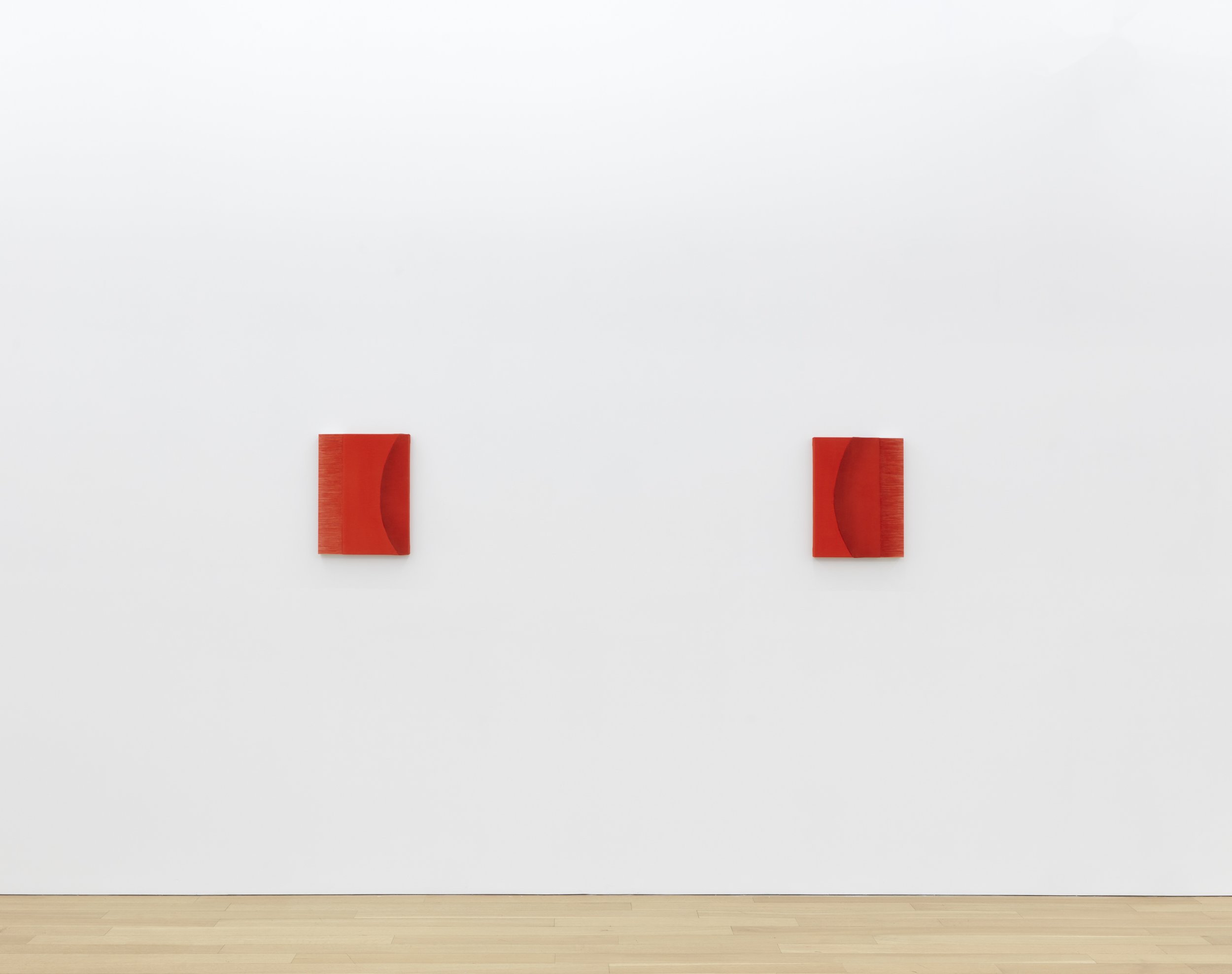

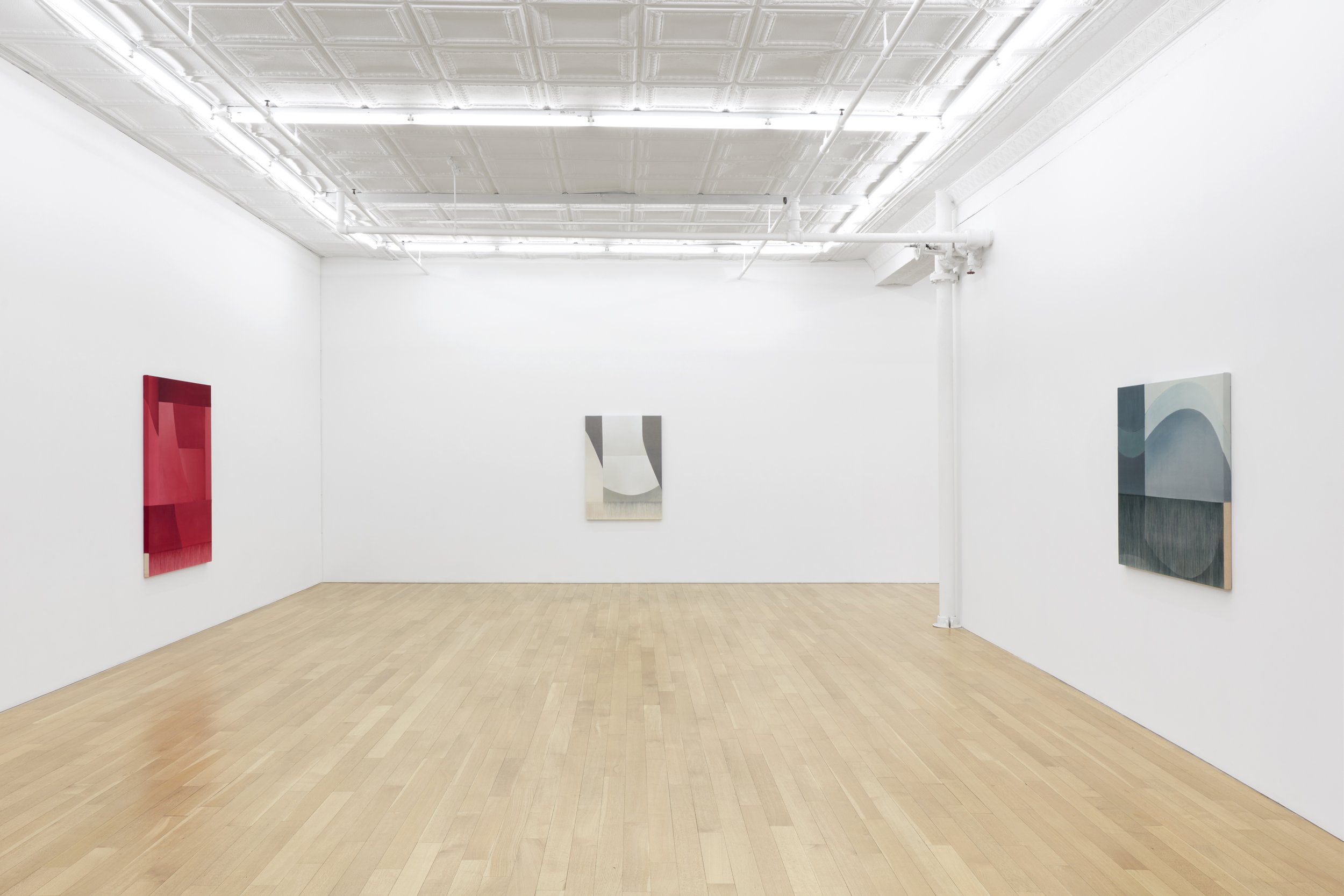




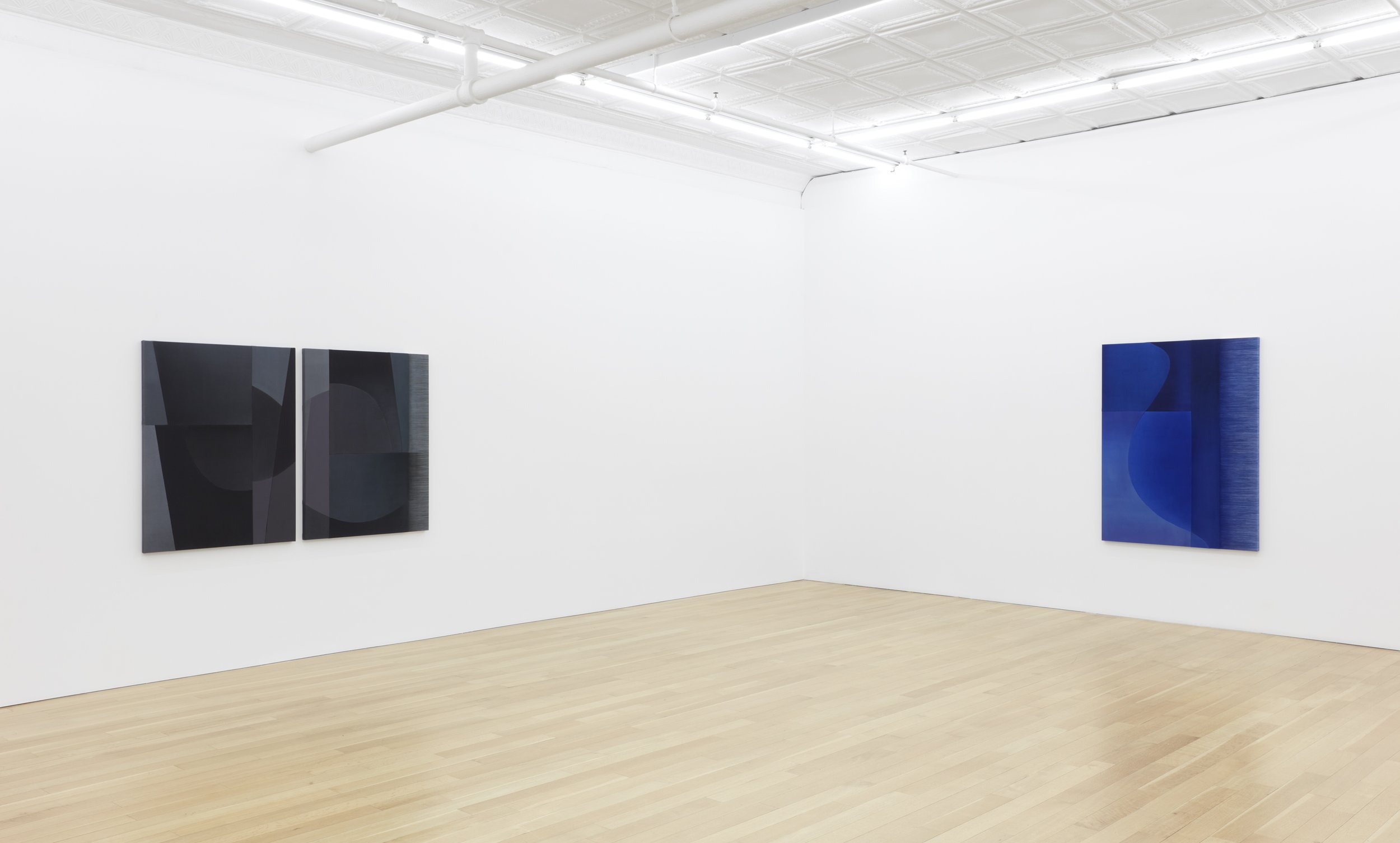
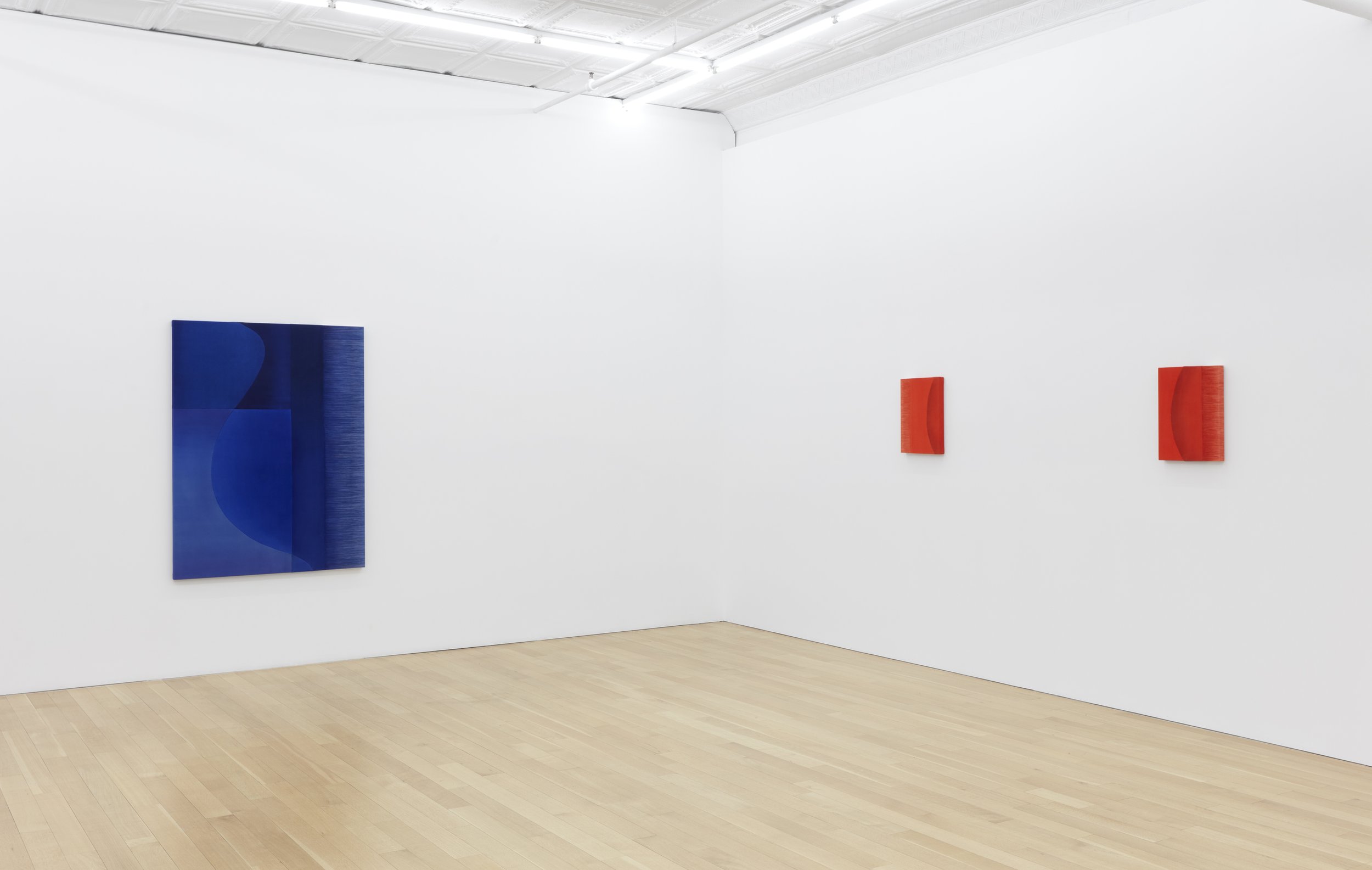
Installation view, Rebecca Ward: vector specter, April 5, 2025 – May 31, 2025, Peter Blum Gallery, New York. Photo: Courtesy of the artist and Peter Blum Gallery
The woven canvas can be understood as a physical representation of a mathematical grid, where the warp and weft create a regular pattern of squares and rectangles, a visual reflection of geometric order. As a queer identified person, Ward combines curving lines and axis to demonstrate that masculinity and femininity are not fixed, binary concepts, but are dynamic, evolving, and context dependent. In this way, the grid becomes a representation of the slippage between forms that can be viewed as bodies, vessels, graphs, or purely geometric outlines. Through these methods, Ward communicates the presence of what shapes cannot be fully grasped, offering a meditation on the nature of being, absence, and spaces in between.
Installation view, Rebecca Ward: vector specter, April 5, 2025 – May 31, 2025, Peter Blum Gallery, New York. Photo: Courtesy of the artist and Peter Blum Gallery
Rebecca Ward (b. 1984, Waco, TX) lives and works in Brooklyn, NY. She earned a BA at the University of Texas, Austin, TX (2006) and an MFA at the School of the Visual Arts, New York, NY (2012). Institutional exhibitions include Rebecca Ward: distance to venus, SITE Santa Fe, Santa Fe, NM (2022); Fresh Faces from the Rachofsky Collection, Site 131, Dallas, TX (2021); Over & Over, Columbia College, Chicago, IL (2018); Rebecca Ward, The FLAG Art Foundation, New York, NY (2017); Eastwing Biennial: Artificial Realities, The Courtauld Institute of Art, London, UK (2016); Making & Unmaking, Camden Art Centre, London, UK (2016); The Tim Sayer Bequest, The Hepworth Wakefield, West Yorkshire, United Kingdom (2016); Linear Abstraction, Savannah College of Art and Design, Savannah, GA (2015); Rebecca Ward: indulgences, Exchiesetta, Polignano a Mare, Italy (2015). Residencies include Shandaken: Storm King Art Center, New Windsor, NY (2016) and Atelier Alighiero Boetti, Todi, Italy (2013).
For more information about this exhibtion and others please visit the Peter Blum Gallery’s website here. The magazine did an interview with Ward which can be found here.
MAESTRO: LOADING
LOADING Mona Lisa, Courtesy of artist and HOMME gallery
Washington, D.C. – Artist and practicing architect, MAESTRO’s first solo exhibition, "LOADING," at HOMME Gallery, opened on April 3 and will be on view until the 24th of April 2025. Known for pixelated pen drawings of cultural icons in a perpetual state of "loading," his work blends fine art with digital interactivity, as well as the tension between the past and present.
Originally from Valencia, Spain, and now based in Santa Barbara, MAESTRO’s work is influenced by his architectural precision and multimedia expertise. Through augmented reality QR code integration, viewers can engage with his pieces in a new digital dimension.
LOADING Marilyn, Courtesy of artist and HOMME gallery
“I create art that merges elegance and technology, sparking cultural conversations through beauty in an era of digital.”
MAESTRO Installation Views, HOMME Gallery, Washington DC ©MASESTRO; Courtesy of the artist and HOMME Gallery, Photo: HOMME Gallery
Using a digitally distorted yet hyperreal approach, MAESTRO’s drawings challenge viewers to engage with pixelated cultural icons through a shifting perspective.
HOMME Gallery, a renowned space for emerging multimedia artists, is excited to showcase MAESTRO’s vision. "MAESTRO’s work challenges the way we perceive both art and technology, offering a unique and thought-provoking experience," says Amir Browder. The exhibition also features his debut resin sculpture, Glitching - Venus, a pixelated abstraction of the Venus de Milo.
Inspired by his experience recently immigrating to the United States and navigating digital connectivity, "LOADING" reflects the paradox of endless access yet fleeting connection. Augmented reality elements in his work transport viewers into shifting digital landscapes, challenging perceptions of history and modernity.
Exhibition details:
"LOADING" by MAESTRO
April 3 - 24, 2025
HOMME Gallery, D.C.
2000 L St NW
By appointment only
Courtesy of artist and HOMME gallery
About MAESTRO:
MAESTRO is a hyper realistic, black-and-white artist based in Santa Barbara, California. Originally from Valencia, Spain, MAESTRO received technical training from the Stuart Weitzman School of Design before beginning a dynamic career as a visual artist and architect. MAESTRO has worked for firms such as the Bjarke Ingels Group (B.I.G.) and had artistic collaborations with many LA-based creatives, including DOPEHAUS STUDIO and NeueHouse Hollywood. His work has been shown, among other venues, at the Charles Addams Fine Arts Gallery, the :iidrr Gallery in Manhattan, Graffiti Library in Los Angeles, The Victorian in Santa Monica, Just Another Gallery in Philadelphia, and the Sullivan Goss gallery in Santa Barbara. His first solo exhibition, “LOADING” will open at the HOMME Gallery in Washington D.C. on April 3rd, 2025.
About HOMME Gallery:
HOMME DC was founded by curator and creative director, Amir Browder, and has been in business since 2014. It is a\ forward-thinking art gallery and exhibition space located in Washington D.C. HOMME provides a dynamic platform for various art experiences, including visual arts, performing arts, and experiences that transcend the boundaries of medium. HOMME DC seeks to elevate the arts by bolstering diverse voices and talents that represent the leading-edge of today's contemporary creative scene, both in Washington D.C. and beyond.
For more information about this exhibition and others, please visit HOMME Gallery’s website here.
Kazuo Kadonaga
Kazuo Kadonaga Bamboo No. 1 A (26 pcs), 1976 Bamboo 92 1/4 x 2 1/4 x 2 1/4 inches 234.3 x 5.7 x 5.7 centimeters 92 1/2 x 92 x 13 1/2 inches overall 235 x 233.7 x 34.3 centimeters Photo: Evan Walsh
Los Angeles—BLUM is pleased to present a survey exhibition of Kazuo Kadonaga, an artist who worked extensively in Los Angeles during the early 1980s and has exhibited throughout the US, Europe, and Mexico. Kadonaga’s practice draws from a holistic approach to natural forms, where he unveils the essence of material properties. Deviating from sculpture as a repository of projected ideas, the artist exposes the phenomenological transformation of materials. The exhibition includes seventeen works from 1976 to 2019, spanning bamboo, oak, cedar, cypress, handmade paper, and glass.
Kazuo Kadonaga was born in 1946 and is based in Ishikawa Prefecture, where generations of the Kadonaga family have owned a cedar forest and lumber mill. A self-taught artist, Kadonaga first moved to Tokyo in 1966 to learn architectural drawing and later study architectural techniques such as welding at small factories. Immersing himself in the contemporary art scene, he frequented many galleries and attended major exhibitions of the time, such as the 10th Tokyo Biennale: Between Man and Matter and the Osaka Expo (both 1970). He studied under avant-garde painter Hironao Toyoshima, who would bridge him to Tsubaki Kindai Gallery, where Kadonaga held his first solo exhibition in 1971. Kadonaga’s earliest works combined wood with stainless steel (Wood No. 1) as well as with transparent acrylic (Wood No. 2) in which he would cut curves into squared lumber and produce a duplicate shape in a different material and place the forms side by side. These were shown at Tsubaki Kindai Gallery (1971) and Muramatsu Gallery (1973–77, and 1981) respectively, where Mono-ha artists, Kishio Suga, Nobuo Sekine, and Lee Ufan were actively exhibiting. During this time, his work was also included in several museum annuals, such as the 10th Contemporary Art Exhibition of Japan (1971) and the 7th, 8th, and 10th Japan Art Festival (1972, 1973, and 1975), which toured to Mexico, Slovenia, Germany, New Zealand, and Australia.
Kazuo Kadonaga Wood No.7 A, 1976 Oak 35 1/4 x 3 x 2 3/4 inches each 89.5 x 7.6 x 7 centimeters 35 1/4 x 62 x 4 1/4 inches overall 89.5 x 157.5 x 10.8 centimeters Photo: Evan Walsh
In 1974, Kadonaga was invited to participate in a hundred-day symposium on stone in Sweden. During his visit he had the opportunity to see Italian sculptor Giuseppe Penone’s carved and stripped tree trunks at the Museum of Modern Art, Stockholm, and was greatly inspired by his ability to use the medium of the tree itself. This experience provided an impetus for him to begin focusing on the singular materiality of wood, studying its unique organic properties. He often sliced or split cross sections of the logs, drying sections separately, and reassembling them into a solid form. The artist’s process would begin in his family’s cedar forest, cutting the base of a tree just above the root flare, while the wood is still wet. He then sent the logs to a sawmill to have them professionally cut into paper-thin layers of wood with a veneer mill—usually used for building houses and furniture—gluing each skin back to its original form, letting the thin wood buckle and flare out while drying. At the Kanagawa Prefectural Gallery exhibition From Method to Method in 1975, he unraveled a cedar log, leaving its paper-thin pieces of bark directly on the floor as if shedding skin like a snake. The two large cedar logs currently on view at BLUM were first exhibited at the Los Angeles Municipal Art Gallery in 1985 and display live cuts against the grain of the wood. The rectangular holes along the surface are the result of natural splitting. The jagged lines across the tree rings are prominent in Wood No. 11 DB (1999), a large, gnarled cedar trunk. Kadonaga created these splits by first cutting the face of the trunk using a chainsaw just a few inches and then striking the wood with a mallet to allow for the jagged splits to naturally occur.
Kadonaga was hired by Yoshishige Saito (1904–2001), a pioneer of modern Japanese constructivism, to assist with his solo exhibition at the National Museum of Modern Art, Tokyo, in 1978. Saito, who taught at Tama Art University from 1964 to 1973, was a key mentor to Nobuo Sekine and Kishio Suga. Sharing Saito’s conviction that illusion and individual expression were obsolete, Mono-ha artists often combined natural and industrial materials to articulate the relational structures through which these forms revealed themselves. While Kadonaga’s early works are in direct dialogue with Mono-ha as well as Minimalist repetition in both process and display to deviate from the objecthood of sculpture, the artist’s interests lay in exposing the intrinsic qualities and natural transformation of materials, and activating the threshold between formation and deformation that was specific to the materiality of wood. This was in stark contrast to Mono-ha’s focus on the in-between structure among subject, materials, and site.
Kazuo Kadonaga Wood No. 11 DB, 1999 Cedar 35 1/2 x 42 1/2 x 43 1/2 inches 90.2 x 108 x 110.5 centimeters Photo: Evan Walsh
In 1976, Kadonaga began investigating the metamorphic process in which oak and bamboo were separately transformed by charring half of each piece into a pyramid of ashes in a specialized furnace at intense heat (approximately 1,500 degrees Fahrenheit). Burning oak into charcoal is a ritual often used in Japanese tea ceremonies in preparation to heat tea, in which the oak burns evenly and its cross section dries in a starburst pattern that radiates out from the center (sakura zumi, or cherry blossom charcoal). First exhibited at Muramatsu Gallery in 1976, each oak piece in Wood No. 1A shows the unburned to charcoal gradation, displayed in a row of over a dozen pieces. Praised by artist Lee Ufan, Wood No. 1A was shown in tandem with Bamboo No. 7A, charred bamboo poles propped against the wall. In the current exhibition at BLUM, the two 1976 works are brought together, and installed under skylights. The bamboo work, in particular, creates an arresting pattern of shadows from the rays of natural sunlight.
In Conversation between Bamboo and Wood, Kadonaga activated sound by installing bamboo and wooden logs around a visitor who sat in the middle of the installation, experiencing the materials cracking in real time in response to shifts in temperature.
In 1988, he began working with washi (handmade Japanese paper), layering thousands of sheets and using a veneer press to condense and dry the papers into a solid block in a high frequency wood dryer machine. Each piece of paper is then separated one-by-one at one end of each work. These condensed layers of pulp are hung along the wall in long columns or triangular forms, where the fibrous, feathery edges of the paper are left exposed at the bottom. Rather than subjecting the materials to convey a concept, Kadonaga works with the natural properties of the paper to allow their form to come alive.





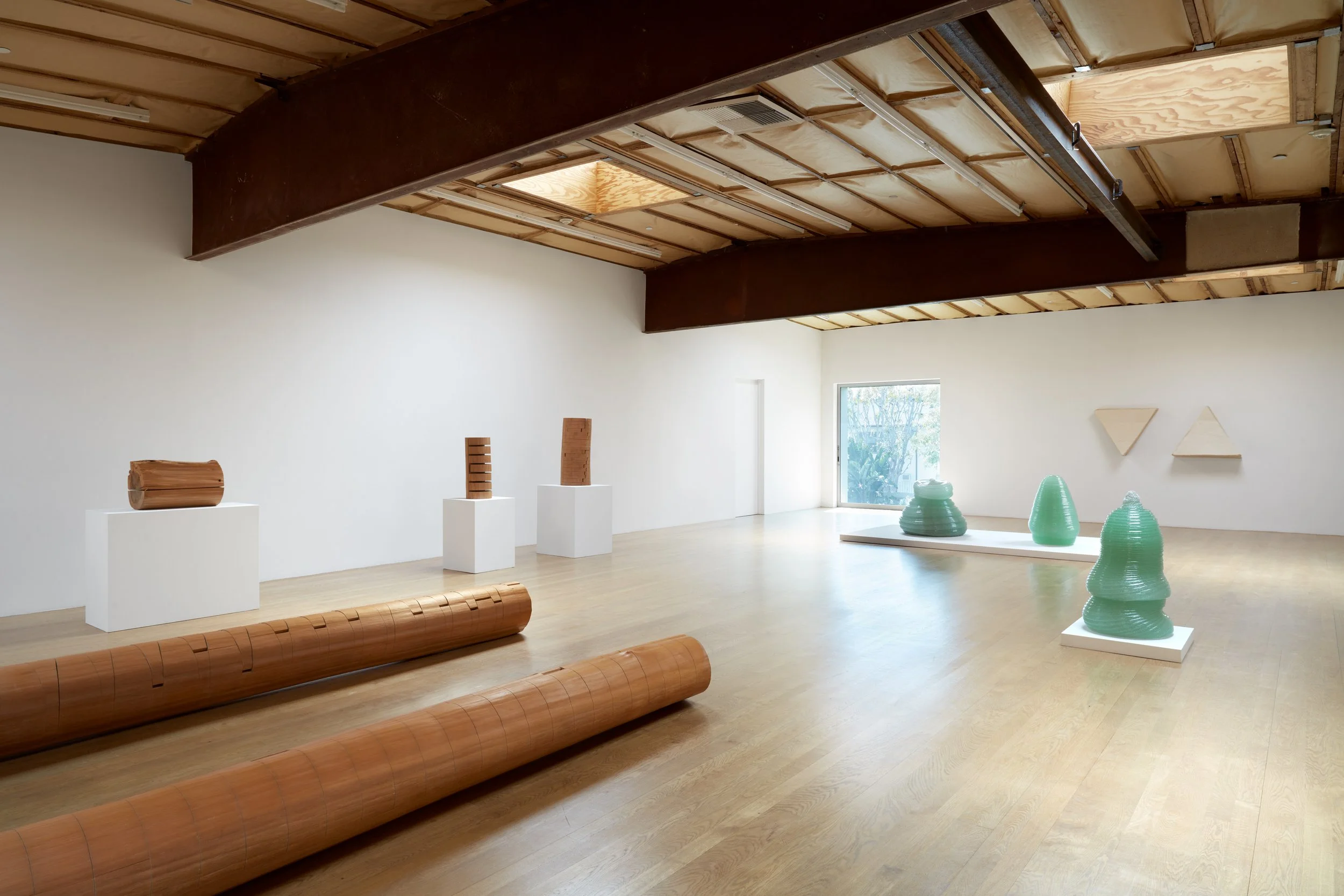






Kazuo Kadonaga Installation views, 2025 BLUM Los Angeles © Kazuo Kadonaga; Courtesy of the artist and BLUM Los Angeles, Tokyo, New York Photo: Evan Walsh
In 1999, Kadonaga began his long-term process of working with recycled glass from fluorescent light fixtures resulting in translucent green glass from iron oxide. For years, Kadonaga went through many trials and errors experimenting with molten glass using a custom-made furnace. The recycled glass is melted at 1,250 to 1,450 degrees Celsius (2,282 degrees Fahrenheit) in a melting furnace, and this melted glass slowly drips a single stream of hot liquid glass into the slow cooling furnace, letting the form take its own shape by steadily decreasing the temperature between three to six months depending on their size. They result in solid, squat mounds that swell like a Buddha’s belly and taper towards the top. The glass sculptures exhibited at BLUM range in weight from 1,000 to 1,200 pounds. Through these sculptures, one can observe how the transparent fragility of glass is apparent through the surface formation of the coils, which belie their weight and heft.
Each material is approached with the fresh eyes of a studied observer. Eschewing his artistic hand, Kadonaga unravels each work from the inside out as if the materials take on their own life and form. As one critic noted about Kadonaga’s process, “In a serial manner, each element became the topic of his scrutiny. He analyzed their component parts, tested their attributes, and examined their intrinsic characteristics, noting their change in environmental characteristics like fluctuations in humidity or reaction to forceful impact.”
Kazuo Kadonaga Wood No.8 L, 1982 Cedar 24 5/8 x 10 x 9 3/4 inches 62.5 x 25.4 x 24.8 centimeters Photo: Evan Walsh
Kazuo Kadonaga (b.1946, Ishikawa, Japan) is a contemporary sculptor celebrated for his material-driven practice. Coming from a family of foresters, he developed a deep appreciation for the natural properties of wood. While he initially explored painting and architecture, Kadonaga shifted his focus in the early 1970s, rejecting overt artistic expression in favor of processes that allow materials to shape their own form. Since then, he has worked with wood, bamboo, paper, and glass, using methods that emphasize the natural behavior of each material. From coiling molten glass into sculptural forms to reassembling cedar logs, his works reveal the subtle interplay between natural structures and transformational processes. While his practice resonates with the philosophies of Japan’s Mono-ha artists and Western process art, Kadonaga’s approach remains distinctly his own—one of observation, patience, and reverence for materiality.
Kadonaga continues to live and work in Ishikawa, Japan. His artwork has been exhibited including significant solo presentations at the Mingei International Museum, San Diego, CA (2005); Salt Lake Art Center, Salt Lake City, UT (2001); The Art Museum of South Texas, Corpus Christi, TX (1988); and Los Angeles Municipal Art Gallery, Los Angeles, CA (1985). In 1983, he was an artist-in-residence at the Stedelijk Museum in Amsterdam, the Netherlands. His work is held in numerous public collections worldwide, such as the 21st Century Museum of Contemporary Art, Toyama City, Japan; Albuquerque Museum, Albuquerque, NM; Art Museum of South Texas, Corpus Christi, TX; The Honolulu Museum of Art, Honolulu, HI; Museo de Arte Moderno, Mexico City, Mexico; The Museum of Glass, Tacoma, WA; the Museum of Modern Art, Toyama, Japan; Rijksmuseum Kröller-Müller, Otterlo, the Netherlands; and the University of California Santa Barbara Art Museum, CA.
The exhibition opened on Saturday, April 5, with an opening reception held from 5 to 7 pm. The exhibition will be on view at BLUM Los Angeles location until May 17, 2025
For more information about this exhibition and others please visit Blum’s website here. The gallery can also be found on Instagram.
The Anansean World of Robert Colescott





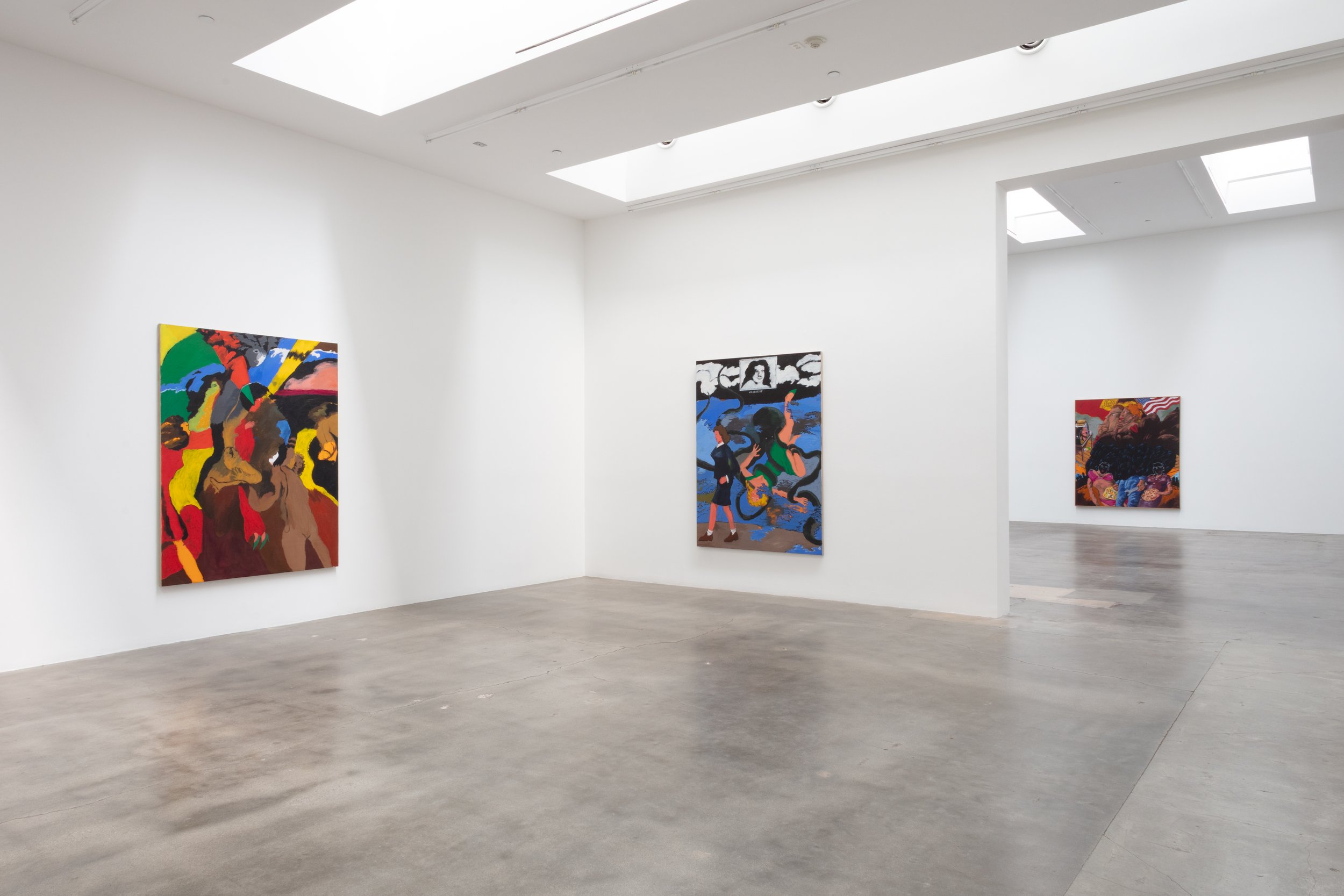







The Anansean World of Robert Colescott curated by Umar Rashid Installation views, 2025 BLUM Los Angeles © The Robert H. Colescott Separate Property Trust / Artists Rights Society (ARS), New York; Courtesy of The Trust and BLUM Los Angeles, Tokyo, New York Photo: Josh Schaedel
Los Angeles, CA—BLUM is pleased to present an exhibition of paintings and drawings by the late artist Robert Colescott, curated by Los Angeles–based artist Umar Rashid. Rashid frames this presentation of work—ranging five decades—as an entry point into The Anansean World of Robert Colescott, a parallel universe that violates principles of social and natural order, blithely disrupting what once was and then reestablishing it on a new basis.
Robert Colescott Untitled, 1949 Gouache and graphite on paper 10 x 14 1/2 inches (25.4 x 36.8 centimeters) 17 1/8 x 21 5/8 x 1 1/2 inches (43.5 x 54.9 x 3.8 centimeters) Photo: EvanWalsh
“In the time of the ancient deities, the trickster was the only one who could successfully navigate the complex and morally fraught universe of power-hungry, vengeful, wickedly jealous, and ambivalent gods, as well as their equally maligned human counterparts. One can only imagine the path of Thoth, Hermes, Coyote, Dionysus, Loki, Prometheus, and the original spider-man, Ananse. Although there are far more “tricksters” woven into our collective human consciousness throughout time, I have kept the list relatively short so that I may get to the point. Despite being tasked with delivering various decrees on this and that, the messengers of the gods of old almost always had a penchant for mischief, high drama, and outright rebellion. And despite these “faults,” they managed to survive the wrath of their omnipotent masters and formed a complex relationship with their painfully mortal audience. Their legacy as “middle management” and mere couriers left an indelible mark on their human charges. With the death of the old pantheon, humanity’s hubristic and equally chaotic reign, produced its own gods, monsters, and tricksters, bringing to mind the old saying, “As above, so below.” And thus, we enter the world of Robert Colescott, grand trickster of the ages. The appellation is incredibly apt in terms of his artistic practice, yet he was not born thus but forged through the crucible of being an African American fine artist in a time of limited opportunity for those like him and the ideas he sought to bring forth in a postindustrial world, burdened by draconian racial awareness, social lobotomization, and post-imperial, imperial war machinations. This is mid-twentieth-century America, replete with all the trappings of Mount Olympus at its zenith.”
Robert Colescott Untitled, 1970 Acrylic on canvas 79 x 98 1/8 x 1 5/8 inches (200.7 x 249.2 x 4.1 centimeters) Photo: Evan Walsh
Robert Colescott (b. 1925, Oakland, CA; d. 2009, Tucson, AZ) was a proud instigator who, over a nearly six-decade painting career, fearlessly tackled subjects of social and racial inequality, class structure, sex, and the human condition through his uniquely rhythmic and often manic style of figuration. His distinctive works, while not easily placed within any one specific school of painting, share elements of Abstract Expressionism, Pop Art, "Bad" Painting, Renaissance Painting, Neo- Expressionism, and Surrealism. A retrospective curated by Lowery Stokes Sims and Matthew Weseley, opened at the Contemporary Arts Center, Cincinnati, OH, in 2019, and later traveled to the Portland Art Museum, Portland, OR; Sarasota Art Museum, Sarasota, FL; Chicago Cultural Center, Chicago, IL; and New Museum, New York, NY. The exhibition was accompanied by a comprehensive monograph on the artist’s life and work, published by Rizzoli Electa.
Robert Colescott A Can of Worms, 1978 Watercolor and graphite on Arches paper 30 1/4 x 22 3/4 x 1 inches (76.8 x 57.8 x 2.5 centimeters) 37 1/2 x 29 3/4 x 1 1/2 inches framed (95.3 x 75.6 x 3.8 centimeters) Photo: EvanWalsh
Colescott’s work is represented in public collections internationally, in such notable institutions as the Akron Art Museum, Akron, OH; Art Bridges Foundation, Bentonville, AR; Baltimore Museum of Art, Baltimore, MD; Brooklyn Museum of Art, Brooklyn, NY; BY ART MATTERS, Hangzhou, China; California African American Museum, Los Angeles, CA; National Gallery of Art, Washington, D.C.; Crocker Museum of Art, Sacramento, CA; Dallas Museum of Art, Dallas, TX; Delaware Museum of Art, Wilmington, DE; Denver Museum of Art, Denver, CO; Detroit Institute of Arts, Detroit, MI; de Young Fine Arts Museums of San Francisco, CA; Hammer Museum, Los Angeles, CA; High Museum of Art, Atlanta, GA; Hirshhorn Museum & Sculpture Garden, Washington, D.C.; Los Angeles County Museum of Art, Los Angeles, CA; Lucas Museum of Narrative Art, Los Angeles, CA; Manetti Shrem Museum of Art, UC Davis, CA; Metropolitan Museum of Art, New York, NY; Morgan Library and Museum, New York, NY; Museum of Contemporary Art, Los Angeles, CA; Museum of Contemporary Art, Chicago, IL; Museum of Fine Arts, Boston, MA; Museum of Modern Art, New York, NY; Oakland Museum of California, Oakland, CA; Portland Museum of Art, Portland, OR; Pinault Collection, Paris, France; Rubell Family Collection, Miami, FL; San Francisco Museum of Modern Art, San Francisco, CA; Seattle Art Museum, Seattle, WA; Studio Museum in Harlem, New York, NY; Tucson Museum of Art, Tucson, AZ; Wadsworth Atheneum Museum of Art, Hartford, CT; Walker Art Center, Minneapolis, MN; Whitney Museum of American Art, New York, NY; among many more.
Umar Rashid (b. 1976, Chicago, IL) creates paintings, drawings, and sculptures that chronicle the grand historical fiction of the Frenglish Empire (1648–1880) a conceptual world he has been developing for over seventeen years. Each work represents a frozen moment from this parallel history, often recalling fraught real-world narratives—both canonized and marginalized—with familiar signifiers and iconographies. Rashid’s work channels the visual lexicons of hip hop, ancient and modern pop culture, gang and prison life, and revolutionary movements throughout time. Rashid’s work is represented in the public collections of the Brooklyn Museum, Brooklyn, NY; Hudson River Museum, Yonkers, NY; Jorge Pérez Collection, Miami, FL; Mount Holyoke Art Museum, South Hadley, MA; Nevada Museum of Art, Reno, NV; Ruth and Elmer Wellin Museum of Art at Hamilton College, Clinton, NY; Santa Barbara Museum of Art, Santa Barbara, CA; Wadsworth Atheneum Museum of Art, Hartford, CT; and the Zeitz Museum of Contemporary Art Africa, Cape Town, South Africa, among others.
About BLUM
BLUM represents more than sixty artists and estates from twenty countries worldwide, nurturing a diverse roster of artists at all stages of their practices with a range of global perspectives. Originally opened as Blum & Poe in Santa Monica in 1994, the gallery has been a pioneer in its early commitment to Los Angeles as an international arts capital.
The gallery has been acclaimed for its groundbreaking work in championing international artists of postwar and contemporary movements, such as CoBrA, Dansaekhwa, Mono-ha, and Superflat, and for organizing museum-caliber solo presentations and historical survey exhibitions across its spaces in Los Angeles, Tokyo, and New York. Often partnering with celebrated curators and scholars such as Cecilia Alemani, Alison M. Gingeras, Sofia Gotti, Joan Kee, and Mika Yoshitake, the gallery has produced large- scale exhibitions focusing on the Japanese Mono-ha school (2012); the Korean Dansaekhwa monochrome painters (2014); the European postwar movement CoBrA (2015); Japanese art of the 1980s and 1990s (2019); a rereading of Brazilian Modernism (2019); a revisionist take on the 1959 MoMA exhibition, New Images of Man (2020); and a survey of portraiture through a democratic and humanist lens (2023); among others.
BLUM’s wide-reaching program includes exhibitions, lectures, performance series, screenings, video series, and an annual art book fair at its base in Los Angeles. BLUM Books, the gallery’s publishing division, democratically circulates its program through original scholarship and accessible media ranging from academic monographs, audio series, magazines, to artists’ books. Across the three global locations, BLUM prioritizes environmental and community stewardship in all operations. In 2015, it was certified as an Arts:Earth Partnership (AEP) green art gallery in Los Angeles and consequently became one of the first green certified galleries in the United States. The gallery is also a member of the Gallery Climate Coalition, which works to facilitate a more sustainable commercial art world and reduce the industry’s collective carbon footprint. BLUM is committed to fostering inclusive and equitable communities both in its physical and online spaces and believes that everybody should have equal access to creating and engaging with contemporary art.
The exhibition opened Saturday, April 5, with a Public conversation with Sandra Jackson-Dumont and Umar Rashid, moderated by JJ Strawn at 4 pm, during which an opening reception was held from 5 to 7 pm. The exhibition will be on view at BLUM Los Angeles location until May 17, 2025
For more information about this exhibition and others please visit Blum’s website here. The gallery can also be found on Instagram.
JAN VAN IMSCHOOT: THE HAPHAZARDNESS OF OPINIONS
JAN VAN IMSCHOOT Les terres vertes (moulin à poivre, version flamand), C'est beau, c'est belge VI, 1999 Technique mixte sur papier | Mixed media on paper 35 × 25 cm — 13 3/4 × 9 3/4 in Courtoisie de l'artiste et Templon, Paris – Bruxelles - New York | Courtesy of the artist and Templon, Paris – Brussels - New York Photo © Isabelle Arthuis
For the first time, this spring, the Belgian painter Jan Van Imschoot unveils a previously unseen facet of his work: 45 drawings paying tribute to major figures of French literature, from Marcel Proust to Albert Camus, along with a series of interior scenes in dialogue with a selection of his works from C’est beau c’est belge, created 25 years ago.
Toutes les images / All images : © Courtesy of the artist and TEMPLON, Paris —Brussels — New York
Now recognized as one of the leading names in contemporary Belgian painting, Jan Van Imschoot, the self-proclaimed master of “anarcho-baroque,” brings to his grand oil compositions a bold and erudite reinterpretation of the legacy of the great masters. His works blend formal and philosophical reflections on art history, drawing connections from Tintoretto to Luc Tuymans, with echoes of Goya and Matisse.
In this unprecedented new body of works on paper, Jan Van Imschoot anchors his artistic explorations in two key literary figures: Albert Camus, whom he admires for his extraordinary life and his commitment, and Marcel Proust, whose “philosophy of boredom” fascinates him. Their portraits and the depiction of their destinies are set alongside a series of interior drawings from the 1970s. Inspired by photographs, these settings offer narratives on the margins of history, elegant in some cases, vaguely Buñuelian in others. The assembled perspectives testify to a delicate balancing act between order and chaos. A dialogue is established between these recent series and C’est beau c’est belge, a body of work created in 1999 and never exhibited before.
Toutes les images / All images : © Courtesy of the artist and TEMPLON, Paris —Brussels — New York
For Jan Van Imschoot, drawing is a medium that challenges entrenched habits: “What I love about this medium is that, unlike oil painting, drawing offers only one chance,” he explains. “Once a line is drawn, it cannot be erased or reworked. I have always embraced its irreversibility. It is a play of color that I attempt to control, a dance with the pencil that I have been exploring for decades »
JAN VAN IMSCHOOT Le hasard dans les opinions 4, 2023 Technique mixte sur papier | Mixed media on paper 65 × 50 cm — 25 1/2 × 19 3/4 in Courtoisie de l'artiste et Templon, Paris – Bruxelles - New York | Courtesy of the artist and Templon, Paris – Brussels - New York Photo © Isabelle Arthuis
Born in 1963 in Ghent, Jan Van Imschoot has been living and working in France since 2013. The Ghent SMAK held a major solo exhibition of his work in 2002. More recently, his paintings have been shown at the Dusseldorf Kunstpalast (2005), Museum Dhondt-Dhaenens in Deurle (2008), National Art Museum of China in Beijing (2010) and Fondation Volume! in Rome (2012). In 2018, he took part in the group exhibition Sanguine/Bloedrood curated by Luc Tuymans for the M HKA in Antwerp and Fondazione Prada in Milan, and in Feast of Fools, Bruegel Rediscovered at Château de Gaasbeek in Belgium in 2019. The Roger Raveel Museum hosted the 7th Biennial of Painting on the theme of inner spaces in 2020, where Van Imschoot showed four large paintings from his Interiors series. In 2024, the Ghent SMAK held a major retrospective of his work, The End is Never Near. Jan Van Imschoot has been represented by Galerie Templon since 2015.
JAN VAN IMSCHOOT’s CHANCE IN OPINIONS opened on 6 MARCH and will be on view until 19 APRIL 2025 at the TEMPLON BRUSSELS location For more information about the exhibit, please visit Templon’s site.
Van Gogh: The Roulin Family Portraits
an Gogh: The Roulin Family Portraits exhibition at the Museum of Fine Arts, Boston. March 30, 2025 to September 7, 2025 * Ann and Graham Gund Gallery* Photograph © Museum of Fine Arts, Boston
BOSTON 2025, In 1888 and 1889, during his stay in Arles, in the South of France, Vincent van Gogh (1853–1890) forged a cherished friendship with a neighboring family: postman Joseph Roulin; his wife, Augustine; and their three children: Armand, Camille, and Marcelle. During this pivotal time in his life, Van Gogh created 26 intimate portrayals of the working-class family. Organized in partnership with the Van Gogh Museum in Amsterdam, Van Gogh: The Roulin Family Portraits is the first exhibition devoted to the artist’s deep connection to the family and the making of their portraits. Featuring 23 works by Van Gogh—including 14 of the Roulin portraits—as well as earlier Dutch art and Japanese woodblock prints that inspired him, the exhibition includes iconic works from the MFA’s collection alongside more than 20 key loans from prominent international collections. The exhibition presents 10 letters from Joseph Roulin to Van Gogh and the artist’s siblings together for the first time, offering an intimate and tender look at their friendship. This selection of works provides new insights into Van Gogh’s world and yearning for meaningful connection as he moved to a new city and found himself at a turning point in his life and work.
Self Portrait, 1889Vincent van Gogh (Dutch (worked in France), 1853–1890)Oil on canvas* National Gallery of Art, Washington, Collection of Mr. and Mrs. John Hay Whitney, 1998.74.5* Courtesy Museum of Fine Arts, Boston
“The exhibition gives visitors the opportunity to see the full flowering of Van Gogh’s artistic aspirations and the intensity of his focus—a clarity that may have emerged, in part, because of his very deep bonds with the postman and his family,” said Matthew Teitelbaum, Ann and Graham Gund Director. “It tells a new and compelling story of Van Gogh’s emotional and artistic search to make connection to a family who helped guide his last years.”
Postman Joseph Roulin, 1888 Vincent van Gogh (Dutch (worked in France), 1853–1890) Oil on canvas* Gift of Robert Treat Paine, 2nd* Photograph © Museum of Fine Arts, Boston
The exhibition is co-curated by Katie Hanson, William and Ann Elfers Curator of Paintings, Art of Europe, at the MFA and Nienke Bakker, Senior Curator at the Van Gogh Museum. “It has been an honor and a pleasure to work with Nienke Bakker on this exhibition dedicated to friendship, family, and connection,” said Hanson. “It features not only Van Gogh’s depictions of the Roulin family, but also works attending to his thinking about those portraits. The MFA’s Roulin portraits are beloved icons of the collection—so part of our aim in this exhibition is to slow down, look more closely, and feel deeply with these magnificent works of art by foregrounding the human story behind them.”
an Gogh: The Roulin Family Portraits exhibition at the Museum of Fine Arts, Boston. March 30, 2025 to September 7, 2025 * Ann and Graham Gund Gallery* Photograph © Museum of Fine Arts, Boston
Van Gogh: The Roulin Family Portraits is on view at the MFA from March 30 through September 7, 2025 in the Ann and Graham Gund Gallery. Timed-entry tickets, which include general admission, are required for all visitors and can be reserved on mfa.org or purchased at the Museum. Member Preview takes place March 26–29. Following the MFA’s presentation, the exhibition will travel to the Van Gogh Museum, where it will be on view from October 3, 2025, through January 11, 2026.
Exhibition Overview
The exhibition is organized in thematic sections, tracing Van Gogh’s friendship with the Roulins, his admiration for his predecessors, his attempt to create a community of fellow artists, and his emotional ties to his supportive family and friends.
an Gogh: The Roulin Family Portraits exhibition at the Museum of Fine Arts, Boston. March 30, 2025 to September 7, 2025 * Ann and Graham Gund Gallery* Photograph © Museum of Fine Arts, Boston
• The first section, “Sense of Place: The Yellow House in Arles,” provides an immersive look at Arles, where the artist lived from February 1888 to April 1889, and the dwelling he rented in May 1888 to use first as a studio and then as a home. An 1887 self-portrait, completed in Paris as Van Gogh was making plans to move south, radiates the ambition and enthusiasm of the painter as he envisioned a new life in Arles. A map of the town orients visitors along with The Yellow House (The Street) (1888), the artist’s colorful depiction of his home and studio where the Roulin family posed for their portraits. A schematic construction of Van Gogh’s studio within this first gallery provides a sense of scale for visitors of the cozy space in which the artist worked.
an Gogh: The Roulin Family Portraits exhibition at the Museum of Fine Arts, Boston. March 30, 2025 to September 7, 2025 * Ann and Graham Gund Gallery* Photograph © Museum of Fine Arts, Boston
• Although Van Gogh thought it would be easier to find models and make contacts in Arles than in Paris, even after four months whole days went by without him exchanging a word with anyone. In summer 1888, Van Gogh and Joseph Roulin shared drinks at a café and a deep friendship began—and with it, the opportunity for Van Gogh to practice painting people, something he thought brought out the best in him. “The Postman and Portrait Practice,” a section dedicated to Van Gogh’s best friend in Arles, includes the artist’s earliest depiction of him, the MFA’s Postman Joseph Roulin (1888), as well as two drawings of Roulin. The section is supplemented with portraits by 17th-century Dutch artists from which he drew inspiration, such as Merry Drinker (about 1628–30) by Frans Hals (1582/83–1666) and Portrait of a Family in an Interior (1654) by Adriaen van Ostade (1610–1684), as well as lithographs by Honoré Daumier (French, 1808–1879).
Letter from Joseph Roulin to Vincent van Gogh, October 24, 1889 Ink on paper * Van Gogh Museum, Amsterdam (Vincent van Gogh Foundation) * Courtesy Museum of Fine Arts, Boston
• After completing his first painting of Joseph Roulin in summer 1888, Van Gogh would go on to create a suite of 26 portraits of the five Roulin family members by April 1889. In addition to painting Joseph and Augustine Roulin, he painted their children: three solo portraits each of Armand, Camille, and Marcelle. In the third section, “The Roulin Family,” the entire family is portrayed across four canvases encircling the visitor. A large series of works devoted to the members of a single working-class family is unique not only in Van Gogh’s oeuvre, but also highly unusual in the history of art, suggesting the satisfaction he felt in creating these portraits was both personal and professional.
Van Gogh: The Roulin Family Portraits exhibition at the Museum of Fine Arts, Boston. March 30, 2025 to September 7, 2025 * Ann and Graham Gund Gallery* Photograph © Museum of Fine Arts, Boston
• Van Gogh’s Roulin family portraits were a creative amalgamation of close observation of his beloved friends and of other sources of inspiration. “Creating Community through Art” highlights Van Gogh’s artistic influences, from Japanese printmakers like Toyohara Kunichika and Utagawa Kunisada to Dutch artists including Hals and Rembrandt (1606–1669). This section also situates Van Gogh within the artistic community of his time, featuring works by artist friends Émile Bernard (1868–1941) and Paul Gauguin (1848–1903), the latter of whom shared his Yellow House in Arles for two months in late 1888.
an Gogh: The Roulin Family Portraits exhibition at the Museum of Fine Arts, Boston. March 30, 2025 to September 7, 2025 * Ann and Graham Gund Gallery* Photograph © Museum of Fine Arts, Boston
• After an argument with Gauguin in December 1888, Van Gogh cut his left ear and was hospitalized. Joseph Roulin visited the artist in the hospital and wrote several letters to Van Gogh’s family, updating them on his condition. Roulin also wrote to Van Gogh for months after the artist pursued residential care in the psychiatric hospital at Saint- Rémy. “Letters from the Postman” presents 10 of these letters, offering an intimate look at the relationship between the artist and his friend.
an Gogh: The Roulin Family Portraits exhibition at the Museum of Fine Arts, Boston. March 30, 2025 to September 7, 2025 * Ann and Graham Gund Gallery* Photograph © Museum of Fine Arts, Boston
• “Observation and Inspiration” explores how Van Gogh found great potential for art in the people and places around him—starting with what he saw and modifying it to bring forth profound depth of feeling. In addition to the dedicated portraits of Augustine Roulin, Van Gogh included her features in other paintings including The Dance Hall in Arles (1888) and The Raising of Lazarus (after Rembrandt) (1890). A similar combination of vision and imagination characterizes the landscapes Ravine (1889) and Enclosed Field with Ploughman (1889) from the MFA’s collection that Van Gogh painted in Saint-Rémy.
an Gogh: The Roulin Family Portraits exhibition at the Museum of Fine Arts, Boston. March 30, 2025 to September 7, 2025 * Ann and Graham Gund Gallery* Photograph © Museum of Fine Arts, Boston
• In the final section, “Enduring Legacy: Beyond Arles,” the exhibition comes full circle – ending as it began, with the artist’s own image and a cherished place. Here, visitors encounter Self-Portrait (1889) and The Bedroom (1889), both painted in autumn 1889 in the hospital in Saint-Rémy, as Van Gogh reminisced about his time in Arles a year prior when he focused on the portraits of the Roulin family. Photographs of the Roulins, taken later in their lives, are featured, allowing visitors to see the individuals behind the portraits. The exhibition—and this section especially—explores how the Roulin family, and Van Gogh himself, were immortalized through his art.
• The exit foyer of the exhibition serves as a community space for visitors to write and color postcards of the MFA’s Postman and enjoy reading a children’s book and the exhibition’s catalogue. Visitors can also learn more about Van Gogh’s techniques with tactile 3-D prints of detail areas from Van Gogh’s Lullaby: Madame Augustine Roulin Rocking a Cradle (La Berceuse). MFA conservators partnered with Canon Production Printing Canada Inc. and Canon Production Printing Netherlands B.V. to generate the prints, using photogrammetry to create a digital 3-D model of areas from the painting.













an Gogh: The Roulin Family Portraits exhibition at the Museum of Fine Arts, Boston. March 30, 2025 to September 7, 2025 * Ann and Graham Gund Gallery* Photograph © Museum of Fine Arts, Boston
Exhibition Collaborators
The MFA’s presentation of Van Gogh: The Roulin Family Portraits has been shaped by input from a cohort of local artists, social workers, poets, and community leaders organized through Table of Voices, the Museum’s initiative for embedding community perspectives into exhibitions. This cohort explored Van Gogh’s quest for belonging and connection, expanding how audiences think about friendship, family, and community. The group included Anthony Febo, Reid Flynn, Rev. Dr. Stephanie May, Quandre Mcghee, Marla McLeod, Genaro Ortega, Heather Ross, and Angela Soo Hoo.
Conservation
In preparation for the exhibition, MFA conservators were given an unprecedented amount of time to examine Van Gogh’s Postman Joseph Roulin and Lullaby: Madame Augustine Roulin Rocking a Cradle (La Berceuse) from the MFA’s collection. The portrait of Augustine Roulin yielded particularly compelling insights about how the painting was made and how it has changed over time.
With digital manipulation, it is now possible to envision what some of Van Gogh’s paintings would have looked like at the time they were painted. Visitors can learn more about these discoveries in the MFA’s Conservation Center located on the third floor of the Museum and through an in depth video on mfa.org.
Publication
Van Gogh: The Roulin Family Portraits is accompanied by a catalogue from MFA Publications. Relying on archival material, contemporary criticism, and technical studies, the catalogue features insightful essays on Van Gogh’s practice, beliefs about portraiture, his personal relationship with the Roulins, and his admiration for his contemporaries as well as 17th-century Dutch portraitists, as well as full translations of the 10 letters written by Joseph Roulin to Van Gogh and his family.
MFA Mobile
A multimedia guide on MFA Mobile on Bloomberg Connects allows visitors to explore the historical context of the exhibition, Van Gogh’s artistic influences, a living painter’s perspective on Van Gogh’s work, and more. Available to enjoy at home or at the Museum, this multimedia tour is led by curators, a conservator, and an artist and includes text transcripts and audio descriptions of the art works for visitors who are blind or have low vision.
Public Programs
• Visitors caught a sneak peek of the exhibition before it opens to the public on March 28 at MFA Late Nites (8 pm–1 am)—the Museum’s signature after-hours event.
• As part of its Art Docs series, the MFA is screening Van Gogh: Poets and Lovers on Sunday, March 30 and Saturday, May 10. The film focuses on Van Gogh’s transformative years in the South of France, a period when he revolutionized his artistic style. During this time, Van Gogh became intensely driven by a passion for storytelling, transforming the world around him into vibrant, idealized landscapes and symbolic figures. In conjunction with the exhibition, the 10-week course Van Gogh: Portraiture, Influence, and Legacy offers an in-depth exploration of his art, influences, and techniques. On Wednesday afternoons from April 2 to June 11, experts in art history, conservation
• music, and food provide new insights into the artist’s techniques, materials, enduring artistic influence, and his environment in Provence.
• On Thursday, May 15, Susan Alyson Stein, Engelhard Curator of 19th-Century European Painting at The Metropolitan Museum of Art, shares how Van Gogh’s influence spread to the U.S. The Robert J. Boardingham Memorial Lecture, Postman Cometh: Van Gogh’s Rise to Fame in America, explores this fascinating history and explains why Van Gogh’s portraits—including those of the Roulin family—were destined for American collections and exhibitions.
• In The City Talks: Creativity and the Mind (May 29), mental health practitioners, researchers, and artists discuss the transformative power of art as a healing tool.
• Massachusetts residents enjoy free admission to the exhibition during the Museum’s annual Memorial Day Open House (May 26) and Juneteenth celebration (June 19).
Shop
In the MFA Shop, visitors can purchase the exhibition catalogue and an assortment of products exclusive to the MFA. A wide selection of scarves, pillow covers, tote bags, mugs, magnets, and coasters feature Van Gogh’s works from the MFA’s collection including Postman Joseph Roulin, Lullaby: Madame Augustine Roulin Rocking a Cradle (La Berceuse), and Enclosed Field with Ploughman. Van Gogh journals, t-shirts, note cards, umbrellas, hats, jewelry, puzzles, and skateboards are also available.
The MFA has partnered with technology company Endstate who has designed custom NFC- enabled apparel featuring works from the exhibition. The limited-edition collection features three exclusive pieces inspired by the MFA’s iconic works by Van Gogh: a mid-weight graphic t- shirt featuring Enclosed Field with Ploughman (1889), heavy-weight hoodie featuring a large- scale print of Ravine (1889) on the back of the product, and an embroidered cap inspired by Van Gogh’s Postman Joseph Roulin (1888). Each piece in the collection offers item holders exclusive benefits including VIP access to MFA Late Nites on March 28, a private exhibition tour with MFA conservator Lydia Vagts, and access to a behind-the-scenes video of the exhibition’s installation.
Sponsors
Van Gogh: The Roulin Family Portraits is sponsored by Bank of America. Generously supported by the Abrams Foundation, Penny Vinik, the Richard C. von Hess Foundation, and Barbara M. Eagle. Additional support comes from Cathy Minehan, Barbara and Michael Schaefer, Emi M.and William G. Winterer, the Cordover Exhibition Fund, the MFA Associates / MFA Senior Associates Exhibition Endowment Fund, and the Ellen and Robert Jaffe Fund. Organized in collaboration with the Van Gogh Museum, Amsterdam. Supported in part by an indemnity from the Federal Council on the Arts and the Humanities. Media partner is WCVB Channel 5 Boston.
About the Museum of Fine Arts, Boston
The MFA brings many worlds together through art. Showcasing masterpieces from ancient to contemporary, our renowned collection of more than half a million works tells a multifaceted story of the human experience—a story that holds unique meaning for everyone. From Boston locals to international travelers, visitors from all over come to experience the MFA—where they reveal connections, explore differences and create a community where all belong.
The exhibition opens on March 30 and will be on view until September 7, 2025 . For more information about this exhibition and others at the Museum of Fine Arts, Boston, please visit their site here. The museum can be found on Facebook, X, Instagram and YouTube.
Irving Penn: Centennial
Video Courtesy of MOP Foundation: Irving Penn: Centennial, From 23 November 2024 to 1 May 2025, MOP Foundation Muelle de Batería s/n, A Coruña, Galicia
A Coruña, 22 November 2024. The Marta Ortega Pérez (MOP) Foundation tomorrow opens its fourth large-scale exhibition to the public: Irving Penn: Centennial, organized by The Metropolitan Museum of Art, New York in collaboration with The Irving Penn Foundation, curated by Jeff L. Rosenheim, Joyce Frank Menschel Curator in Charge of Photographs at The Met. The collection, the most comprehensive from this prolific photographer ever shown in Spain to date, may be viewed until 1 May 2025 in the MOP Foundation exhibition centre located in the port area of A Coruña.
Irving Penn Pablo Picasso at La Californie,Cannes, 1957 ©The Irving Penn Foundation
Irving Penn: Centennial, created in 2017 for the centenary of the photographer’s birth, celebrates his incomparable career in all its glory, from his beginnings in the late 1930s and continuing into the first decade of the 21st century. Comprising over 160 photographs and other unique pieces, such as the backdrop he used in his studio, the exhibition takes in all the facets of Penn’s rich output: the serene beauty of fashion models; exquisite nudes and the poignancy of ageing flowers; the still lifes for which he had a passion throughout his life; many portraits of the personalities that brought him worldwide recognition; and his photographic series of ordinary people taken in different corners of the world.
Irving Penn Naomi Sims in Scarf, New York, ca. 1969 ©The Irving Penn Foundation
For the occasion of the arrival of Irving Penn: Centennial in A Coruña, in addition the MOP Foundation is also publishing an exclusive Spanish-language edition of the exhibition catalogue, essential for any admirer of the artist’s work or the history of 20th-century photography.













Exhibition Views: Irving Penn: Centennial, From 23 November 2024 to 1 May 2025, MOP Foundation Muelle de Batería s/n, A Coruña, Galicia
This volume offers one of the most extensive selections of Penn’s photographs –almost 300 in total–, including both his most iconic images and previously unpublished works, and a series of essays that offer insight into the photographer’s major themes and works.
Irving Penn Picture of self, Cuzco, 1948 ©The Irving Penn Foundation
About The MOP Foundation
Founded in 2022, the MOP Foundation is based on three main pillars: photography, fashion and A Coruña. To date it has held three world class exhibitions at its dedicated space: Peter Lindbergh. Untold Stories (2021-22), Steven Meisel 1993 A Year in Photographs (2022-23) and Helmut Newton - Fact & Fiction (2023-24).
MOP Centre and Bookstore
As is the case every year, visitors will discover a new space composition in the interior and exterior of the MOP Foundation specifically designed for the exhibition.
Inside the Silo, the MOP Foundation is also reopening its bookstore, which specialises in photography, fashion, design and other artistic disciplines: MOP – The Bookstore.
Admission to exhibitions promoted by the MOP Foundation is free. Profits generated from merchandising sales has permitted the establishment of the Future Stories program, aimed at supporting young creators at the beginning of their careers. In addition, the MOP Foundation boasts an educational programme for artists that revolves around their exhibitions, and which aims to bring the figure of these great photographers to classrooms in Galicia and thus foster a deeper understanding of their work.
The exhibition opened on 23 November 2024 and will be on view until 1 May 2025. The Foundation offers free admission. Profits from the sale of merchandise will be donated to the Future Stories project aimed at supporting creators in their artistic careers. The facilities are fully adapted for persons with reduced mobility. Guided tours may be booked on the website. For more information about this exhibition and others, please visit the MOP Foundation site here. The foundation can also be found on Instagram.
Breaking the Mold: Brooklyn Museum at 200
Installation view, Breaking the Mold: Brooklyn Museum at 200, February 28, 2025–February 22, 2026. Brooklyn Museum. (Photo: Paula Abreu Pita)
The sweeping exhibition, presented in three parts, marks the Museum’s anniversary year by exploring the collection’s rich history and evolution.
From groundbreaking early acquisitions to striking new additions, the Brooklyn Museum’s collection has long championed artists and artworks that catalyze imaginative storytelling and brave conversations. As the Museum commemorates its 200th anniversary, Breaking the Mold: Brooklyn Museum at 200 celebrates its unique legacy. Comprising three sections that boast long-time favorites and brand-new standouts, the exhibition brings fresh narratives to the fore while exploring the collection’s rich history and evolution. Breaking the Mold is organized by curators across the institution, featuring works from all collection areas.
Tony Velez. Entrance Gates to Greenwood Cemetery, Sunset Park, (5th Avenue and 23rd Street), Brooklyn, NY, 1990.Gelatin silver print.BrooklynMuseum,GiftofVictorH. Kempster, 1991.306.9. © Tony Velez. (Photo: Brooklyn Museum)
“This exhibition is a celebration of everything the Brooklyn Museum represents,” says Catherine Futter, Director of Curatorial Affairs and Senior Curator of Decorative Arts. ”As we mark the Museum’s 200th anniversary, this exhibition contextualizes the current moment in our long, remarkable history as a premier cultural destination in Brooklyn, New York City, and beyond.”
Alex Katz. Ada, 1950s. Oil on board. Brooklyn Museum, Gift of the artist, in honor of the Brooklyn Museum’s 200th Anniversary, 2023.44.1. © 2024 Alex Katz / Licensed by VAGA at Artists Rights Society (ARS), NY. (Photo: Brooklyn Museum)
Three chapters—Brooklyn Made, Building the Museum and Its Collection, and Gifts of Art in Honor of the 200th— examine foundational aspects of the Museum’s story. Through works spanning time, geography, and medium, the exhibition introduces viewers to Brooklyn’s artistic communities, the history of the Museum’s building and collection, and recent gifts made in honor of the 200th anniversary.















Installation view, Breaking the Mold: Brooklyn Museum at 200, February 28, 2025–February 22, 2026. Brooklyn Museum. (Photo: Paula Abreu Pita)
Brooklyn Made pays homage to the borough’s artists and designers from the seventeenth century to today. Beginning with a pair of Delaware Lenape youth moccasins to acknowledge the land’s original inhabitants, this section journeys through time to spotlight works by contemporary Brooklyn-based artists such as KAWS, Duke Riley, and Tourmaline. Some works speak to the diversity of artists and manufacturers who have called Brooklyn home, while others consider outsiders’ fascination, documentation, and exploration of the borough as a place with a provocative history and the subject of popular imagination. Spanning the Museum’s vast collection, from decorative arts and design to painting, photography, and works on paper, as well as its immersive period rooms, these works illuminate the borough’s rich histories, including those of its many immigrant communities. Presented throughout the space are historical and contemporary images of Brooklyn, depicting its performances, protests, architecture and design, landscapes and waterways, and, most importantly, its people.
N. Jay Jaffee. Kishke King (Pitkin Avenue, Brownsville), 1953, printed 1995. Selenium-toned gelatin silver print. Brooklyn Museum, Gift of Paula W. Hackeling, 1997.164.33. © The N. Jay Jaffee Trust (Photo: Brooklyn Museum)
Building the Museum and Its Collection features transformational artworks and archival materials that trace the development of the collection as well as the rich history of the Museum’s famed Beaux-Arts building. This section highlights the acquisitions, people, and programs that exemplify the Museum’s trailblazing engagement with the borough’s communities and the daring vision that has made it a cultural touchstone. Through works from across collection areas, including pieces rarely on view, set alongside materials from the Brooklyn Museum Archives, visitors will deepen their understanding of the Museum’s 200-year history.
Peter Halley. Plus One, 2019–20. Acrylic, fluorescent acrylic, and Roll-A-Tex on canvas. Brooklyn Museum, Gift of Sasha and Edward P. Bass, in honor of the Brooklyn Museum’s 200th Anniversary, 2024.26. © Peter Halley. (Photo: Brooklyn Museum)
Gifts of Art in Honor of the 200th Anniversary showcases extraordinary pieces of contemporary art, including painting, photography, video, and sculpture, given to the Museum by valued donors in honor of the 200th anniversary. Exemplary artworks by Robert Frank, Coco Fusco, Antony Gormley, Julie Mehretu, and Alex Katz are joined by contributions from influential artists working today in Brooklyn and beyond. The works in this section reveal how the collection continues to evolve to reflect our changing world, and new gifts will be added over the course of the exhibition.
Stephen Salmieri. Coney Island, 1969. Gelatin silver print. Brooklyn Museum, Gift of Edward Klein, 82.201.4. © Stephen Salmieri. (Photo: Brooklyn Museum)
Additional gifts are on view throughout the Museum, including selections from the Dennis Freedman collection on the fourth floor, Mark di Suvero’s sculpture Sooner or Later (2022) on the Plaza, and Liza Lou’s Trailer (1998–2000) in the Pavilion. Find out more about the Museum’s 2024 acquisitions, including those presented in this exhibition
Huastec artist. Life-Death Figure, 900–1250. Sandstone and pigment. Brooklyn Museum, Frank Sherman Benson Fund and the Henry L. Batterman Fund, 37.2897PA. (Photo: Brooklyn Museum)
CREDITS
Breaking the Mold: Brooklyn Museum at 200 is organized by Meghan Bill, Coordinator of Provenance; Abigail Dansiger, Director of Libraries and Archives; Catherine Futter, Director of Curatorial Affairs and Senior Curator of Decorative Arts; Liz St. George, Assistant Curator, Decorative Arts; and Pauline Vermare, Phillip and Edith Leonian Curator of Photography; with Kimberli Gant, Curator, Modern and Contemporary Art; Carmen Hermo, former Associate Curator, Elizabeth A. Sackler Center for Feminist Art; Michael Gibson-Prugh, Curatorial Assistant, Arts of the Americas and Europe; and Imani Williford, Curatorial Assistant, Photography, Fashion, and Material Culture.
Delaware artist. Youth Moccasins, ca. 1900. Hide, cloth, and beads. Brooklyn Museum, Gift of the Edward J. Guarino Collection in memory of Edgar J. Guarino, 2016.11.3a-b. (Photo: Brooklyn Museum)
The Brooklyn Museum gives thanks to the Curatorial Division for their collaboration on the development of Breaking the Mold: Brooklyn Museum at 200.
Significant support is provided by the Hooper Family—Dana Hooper and Alicia Swanson; John P. and Rebecca Hooper Cavanaugh; Gary W. and Abigail Hooper Conrad; and E. Bickford and Virginia Hooper Hooper—in honor of their late ancestor Professor Franklin William Hooper, who served as Director of the Brooklyn Institute of Arts and Sciences (1891–1913) and the Brooklyn Museum (1897–1913).
Installation view, Breaking the Mold: Brooklyn Museum at 200, February 28, 2025–February 22, 2026. Brooklyn Museum. (Photo: Timothy Doyon)
The exhibition is opened on February 28, 2025, and will be on view through February 22, 2026. Please visit the Brooklyn Museum’s site for more information about the exhibit. The Museum can also be found on Instagram, TikTok, YouTube, and Facebook.
Marta Spagnoli: Fantasmata
Installation view: Marta Spagnoli. “Fantasmata,” Galleria Continua San Gimignano 2025 Courtesy of the artist and Galleria Continua Courtesy: the artist and GALLERIA CONTINUA, Photographer: Ela Bialkowska, OKNO Studio
GALLERIA CONTINUA is pleased to host a new solo exhibition by the promising young contemporary artist Marta Spagnoli. Fantasmata, the title of the exhibition, features a cycle of never before seen works created in 2024. These works stem from an in-depth exploration of the image and its potential for movement and transformation.
Building on key themes from her recent research such as the influence of natural and social environments on human beings, dance, and the symbolic presence of organic and animal forms the artist centers her reflections on the concept of Fantasmata.
Marta Spagnoli Algae V 2025 acrylic and oil on canvas 45 x 55 cm 17.71 x 21.65 in Courtesy: the artist and GALLERIA CONTINUA Photographer: Ela Bialkowska, OKNO Studio
The word Fantasmatabelongs to Western philosophical discourse and is also found in the world of dance. It describes a sudden pause between two consecutive movements, moments that virtually encapsulate the past, present, and future memory of an entire choreographic sequence. The concept of choreography is particularly central to the large-format canvases presented in this exhibition, where the arrangement of elements follows a logic of movement, hierarchy, and interaction between forms.
Simple organic forms, such as algae, are depicted at times with sharp clarity and at other times transformed through continuous layers of paint and markings. These algae float, suspended between potential and realization, contributing to the formation of a sentient landscape. Their collective, swirling motion extends that primordial movement from chaos to order, creating a scene that is not merely natural but also deeply emotional and psychological.
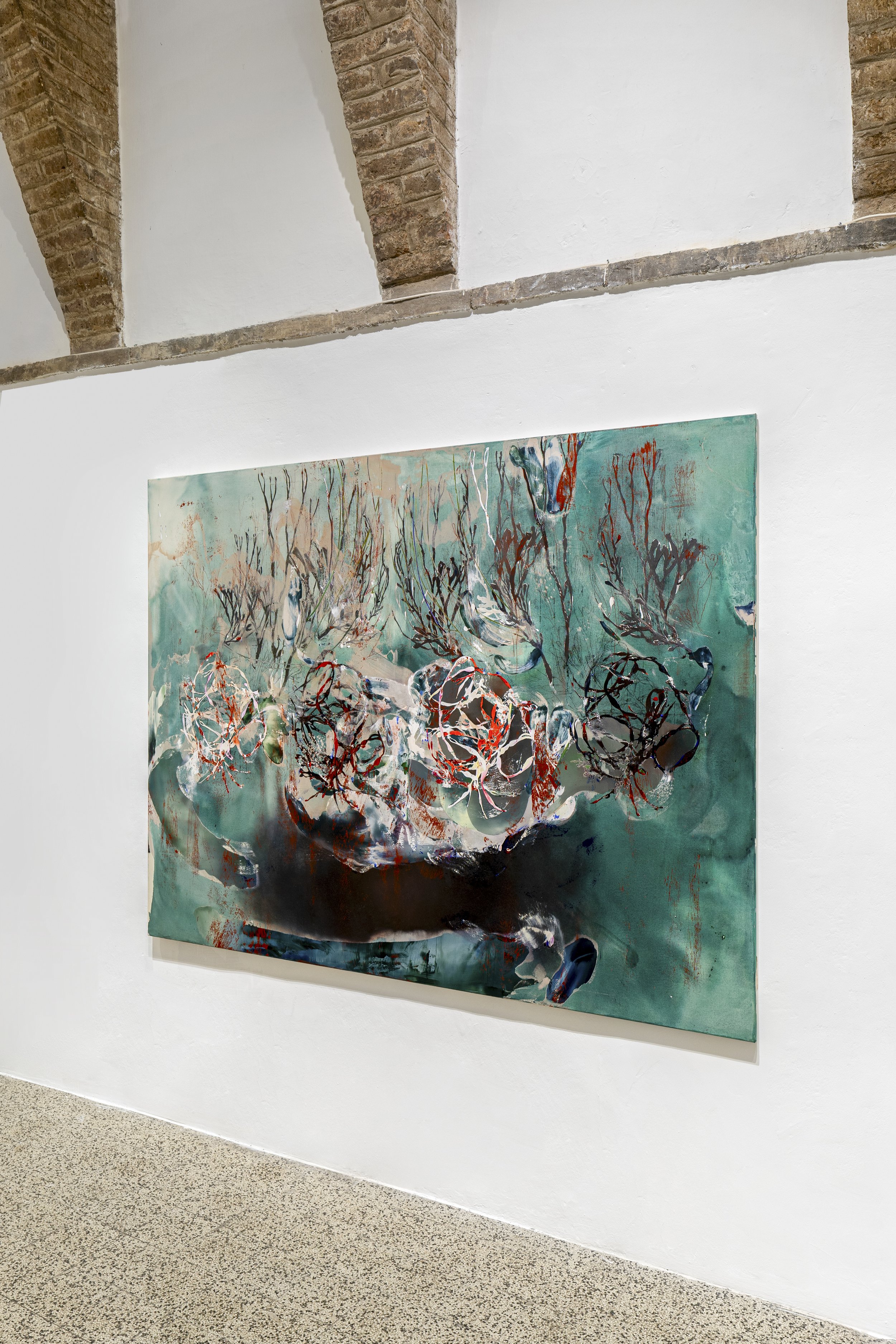
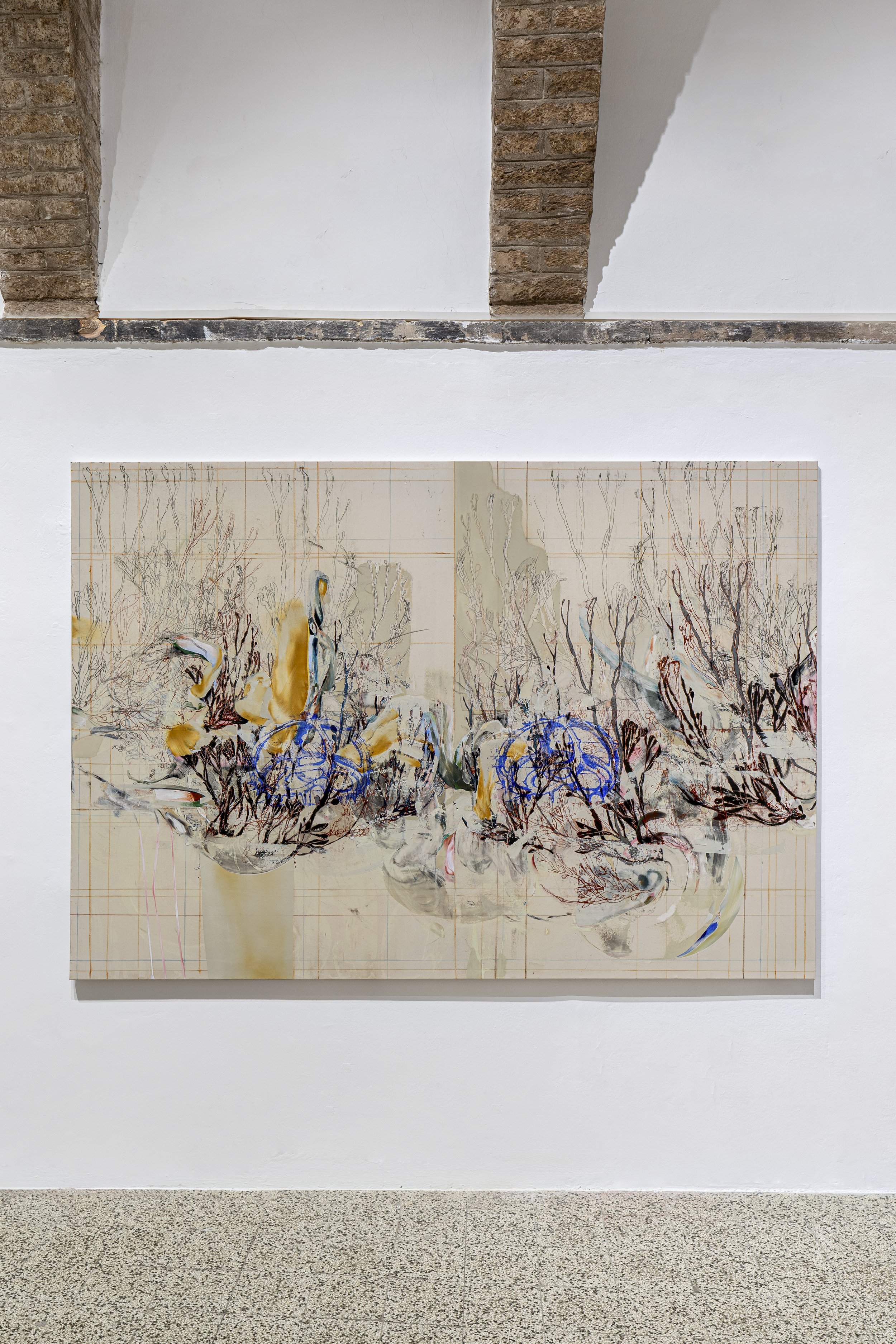
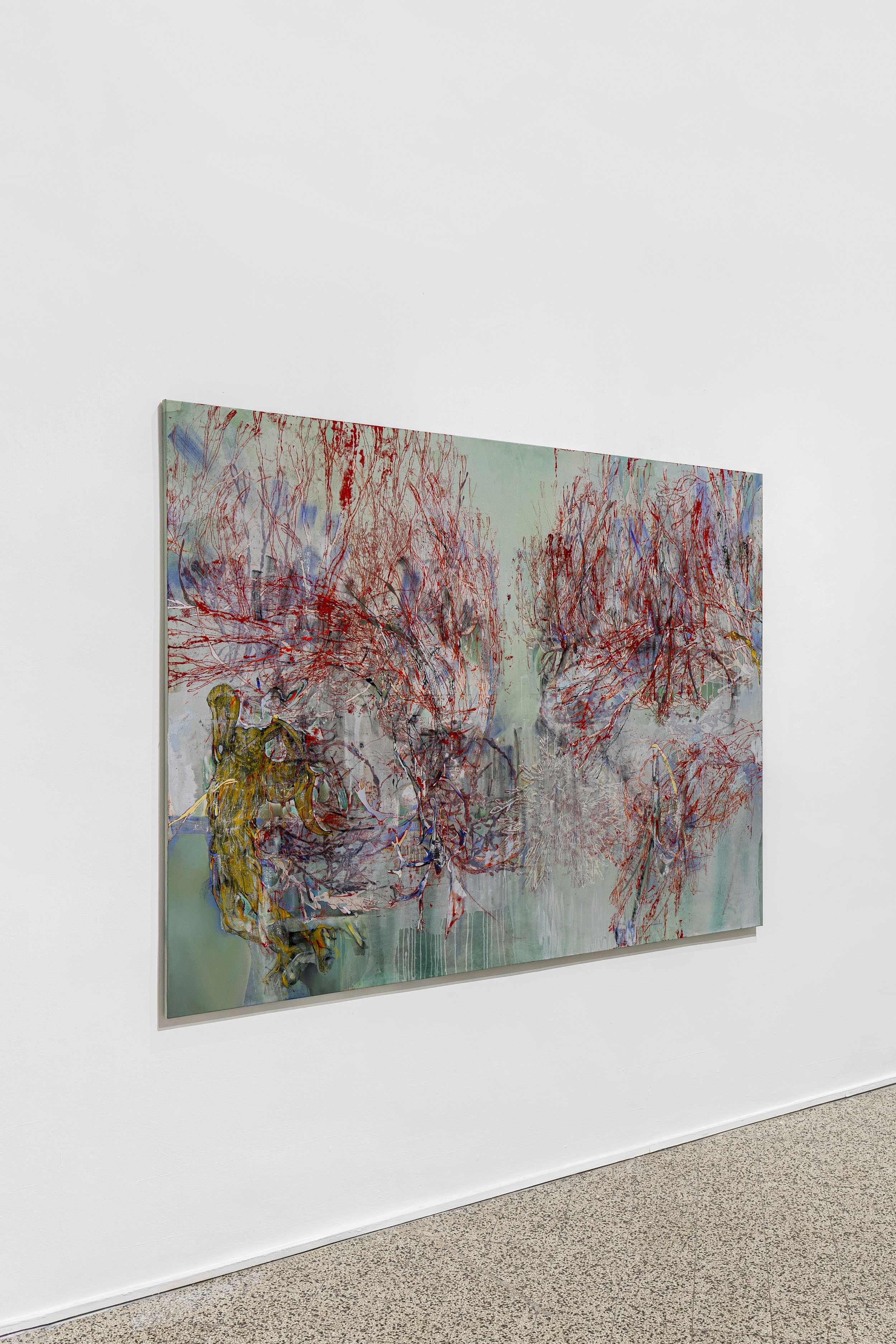
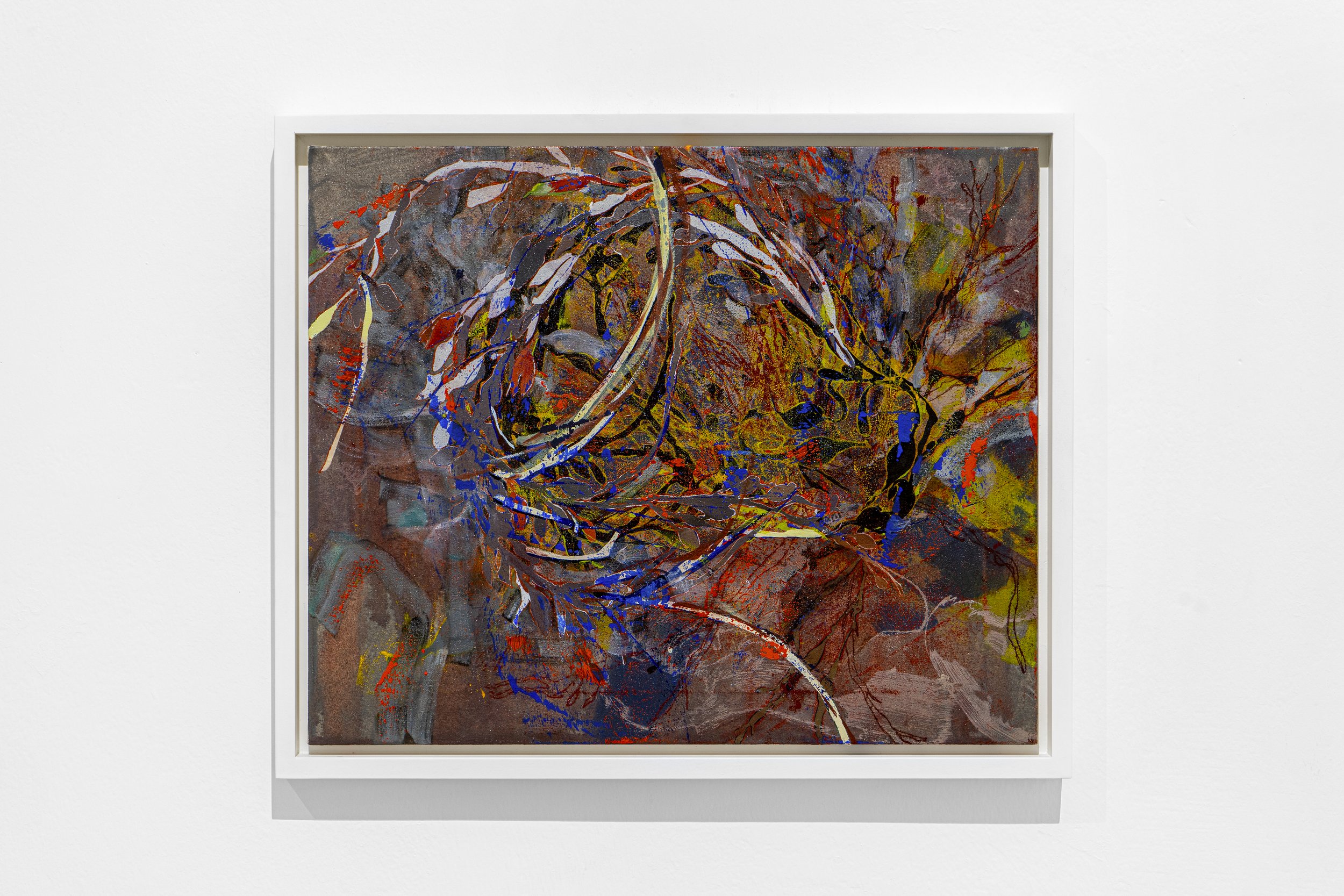
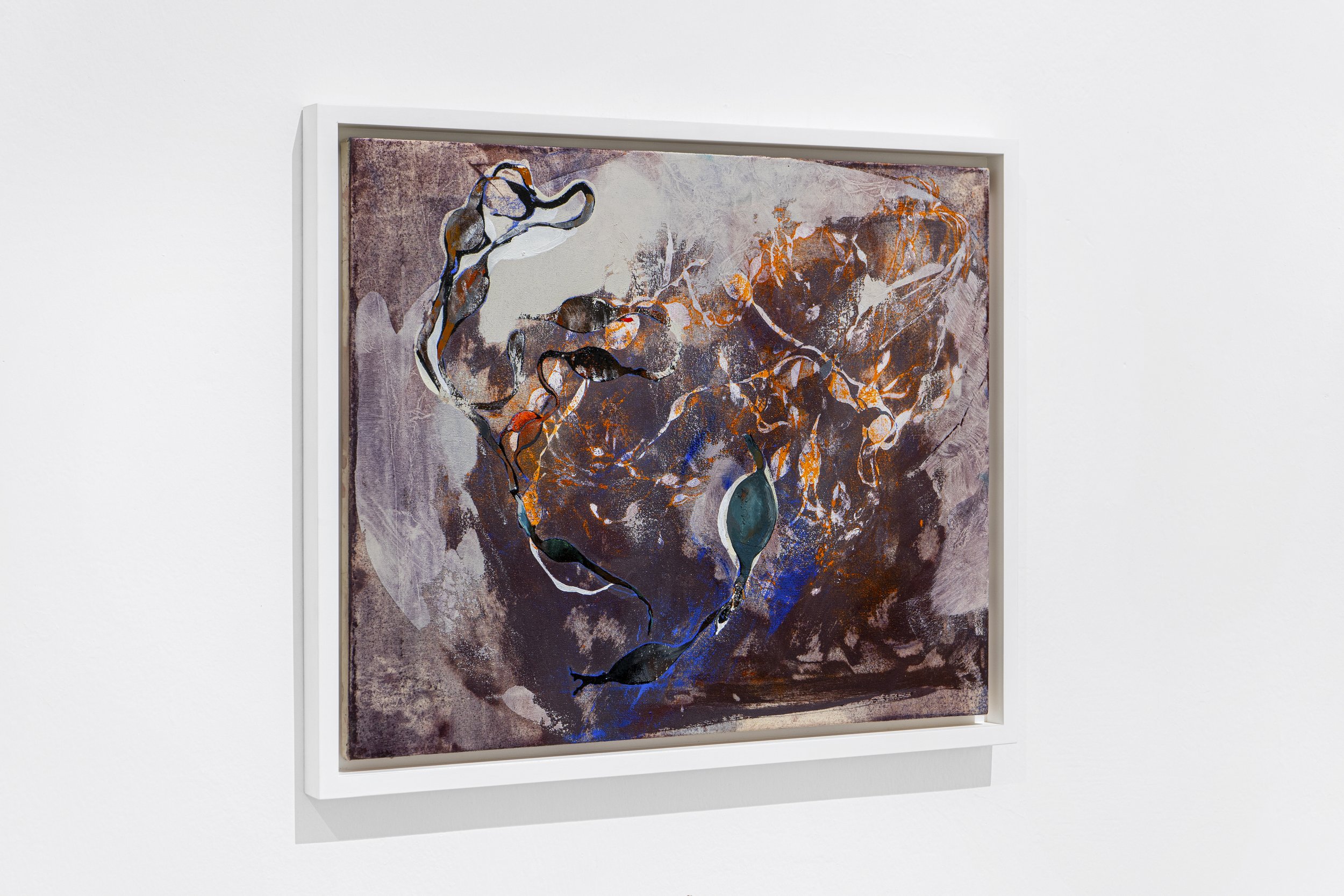
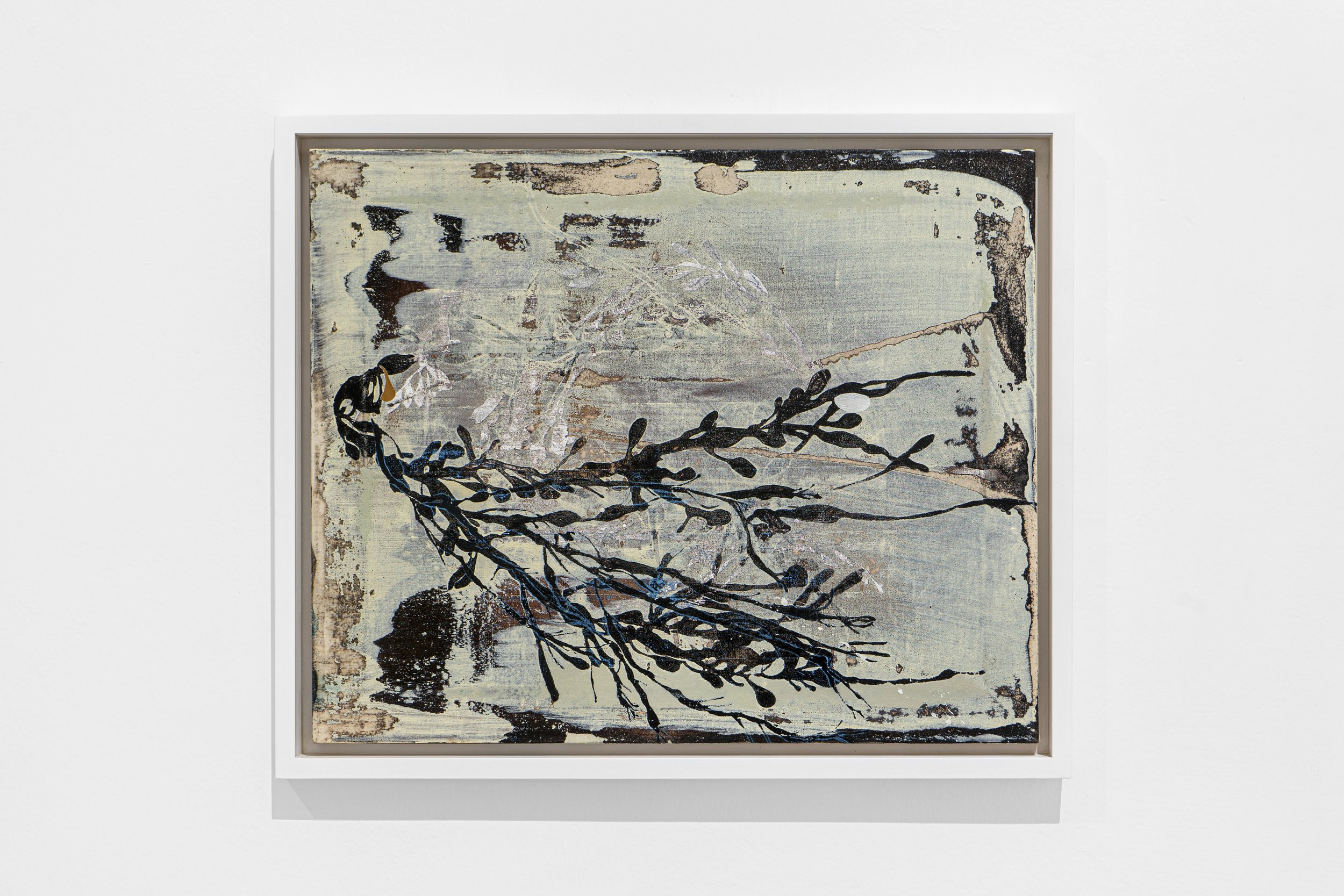
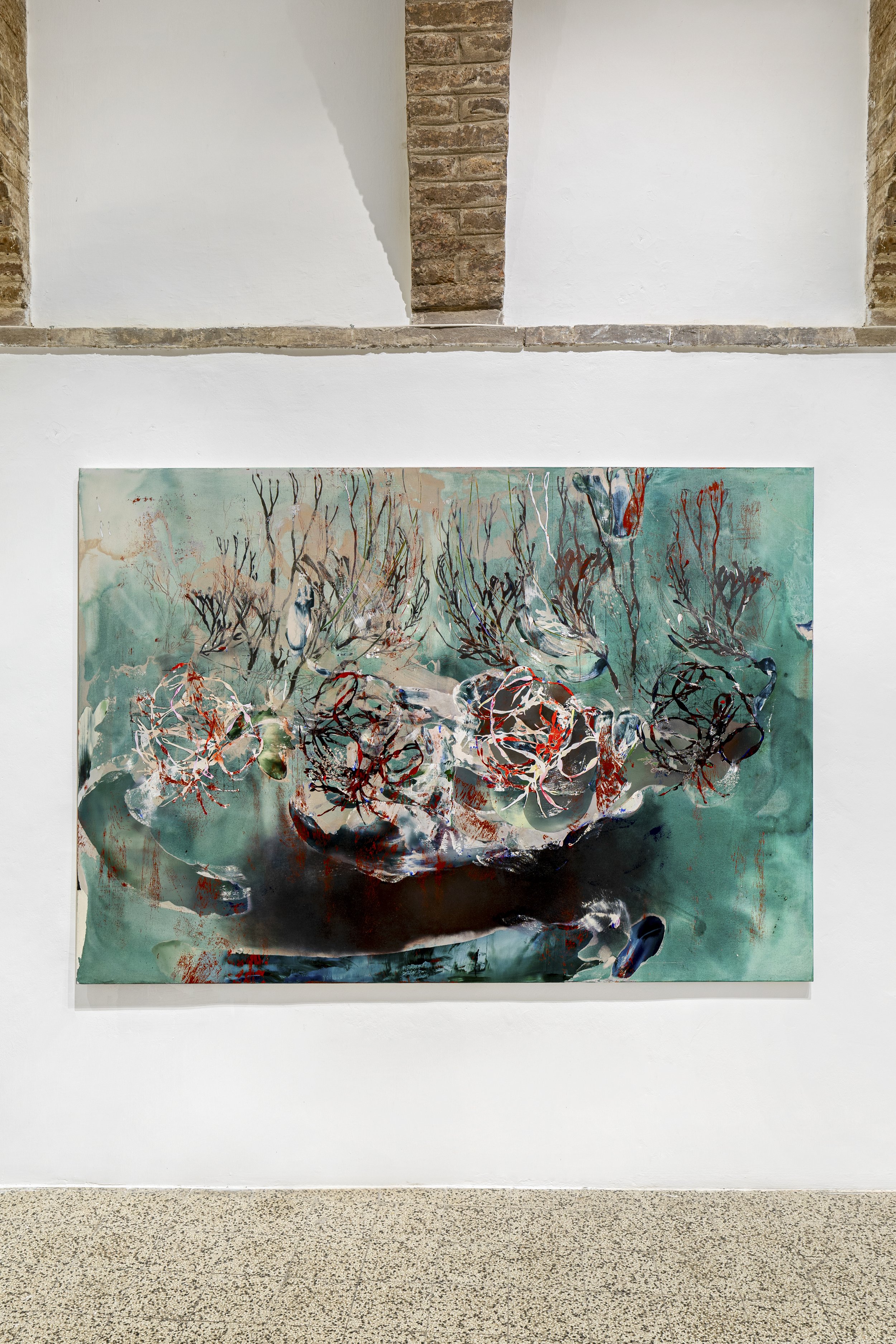
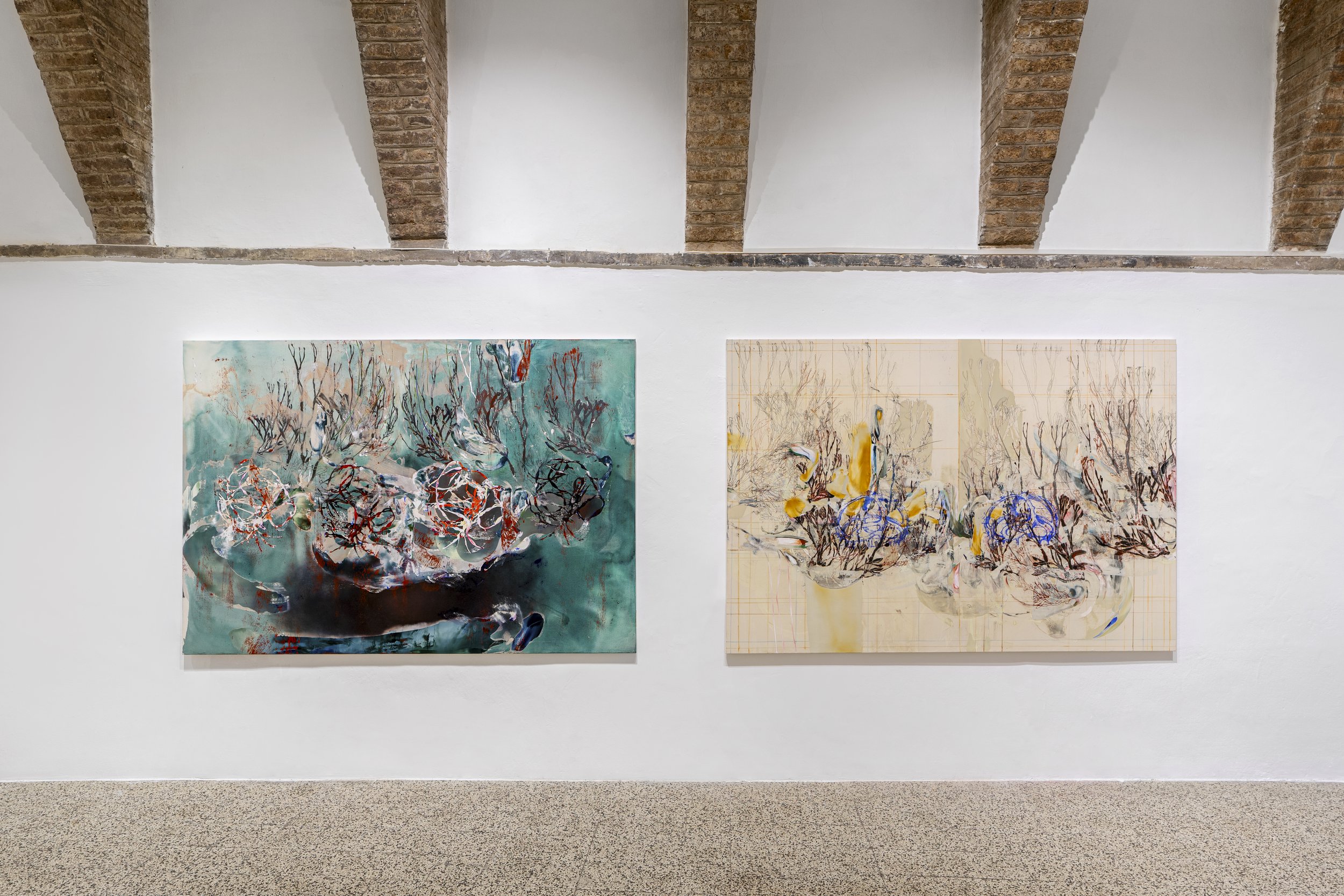
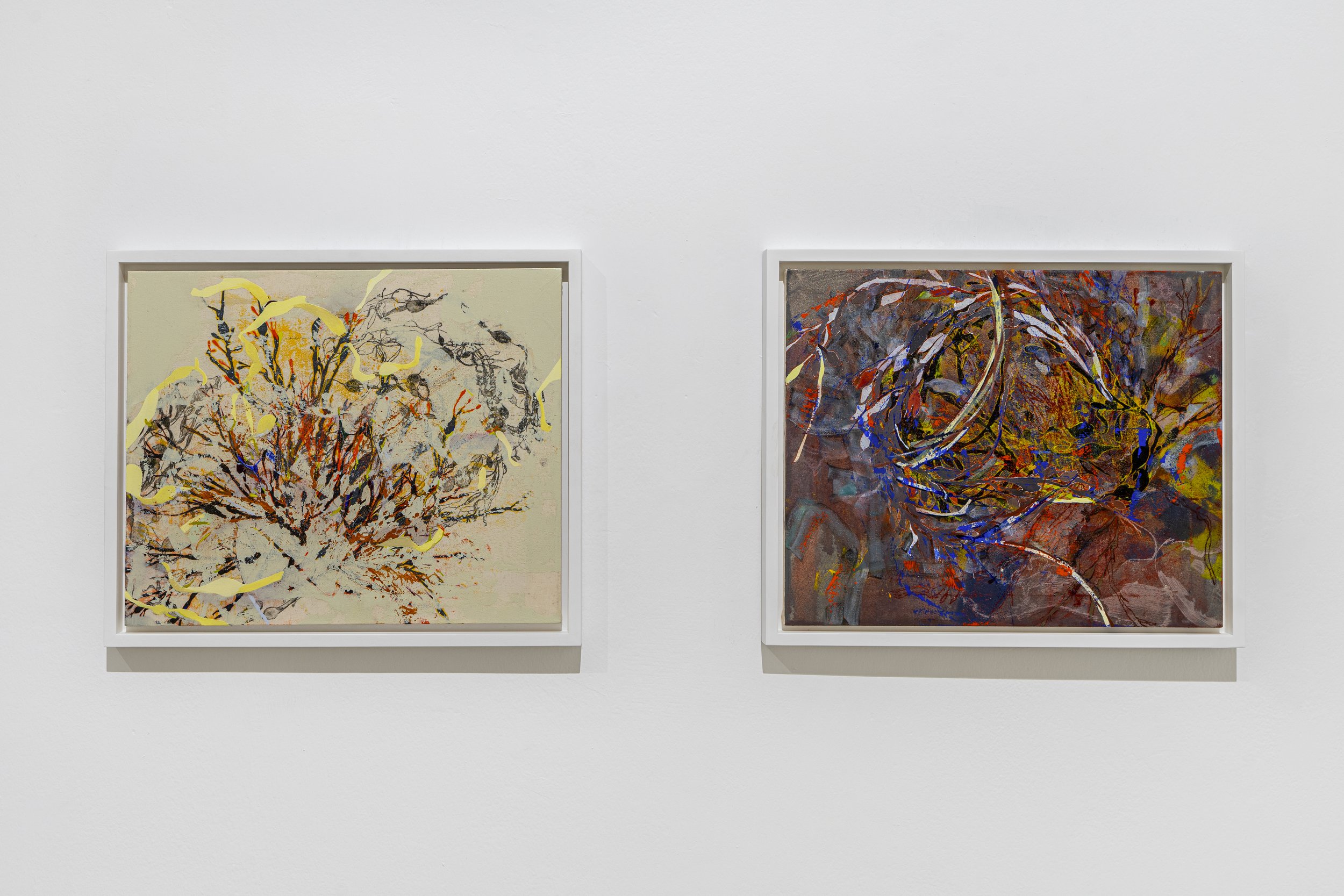
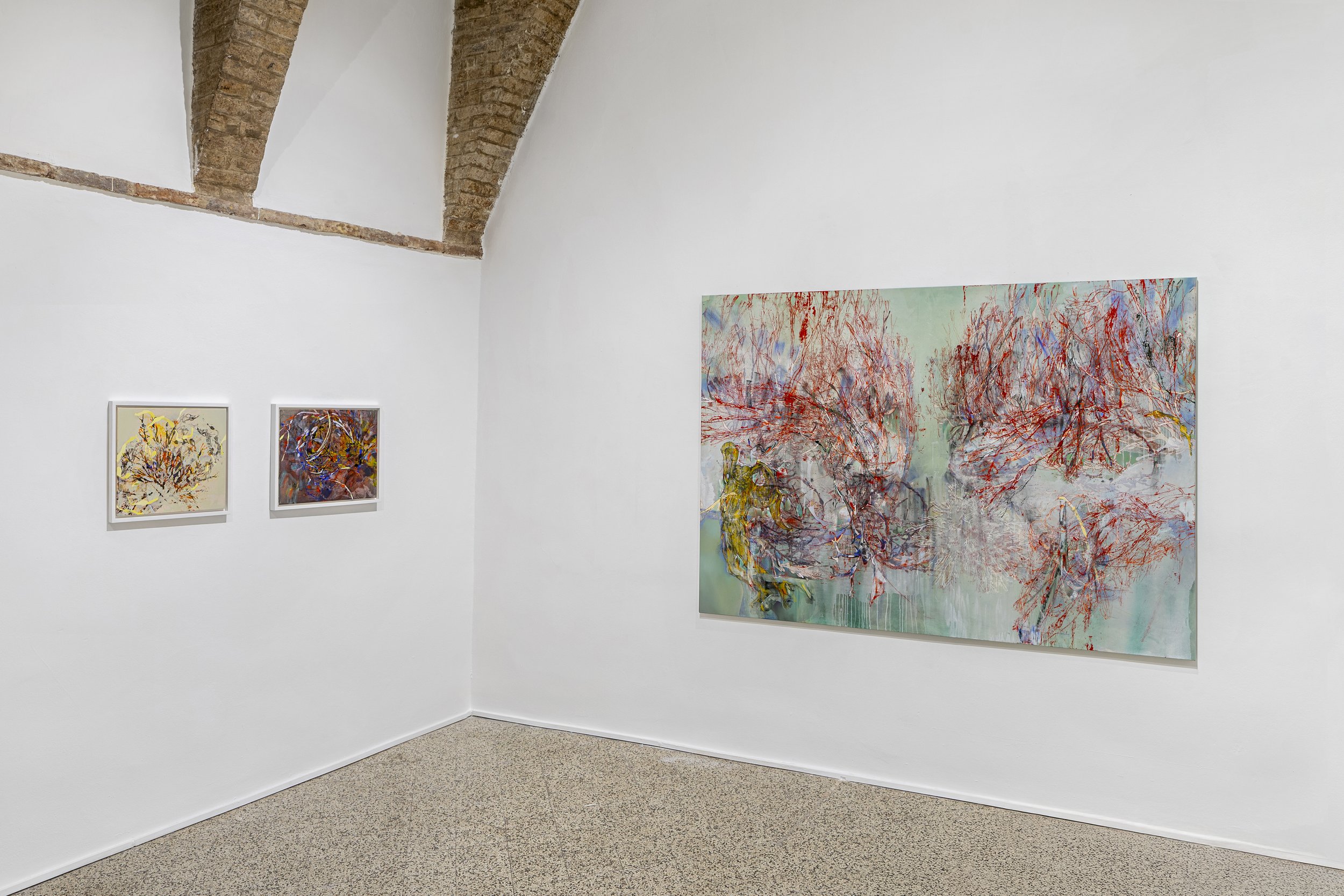
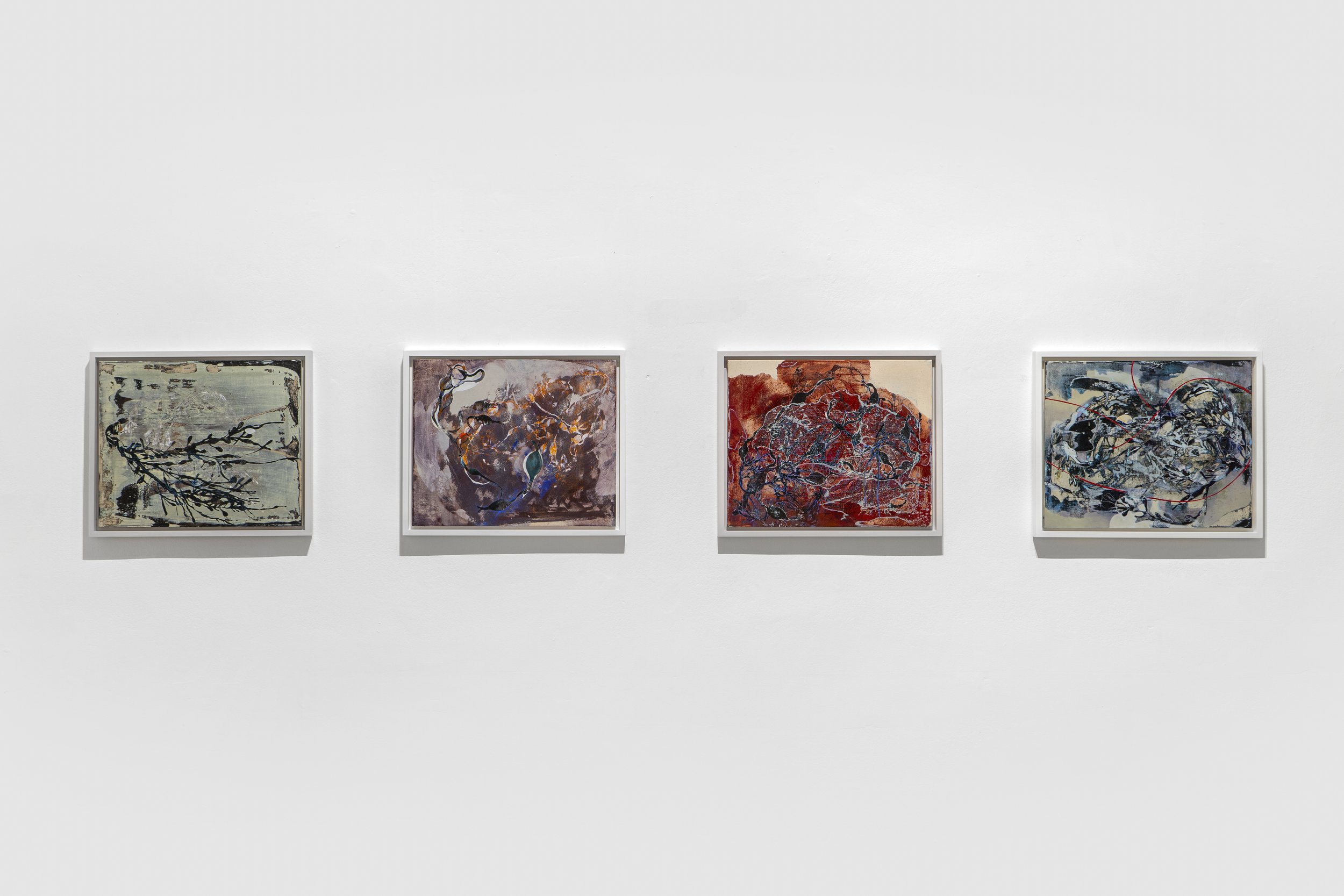
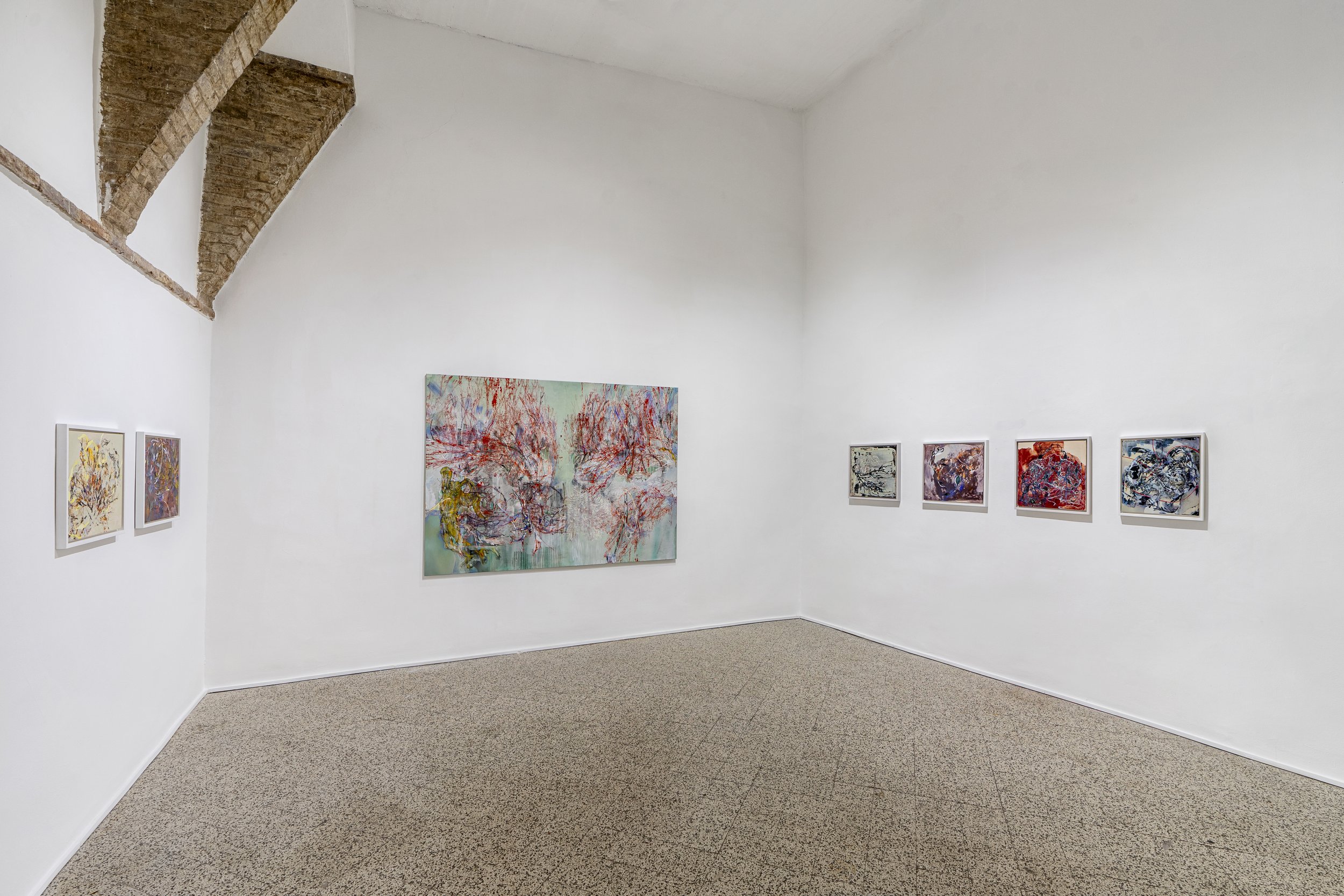
Installation view: Marta Spagnoli. “Fantasmata,” Galleria Continua San Gimignano 2025 Courtesy of the artist and Galleria Continua Courtesy: the artist and GALLERIA CONTINUA, Photographer: Ela Bialkowska, OKNO Studio
In the work Fantasmata II, a grid emerges as a system of lanes. It not only suggests a structural interpretation of the image but also defines a space where movement can be organized and managed, while simultaneously being interrupted or distorted.
Marta Spagnoli Fantasmata I 2024 acrylic and oil on canvas 160 x 230 cm 62.99 x 90.55 in Courtesy: the artist and GALLERIA CONTINUA Photographer: Ela Bialkowska, OKNO Studio
The works never fully submit to order or structure; there is always room for the accidental and the unexpected. Erratic elements such as a yellow devil, clawed creatures, or a milky veil of liquid paint poured onto the canvas act as agents of cohesion or disruption. These elements create an experience that oscillates between form and formlessness, figure and disfiguration. Their sudden and surprising appearances serve as witnesses to the choreography unfolding within the work, revealing the canvas itself as a field of forces, trajectories, movements, and complex relational entanglements.
For more information about this exhibition and others at the Galleria Continua, please visit their site here. The magazine also did an interview with the artist, which can be found here.






















